How to Create an Effective Business Proposal Presentation: Top Tips for Success
Creating an engaging business proposal and presenting it in front of your potential clients might sound like a difficult task. Knowing what to focus on, how to organize the meeting and shape your approach shouldn’t stress you out.
With our comprehensive guide, you’ll see how easy it can be to create a winning proposal. We’ll also give you tips on how to build confidence in your presenting skills and nail every public speaking event, be it around your proposal or not.
In this article, we’ll cover the proposal presentation creation process, how to best automate it and give you other tips on how to engage your audience.

Create a great business proposal
Whatever your topic may be, the starting process is the same - research. You need to conduct thorough research into your topic, and your audience as well.
The questions you need answered are:
- What problem are your clients facing?
- What are your client’s goals?
- How would they like you to go about helping them achieve those goals?
- Have your clients ever worked with any of your competitors before?
- How much budget can they allocate for this project?
- When do they expect to see results?
Once you conduct your research, you can start creating a proposal presentation. In order to speed up your proposal creation process, you’ll want to look into automation software.
Better Proposals offers a variety of prewritten proposal templates that you can easily customize to your needs. This means that you won’t have to create your presentation from scratch.

With our beautifully designed templates, you’ll have no problem showing your solution and the benefits you’ll bring to your clients in a way that’s easy to understand for everyone.
How to structure your presentation
Start with a short introduction. The point of your presentation introduction is to ease your clients in by explaining to them that you’ve listened and understood their issues. They will want to hear about your process and how you’ll help them achieve their goals so make sure you’re not talking too much about yourself and your company.
Once you’ve created your introduction, it’s time to focus on your process and timescales . This is the time to go into further detail and explain exactly which steps you’re going to take in order to help your client. However, make sure that you’re keeping it easy to understand.
Your clients won’t have the same technical knowledge as you do, so make sure to explain everything in simple terms. As important as it is to talk about your process, it’s even more important to showcase the benefits.
That’s how you sell your services - by talking about tangle results. If you’re providing website building, explain how it will lead to increased sales and market share.
If you’re working with a team, make sure to explain what each member will be working on a week to week basis.
Once you’ve presented your solution, it’s time to get to the price. If you already know your client’s budget, it will be easy for you to come up with a number. But that’s not all, the way you present your price is also very important.
Make sure you’re not using the word price and try using words like investment and ROI instead. It will make your proposal stand out and won’t cheapen your offer. Moreover, it’s important to present your price as a single number.
If you present a few different tiered price points, it will confuse your clients. They won’t know which package to choose, since they are looking to you to explain which steps are needed in order to help them achieve their goals.
Don’t use your presentation to try and upsell your clients. That should be done once you’ve created a relationship with them and created some results with your solution.
Add a great case study
Once you’ve presented your solution and price, it might be a good idea to quickly present a few case studies. They will show how you helped a client in a similar position before. It will be a good way to win over the audience, especially if you think you’ve lost them after presenting your price.
A third-party’s quote about your company will build your credibility. Furthermore, it gives you the opportunity to present the benefits your clients experienced from working with you, as well as how quickly they reached ROI.

Better Proposals’ templates come with a prewrite structure for case studies. We know what the clients want to see and hear, which is why we make sure to provide a visually pleasing layout.
There is no need to go into detail on how much trouble your client was in before they started working with you. Nor should you talk about the process employed to help them achieve results. In most cases, this will be similar to the process you’ve already presented to the client, so don’t repeat yourself.
Instead, focus on the results. By this we mean:
- The benefits the client experienced since working with you . Explain a few details - do they have more time now, have they managed to focus on other parts of their business and more?
- What short and long term goals did you help them achieve?
- When did they achieve ROI ?
- A quote from the previous client.
Case studies are a powerful strategy that can help you win deals and secure more revenue.
How to end your proposal presentation
After that, make sure to outline the next steps as well as present your guarantee and terms and conditions.
It might sound silly, but including a clear call to action is very important. Since you’ve already created a great proposal presentation, it would be a shame not to state what needs to happen next.
Does your client need to send any materials, do they need to pay the first fee, is there a need for a team meeting?
Whatever needs to be done, lay it out in order to make it easy for everyone to understand.
In the guarantee section, present what you could offer the client if anything goes wrong. A popular example would be to promise a free product or service if you don’t provide them with a finished product in the agreed-upon time frame.
Personalize your proposal for the specific audience
While you’re creating your proposal presentation, you need to keep in mind who your audience is. You need to know their needs, wants, lifestyles and behaviour. However, not only do you need to know your audience , but their audience as well.
Who are they selling their products and services to? Firstly, distinguish between a B2B, B2C and a combination of those two types of companies. After that look for any reports that focus on their industry. If you’re selling medical equipment, find out all you can about hospitals, private clinics and any upcoming trends in the market. In addition, identify your competitors and analyze their technological stack using the technographic data insights .
You need to be able to confidently present your proposal and that confidence will come from the amount of research you conduct.
Analyze the previous efforts your client’s company has made in order to solve the problem. If you could explain to them why it didn’t work, it would further demonstrate your expertise and that you’re the perfect person for the job.
When using Better Proposals, you can make sure you’ll never address your clients by the wrong name. With our custom merge tags , you can name your clients, their company and brand and automatically personalize your proposals.
That way, even if you’re recycling your proposal presentations, you can rest assured knowing you didn’t leave the names of your previous clients.
Send out the proposal before the presentation
It’s a good idea to send out your presentation before the meeting.
There are three reasons for that:
- It will give your clients enough information to think about any questions they might have.
- You can utilize proposal analytics to see exactly what your clients are interested in and shape your approach accordingly.
- If your clients agree to your terms, they can sign them then and there using the digital signature option.
Better Proposals offers a great feature called proposal analytics. They show you when your proposals were opened, by who, if they were forwarded, signed and paid.

You will also receive notifications via email for every action your client takes. Moreover, you’ll know exactly how much time did they spend on each of the chapters.

This type of insight will help you understand which parts of your presentation to focus more on in the meeting. Did your client jump straight to the price or did they read every section? Once you analyze their actions, you’ll have a different perspective on your presentation.
Focus on the problem you’re solving, not your offer
Don’t underestimate the power of benefits and value you can bring to your clients. That’s what they’re most interested in. We know that it’s tempting to focus on your offer and go into great detail about how you’re the best person for the job based on your price, approach, quality of work and more.
As important as that is, make sure your primary focus is on the problem you’re going to solve and the benefits you’ll bring them.
Your clients won’t be that interested in your features and other technical details. They want to hear what their future will look like if they start a business relationship with you. For example, if you’re selling a meal prep kit, it would make more sense to highlight benefits like - freeing up time in your customers' days, offering a variety of meal plans and more.

Talking about the technical aspects of your business would only be interesting to potential investors or employees. That's why it’s important to focus on the value you’re bringing to the client.
Arrive early in a neutral setting
The last tip we have for you is to meet the client in a neutral setting. Most of the time the client will want you to come to their office. Even though you’d want to accommodate your clients, meeting them in their office might be detrimental to your deal.
Their office is a place with a lot of distractions. Anyone can walk in and ask for input on their own work, there are deliveries going on and the phones ringing off the hook. Offices are not known as quiet places and that is why you’d want to move the meeting to a more neutral setting.
Our advice is to choose a hotel lobby. They are usually quiet during the workday, making them the perfect setting for a business meeting.
It’s also important to come early. That way you can choose the perfect table, order a drink (nothing alcoholic though) and relax. If you get nervous about presenting, arriving early will help you set up and focus.
Further tips we have for anyone presenting are:
- Rehearse your presentation in front of your colleagues.
- Plan out your pauses and the points you’ll highlight.
- Make sure to connect with your audience, don’t just look at your materials.
- Think about the possible questions they can ask you in advance so that you can prepare answers.
If you win a deal right after the presentation, you’re already in the right place to celebrate. Once everything is done, you can seal the deal with a drink or two.
The first rule of presentations is - to prepare. The more time and effort you put into your presentation, the more confidence you’ll have in your presenting skills. With our actionable guide, you’ll quickly be able to create a beautifully designed presentation that will help you win the deal.
Make sure you start any proposal presentation with thorough research into your potential clients. You’ll have to know the answers to all your questions about the way you would implement your solution before you start writing the proposal.
If you use Better Proposals, you’ll love how quickly and easily you can create a document that is easy to get through and engaging. Sign up for a free trial today and find out for yourself how much our platform can help you in the proposal process.
Are your sales docs more awkward than small talk?

Every Document Is a Proposal
Whether it's a new employee or a new client, your documents say a lot about your business. If you don't see every document as a proposal, you're missing the point.
Using Word to Create Proposals Makes You Look Fucking Pathetic
Think about the impression you're trying to give off and then ditch Word proposals for good. They make you look pathetic.
Unsupported browser
This site was designed for modern browsers and tested with Internet Explorer version 10 and later.
It may not look or work correctly on your browser.
- Presentations
How to Make Business Proposal Presentations in PowerPoint (+ Video)
Winning a potential client is a challenge. You need to present your solution in a compelling manner. A business proposal presentation template can help.

Do you need to impress a client to close a deal?
Everything begins with a good business proposal presentation. Maybe you're trying to sell your products or services to a prospective client. Or you might be proposing a new venture internally. Either way, knowing how to make a business proposal that stands out will help your leg up on the competition.
In this guide, we’ve outlined some valuable tips for business proposal presentations . We’ve also lined up some creative business proposal PowerPoint templates to make you feel inspired and get you started. Finally, you'll learn how to make a proposal presentation with PowerPoint.
How to Quickly Make Business Proposal Presentations in PowerPoint With Templates
Are you interested in learning how to use PowerPoint to make business proposals? Watch this quick screencast to learn all about creating proposals with PowerPoint:

Or study the complete written tutorial below.
Jump to content in this section:
Why Make a Business Proposal PowerPoint Presentation?
How to create a winning business proposal, thousands of business proposal powerpoint templates on envato elements, how to make great business proposal presentations in powerpoint quickly, 5 top business proposal powerpoint ppt presentation templates.
- More Awesome PowerPoint Templates
5 Quick Business Proposal PowerPoint Slide Design Trends for 2023
Common powerpoint questions answered (faq), learn more about making great powerpoint presentations.
A business proposal is any business offer document sent to a prospective client. Its main goal is to persuade an organization to buy your product or service over your competitors. This is why a business proposal can make or break a deal.
Usually, a proposal can be solicited or unsolicited:
- A solicited business proposal is sent to clients who have asked for a solution.
- Unsolicited proposals are more like sales documents. They offer your solutions to potential clients without them requesting a proposal.
Here’s a sample business proposal PowerPoint presentation. It comes with a clean and modern design. It's both informative and visually appealing.

A business proposal PowerPoint presentation is highly recommended because of its visual narrative. But proposal presentations don't have to be overly formal.
In fact, making a business proposal PPT presentation is complementary to that. It'll help you convince potential clients even more.
The quality of your proposal presentation affects your chances of closing a deal. Poorly designed business proposal PowerPoint presentation are simply less persuasive.
If you want to know how to make a business proposal presentation that captivates your audience, we've got you covered. Here's a guide with tips and inspiration to craft the perfect proposal presentation.
1. Study the Clients and State Their Needs
Before doing any business proposal, it’s crucial to do your homework first by knowing who your potential client is. You need a complete picture of your clients. That includes how they operate and what their business needs are. Without these, it's hard to deliver a proper business proposal presentation.
The first step is to conduct client research to develop a more detailed idea of their needs and how your services or products will satisfy them. Here are some tips to study your clients:
- Visit their website.
- Look at their social media accounts.
- Know their history, core values, etc.
- Understand their target market.
- Identify their problems.
- Check out their competitors.
Use the research to adapt your business proposal PowerPoint presentation. The tone of your contents and design elements should adapt according to your clients. Your clients will appreciate this research when they see the business proposal presentation.

2. Show How You Can Solve the Problem
What are you bringing to the table? How do you plan to solve their problems? Why should they choose your solutions over others?
Take what you’ve learned from client research and put it into your proposal presentation. The best way to show how you can solve their problem is by telling them exactly what they're in for through the first two slides.
Summarize your solution in a brief and concise manner from the very beginning. Let them know what certain aspects of your solution will help them achieve their business goals. This will keep your clients engaged with the rest of your business proposal presentation.

3. Follow a Seamless Structure
A business proposal structure will sketch how your presentation will run. Having a robust and seamless structure will help you navigate your presentation much easier. This will also prevent you from missing some important messages and so that your thoughts won’t get easily rambled.
There’s no right or wrong structure to your presentation proposal. It actually depends on how you want to tell your message across your potential clients. Here are some common elements requested in a business proposal:
- title/cover page
- executive summary
- statement of problem, issue, or job at hand
- strategy or approach to solving the problem
- company services and qualifications
- cost, payment, and any legal matters

4. Use Compelling Visuals
Instead of writing a lengthy paragraph or text-loaded slides, break down your ideas into simple words or phrases. Then, accompany your business proposal PowerPoint slides with impactful images. Photography is a powerful tool to enhance any dull slides and deliver more striking messages.
As much as possible, just keep one photo for each slide or for each point you want to relay. Too many images can also be distracting. Remember, images are just supporting materials to your main content. They act as attention-grabbing elements and will keep your contents more memorable.

5. Adopt a Consistent Color Palette
Color immediately tells you about your brand and distinguishes you from competitors. It's ideal to use your branding colors. If in case, you only have one color to use, create a color palette of at least three colors to work with. It should be complementary to your brand and must be consistent throughout the presentation.
If you’re unsure which color palette to use, Coolors can help you explore and generate the right color combinations. Although, most business proposal PowerPoint templates already have a built-in color palette that you can use. The key is to align it to your brand’s main color. Thankfully, it'll be easy to do in your PowerPoint proposal template.

6. Be Mindful of Contrasts
Contrast is a crucial design element when learning how to make a business proposal PowerPoint presentation. It plays a vital role in text legibility. There are certain colors that don’t contrast well like pink on the background and yellow for the text. Ensure that you've got enough contrast between the background color and the opposing text color.
Text legibility is also a priority when using an image as a background. A pro tip is to add a black overlay on your text with 50% transparency. This will cast a shadow on your text, becoming much easier to read. There are many proposal presentation examples with great contrast you can use as inspiration.

7. Allow White Space
It’s fun to include different design elements into your business proposal presentation. These typically make the content more attractive and compelling. But you also need to give some room for your business proposal PPT to breath.
Presentation proposal designs are effective when they're used at a minimum. Overdoing it will just make your business proposal PPT to get cluttered and harder to digest. Adding some white spaces or negative spaces into your presentation is a good aesthetic composition.
Line breaks add more white space, which gives readers’ eyes a break before going to important messages. This allows them to absorb the information better. To add more white spaces, use numbered lists and bullet points to your slides.

8. Prepare Proper Typography
How you visually deliver your content in your PowerPoint proposal template will also matter. This is where typography becomes a crucial element on how to make a business proposal. You should establish a typographic hierarchy that'll help you organize your content better. For example, you should have various font size and font family rules for headings, subheadings, body copy, etc.
This will help you differentiate certain ideas and body of thoughts easily. If all your contents have the same font family and size, this will easily ramble the messages that you want to relay. With hierarchy, your contents are quicker to scan and read.

9. Apply Varied Slide Layouts
Variety of slide layouts is also important on a business proposal PowerPoint template. Having just one slide layout across your presentation will make it dull and boring. Make sure to excite your audience by using varied slide layouts for different ideas or sections.

10. Overcome Text Overload With Iconography
The best business proposal PPT designs are visual. That means you'll need the amount of text in the business proposal document. A business proposal PowerPoint should be your guide when presenting and not a fully written document.
The use of iconography will help you lessen the number of texts in your PowerPoint. This will also help you relay your ideas much faster. Remember to align the icons to your brand and they should all be uniform in style.
11. End With a Winning Call to Action
Lastly, close your business proposal presentation with a compelling call to action. You’re proposing because you want your audience to take specific actions at the end of the presentation.
With this, make sure that your audience knows what to do next. As much as possible, keep your call to action direct to the point and clear enough to comprehend. Don’t forget to set timelines and expectations for follow-ups.

If you're creating business proposals quite often you should consider Envato Elements. It's a one stop shop for all your creative needs. Access thousands of business proposal presentation examples, images, graphics and all sorts of design assets for a low monthly fee.
Sign up for Envato Elements and get instant access to a library of over million digital assets. That includes top modern business proposal presentation examples.
Envato Elements is a great choice if you need design assets on a regular basis.
Business proposal PPT presentation designs will impress in 2023. The advantage of premium templates is their ease of use.
In moments, you can see how to make business research proposal presentation designs. Let’s learn how, in just five quick steps.
Planning to follow along? Head over to Envato Elements and download the stunning Business Proposal template set today!

1. Select Slides
If there’s a single key factor in any successful business proposal presentation, it’s brevity. Talk too long and you’ll lose your audience, and along with them, any chance of success with your proposal. This means it’s important to select only the slides that most benefit you.

To do so, go to View > Slide Sorter on PowerPoint’s ribbon. This shows a series of thumbnails for each slide in the deck. You can press Delete on your keyboard to remove any unwanted slides that you have selected.
Plus, you can click and drag the thumbnails to reorder the slides. This is how to make proposal presentation designs from Envato Elements work for you.
Finished? Back on the View tab, click on Normal. You’ll be ready to edit right away!
2. Add Custom Text
A proposal presentation, by definition, will be full of words. These explain your proposal in detail and communicate it to your audience.
Premium templates like this make it easy to customize this text. Notice as you work on a slide like slide 1 here that there's already text on the slide.

This text, though, is simply a placeholder. To add your own words, click on the placeholder text box until you've got the contents selected.
Start typing on your keyboard. PowerPoint adds your content into the existing text boxes. This saves you time by avoiding the need to construct sleek slide layouts from scratch. Repeat throughout your slide deck as needed.
3. Make Unique Text Effects
It’s easy to think that proposal presentation templates are static in their styling. But that just isn’t so. For example, you can add text effects to any of the words that you place on your slides. To do that, first ensure that the text is selected.

Then, go to the Home tab on PowerPoint’s ribbon. Just left of center, you’ll see the Font section. From the dropdowns, you can change things like the font size and style. Or you can click the adjacent buttons to highlight text or make it bold or italicized.
4. Change the Color Palette
Slides like slide #4 here have cool shapes in a modern color palette. But you aren’t required to use these same colors. In fact, color changes are how to do a proposal presentation that’s unique. For example, you can match your slides to your brand colors.

To do this, click on one of the shapes to select it. On the ribbon, open the Shape Format tab.
You’ll see several options here, and the one you’re looking for is Shape Fill . Open it up and choose one of the color thumbnails. PowerPoint automatically changes the color of the shape that you selected.
5. Add Images
Pictures: they’re how to make proposal presentation designs unique . To add photos here, click on one of the photo placeholders like the one on slide #4. Then, go to the Picture Format tab on the ribbon, and choose the Change Picture dropdown.

From here, click From a File. Browse to an image file stored on your computer and click to insert it. In this tutorial, we're using a warehouse image from Envato Elements.
PowerPoint will import the photo, sizing and scaling it to fit in the placeholder. It’s a very easy way to build impressive proposal presentation slides in 2023.
Designing a beautiful and compelling business proposal PowerPoint can be tough. After all, we're not all graphic designers. Luckily, highly customizable business proposal presentation templates are a major help. Great business proposal designs have the blueprint already built for you.
What's the best way to learn how to make proposal presentations? Lean on the work of others. Here are five top business PowerPoint proposal templates that you can use or draw inspiration from:
1. PowerPoint Proposal Template

Proposal PowerPoint is a clean and scalable business proposal PowerPoint template. It has the striking colors and graphics that set it apart from the pack.
Suitable for: eCommerce, product promotions, enterprise accounts.
2. Minimal Business Proposal PowerPoint Template

Minimal Business Proposal PowerPoint is a creative and multipurpose template. It's minimalistic so that your business proposal isn't a distraction from the content inside it.
Suitable for: Fashion, design, and IT industries.
3. Research Proposal Presentation Template

Project Proposal PowerPoint Template is makes a data-driven presentation visually appealing. Its design is simple yet highly effective, making it a top research proposal presentation.
Suitable for: In-house special projects, small and medium businesses.
4. Business Proposal PowerPoint Template

Business Proposal PowerPoint Template has grand and bold designs to help your proposals stand out.
Suitable for: All types of industries, small or large enterprises.
5. Pro Business Presentation Proposal Template

Pro Business Proposal Template - (PPT) is intended for traditional style seekers. It's got a good balance of professional and modern designs. Try it if you have plenty of pictures you want to add to your presentation proposal.
Suitable for: Companies with traditional style but also want to amp up their game.

More Awesome PowerPoint Templates
The above is just a small selection of awesome and modern proposal presentation examples. To see even more great PowerPoint templates, check out these posts:

To make sure your presentation looks modern and professional, it pays to know the current PowerPoint slide design trends. Here are five quick business proposal slide design trends to make use of in 2023:
1. Create an Impactful Cover
Your proposal cover is a great way to pique the interest of your audience and give them a quick taste of your brand. Make an impactful proposal cover by including a photo of your business or your team. Or choose another eye-catching image.

2. Go Dark Mode
Odds are you or someone you know prefers dark mode to the default look of your phone or favorite app. Applying this trend to your presentation proposal lets you create a look that works for those members of your audience. It's also a nice break from traditional white backgrounds.
3. Infographics and Charts Are Best for Presenting Data
Use plenty of infographics, charts, and other visual elements to present the data in your proposal. This will make it easier for your audience to visualize abstract ideas and make them more engaged with the proposal.

4. Go Vertical
Consider using a vertical layout for your business proposal. Since most proposals are in horizontal format, this is a good way for yours to stand out. Check out Envato Elements for vertical PowerPoint proposal templates.
5. Enter the Third Dimension
Don't forget about 3D characters when customizing your PowerPoint presentation proposal template. Using 3D models is one of the hottest presentation trends in 2023. They add another layer to your work and makes your business more personable.

So, you’ve decided to build a business research proposal presentation in PowerPoint. But you may still have a few questions. When you think of how to do a proposal presentation, it always pays to know how PowerPoint can work for you. Here, we’ve answered five common PowerPoint questions:
1. How Do I Get Design Ideas in PowerPoint?
PowerPoint business proposal presentations lean on creative design ideas. The best way to get these ideas is through the use of premium templates from Envato Elements .
These templates have two key advantages:
- They provide design ideas.
- They save you time.
The pre-built layouts take the hard work out of the design process. Instead of beginning from scratch, you can take a layout and drop in your own content in seconds.
Learn more about PPT design ideas in our tutorial:

2. Can I Animate PowerPoint Slides Easily?
Yes! Animations prove how to do a proposal presentation that'll impress any audience. PowerPoint’s Animation tab gives you plenty of options.
Plus, Envato Elements PPT templates are often pre-animated. This saves you time, since the content you add will already be animated.
For a complete look at proposal presentation animation, check out our complete guide:

3. How Do I Make Better PowerPoint Slides?
It’s easy! PowerPoint slide designs that impress audiences aren’t difficult to build. But you need to remember a few basic rules:
- Keep slide topics short and to the point.
- Choose bold layouts and easy-to-read fonts.
- Illustrate with images, charts, and more.
Need to learn more? We've got a full PPT slide design tutorial for you:

4. What Are Infographics in PowerPoint?
Infographics are a hallmark of the best proposal presentation designs you’ll see in 2023. These are illustrations that combine information and graphics to present ideas in style.
If you need to know how to make proposal presentation designs that are sure to impress, infographics are the place to start. Find out more here:

5. Can I Share PowerPoint Presentations on Zoom?
Yes! In 2023, the ability to share proposal presentation decks online is very important. In just a few quick steps, you can prepare and share them on video-conferencing apps like Zoom. This is increasingly important in 2023 and helps set the stage for your success.
Read more on PowerPoint and Zoom here, to help share your next proposal presentation:

PowerPoint is a powerful program that allows you to create any type of presentation. There’s a lot to learn about making great PowerPoint presentations and we've got plenty of tutorials to help you:

Get Started on Your Next PowerPoint Business Proposal Presentation Now
Any good business proposal is accompanied by a powerful business proposal PowerPoint. If you want your message to be more impactful, ensure that you've got followed our above guide on how to make a business proposal presentation.
There’s a wide range of business proposal PowerPoint templates from Envato Elements. These serve as inspiration to help you get started.
But, above all, it won’t be as effective without understanding who your prospective client is. Know what your clients' needs are and how your solution could help them. These are the two key steps to help build compelling business proposal presentation.
Editorial Note: This post was originally published in June of 2019. It's been revised to make it current, accurate, and up to date by our staff—with special help from Brenda Barron , Andrew Childress , and Nathan Umoh . Video added by Andrew Childress .

8 Best Tips for Business Proposal Presentations [+Examples]
Updated: May 24, 2022
Published: February 16, 2022
Business proposal presentations are the culmination of a long sales process between you and your clients. If you don’t structure it correctly or take the time to craft one with care, you risk losing the client’s buy-in for your solution. So getting it right is essential.

In this article, we’ll look at several ways to improve your business proposal presentation (and pitch) and increase the odds that you’ll walk away with a new customer.

Business Proposal Presentation
A business proposal presentation is a document that outlines a business solution for a customer after a lengthy consultation process. It is presented to the customer in either PDF or PowerPoint format, and can be paired with a contract for immediate signing.
Other formats that may be accepted include Google Docs or Google Slides, but PowerPoint is the industry standard. The presentation is then delivered in person or through a video conferencing tool such as Zoom.
Rarely, if ever, is a business proposal presentation sent to the customer for asynchronous perusal. Rather, it’s presented live in a customer meeting . That will give you the opportunity to sell them even more on the solutions you offer and persuade them to make a decision within a reasonable time frame.

Free Business Proposal Template
Propose your business as the ideal solution using our Free Business Proposal Templates
- Problem summary
- Proposed solution
- Pricing information
- Project timeline
Download Free
All fields are required.
You're all set!
Click this link to access this resource at any time.
If you let the customer review the presentation on their own, it’s likely that they’ll lengthen the sales process and even put off making a decision.
When crafting your proposal presentation, there are a few quick best practices to keep in mind.
- Personalize the presentation . While it’s totally fine to reuse a PowerPoint presentation template , you don’t want to accidentally include another business’ name on the deck. So be sure to go through every slide and personalize it for the customer’s goals and pain points.
- Send a pre-meeting email with an agenda. To prepare your customer for the presentation, it’d be wise to send a pre-meeting email with a quick, scannable sales agenda detailing how the meeting will go. That way, you can set the right expectations and keep you both on track.
- Plan your in-person customer visit. If you’re meeting the customer in person, there will be a few more elements at play, such as an office tour and even a colleague introduction. That can quickly lead to lost time, so use this guide to plan a customer visit that stays on track and helps you effectively sell your solution.
- Pay attention to the design of the deck . Your clothes and demeanor may be in tip-top shape, but if your deck is messy and poorly designed, then the effectiveness of your points will be diminished. Use a PowerPoint template and check out a few sales presentation examples to inspire you.
- Keep the presentation short and precise. Keep your presentation as short as possible, about 15 to 20 minutes. The longer you speak to your clients, the less they’ll remember.
Now, it’s time for your presentation. Let’s go over how you can execute it flawlessly.
How to Present a Business Proposal
- Optimize your meeting time from the start.
- Have a clear agenda.
- Open up with the customer’s problems and challenges.
- Pause and ask questions.
- Lead with stories, not data.
- Don’t read off of your PowerPoint slides.
- Present your solution — and sell them a vision.
- Establish a clear follow-up timeline at the end of the meeting.
1. Optimize your meeting time from the start.
When presenting a proposal, it’s important to remember that your clients are busy. They have other meetings to attend, phone calls and emails to return, and problems to solve. Time is their most precious asset. Here are a few tips to optimize the time you spend with your customers:
- Arrive early . This is a no-brainer, but arrive to the meeting with at least ten minutes to spare, especially if it’s in person. Use this buffer to use the bathroom, rehearse your introduction, and even set up the meeting space.
- Rehearse setting up the projector or sharing your screen before the meeting . If you’re carrying out a meeting in person, you don’t want to waste ten minutes figuring out how to project your laptop’s screen. Carry several adapters with you and have a fail-safe plan, such as bringing a tablet with a copy of the presentation. If the meeting is over Zoom, practice sharing your screen so that your notes aren’t visible.
- Keep your introduction short. Leave space for banter and rapport, but keep your personal introduction short. Small talk should be reduced as much as possible — you shouldn’t spend twenty minutes talking about the weather, unless you sell a weather-related solution.
2. Have a clear agenda.
Your presentation must have a clear and compelling agenda, which you can share right at the start (in addition to having shared it over email before the meeting).
The meeting should begin with compelling reasons to consider your proposal and culminate with a specific request for the business. Here’s an agenda template you can use to structure your meeting:
- Challenge/Opportunity. Begin your presentation by illustrating the opportunity or challenge that your client is overlooking. Make sure it’s compelling enough to motivate your client to listen to the rest of your presentation.
- Benefits . Discuss the benefits that your client will achieve by adopting your solution. Use a customer case study or testimonial to support your point.
- Plan . Present your plan or options to resolve the client’s challenge/opportunity.
- Company . Briefly share your company’s background, including who your company helps with these issues.
- Recommend . Before closing your presentation, be sure to ask for the client’s business. You might close by asking the client, “Do you believe that the solution that I’ve presented will effectively help you overcome your challenges and achieve your goals?”
In the presentation, include a few bullet points that outline these parts of the meeting, so that the client knows what to expect.
3. Open up with the customer’s problems and challenges.
As mentioned, you’ll begin the meeting with a challenge or opportunity. Don’t walk into the meeting and immediately start talking about yourself or your company or your products. If you do this, your client will immediately focus on cost and product features, often ending the meeting before you’ve had a chance to finish.
Instead, focus on re-emphasizing the customer’s challenges and pain points. Your clients want to know how they can beat their competitors, reach new customers, retain existing customers, and increase profit margins. But before you can sell them your product, you have to emphasize the graveness of the issue they’re facing and illustrate how their challenges will prevent them from achieving these goals.
For instance, if 30% of their customers are churning, and you sell a business solution that can help reduce churn, you might open up your presentation with how their revenue will continue to be impacted by this loss. This will emphasize the urgency of the problem and help you create a stronger pitch later.
4. Pause and ask questions.
After you’ve spoken for a few minutes, stop and ask your client a question. This is a great way to stay in control of the meeting while allowing your client to interact with the sales presentation.
Here are some questions that you might ask:
- Have I summarized your challenges correctly?
- Is there anything I’ve missed that you’d like to add?
- Am I right in saying that you want to solve this problem in the next quarter?
5. Lead with stories, not data.
While clients value data, they are also realistic about what data can — and cannot — tell them. They’ve seen many projects fail despite the glowing research results, and they’ve seen projects succeed despite the lack of any data to back it up.
So, introduce stories first, then the data to back it up. Come to the presentation armed with customer experiences and competitor moves. Your clients are far more interested in what other businesses like them have experienced and what their competitors are doing. They’re not all that interested in the latest research study, but you can use a study to support your points and lend credence to an anecdote.
6. Don’t read off of your PowerPoint slides.
Let the deck complement your points. If you read directly off the slides, you’ll quickly bore your customer, and the impact of what you’re saying won’t land.
Keep your slides simple, too, so that you’re not tempted to read off of them. Most slides are far too complex — too much text, distracting designs, and unrelated images.
You should only put one picture and one line of text on a slide. No more. Your clients can only absorb so much at once, and if they’re too busy trying to sort out paragraphs upon paragraphs on the screen, most of what you’ll say will be missed.
7. Present your solution — and sell them a vision.
After you’ve re-established the business challenge and spoken to the customer’s pain points, it’s time to present your product or service as a solution. But it’s important to not stop here — you have to also sell them a vision of what their business will look like after they take care of the problem.
Will they experience increased sales? Streamlined processes? Better customer retention? And what will that look like a few years from now? Don’t exaggerate, but don’t be afraid to show them how your product can create a much positive future for their business.
8. Establish a clear follow-up timeline at the end of the meeting.
This is maybe the most important part of your business proposal presentation. Tell your customer what will happen after the presentation, so that there’s no ambiguity regarding next steps.
We highly recommend establishing a clear follow-up date. Don’t say, “I’ll follow up in about a week.” Instead, try, “Is it okay if I call you on Friday, May 10th?”
We also recommend creating a timeline after the follow-up call. For instance, you might say you’ll call on a certain date, and then you’ll send the contract over using a tool such as PandaDoc , Qwilr , or Proposify . Your contract will be in your customer’s hand for a week, and then on the following Wednesday, you’ll follow-up once again to see if the customer has any questions.
Adjust this timeline depending on your customer, sales cycle length , and industry. Such a short timeline might not suit a product that costs thousands of dollars and requires a yearly commitment. However, it might suit a product that only costs a few hundred dollars a year.
Feeling stumped? No worries. Below, we share some business proposal examples you can glean inspiration from.
Business Proposal Presentation Examples
1. moving malta forward.

This compelling presentation proposes a metro system for the city of Malta. It opens with a “Case for Change” and uses graphics and visuals to argue for the creation of a metro in the city. While it is text heavy, it includes plenty of information for Malta’s government to make a decision. That’s why it’s important to know your audience. If you’re proposing to a gubernatorial entity, then being comprehensive is important.
2. The Big Picture

This is another presentation that argues for the urban development of a district. Its most notable feature is its “At a glance” spread, which shows an overview of the plan from top to bottom, down to the impact the proposed changes will have on the city. In the same way, you can include at an at-a-glance slide in your presentation.
3. AMW Tech

This deck presents a business as opposed to a product, but it does everything right: It opens with an agenda and closes with a call-to-action (“Keep in touch with us”). Even something as simple as providing your contact information can be enough to prompt your customer to continue the conversation.
4. Microsoft Advertising

This deck by Microsoft Advertising takes a slightly different approach: It starts with a quote from the Microsoft CEO, and then provides details about how the brand helps its customers. This works for a major brand like this one because the client may be interested in Microsoft as a whole as opposed to just one service. It’s important to know your audience in this respect, as well.
Creating a Compelling Business Proposal Presentation
Being able to effectively present proposals is key to your success. To be effective, get to the point and focus on vision and stories. Use PowerPoint or Keynote as supporting material and be sure to keep it short. Finally, your presentation should begin with compelling reasons to consider your proposal and culminate with a specific request for the business.
Editor's note: This post was originally published in July 2014 and has been updated for comprehensiveness.
Don't forget to share this post!
Related articles.
![creating a proposal presentation What is a Marketing Proposal, and How Can You Create One? [Template Included]](https://www.hubspot.com/hubfs/marketing%20proposals-1.jpg)
What is a Marketing Proposal, and How Can You Create One? [Template Included]

The RFP Response Formula That Gets an 80% Close Rate

15 Proposal Software Tools for Proposal Creation and Management

7 Things to Consider Before Issuing Your Next RFP

How to Get Paid for Proposals

Why RFPs Fail When Choosing a Marketing Agency

Should You Respond to That RFP? 4 Reasons For Saying 'Yes'

4 Tips For Presenting Powerful New Business Proposals
![creating a proposal presentation Bidsketch Gives Agencies the Tools to Create Proposals — Fast [Tech Profile]](https://cdn2.hubspot.net/hub/53/file-1520221479-jpg/blog-files/ruben.jpg)
Bidsketch Gives Agencies the Tools to Create Proposals — Fast [Tech Profile]

5 Things Every Marketer Needs to Include in a RFP
Propose your business as the ideal solution using this free template.
Marketing software that helps you drive revenue, save time and resources, and measure and optimize your investments — all on one easy-to-use platform
Like what you're reading?
Crafting a compelling business proposal: A step-by-step guide
Get your team on prezi – watch this on demand video.
Anete Ezera June 30, 2023
In the competitive world of business, the ability to present a compelling business proposal is paramount to success. Whether you’re vying for a new client, seeking investment, or aiming to secure a partnership, a well-crafted proposal can make all the difference. In this comprehensive guide, we’ll take you through the process of creating an impactful business proposal, step by step. We’ll explore what a business proposal entails, discuss its important elements, and show you how Prezi, an innovative presentation platform, can help you create an engaging business proposal that leaves a lasting impression.

Understanding business proposals
To begin, let’s establish a clear understanding of what is a business proposal and why it holds significant value. A business proposal is a formal document that outlines a solution to a client’s problem or presents a business opportunity. Its primary objective is to persuade the recipient to take a specific action, such as approving a project or entering into a partnership. By effectively conveying your ideas, expertise, and value proposition, a business proposal can help you win lucrative contracts and drive business growth.
A business proposal serves as a powerful tool for establishing credibility and showcasing your capabilities. It enables you to communicate your understanding of the client’s needs, propose a tailored solution, and demonstrate how your offerings can address their pain points. Additionally, a well-crafted business proposal showcases your professionalism, attention to detail, and commitment to delivering exceptional results. It sets you apart from competitors and positions you as a trusted partner in achieving your client’s objectives.
Key components of how to write a business proposal
A well-structured business proposal consists of several essential components that work together to create a persuasive narrative. Understanding and effectively incorporating these elements can significantly enhance the impact of your proposal. In order to understand how to write a business proposal you need to understand all areas, so let’s explore each component in detail.
Executive summary
The executive summary is a vital part of a business proposal, providing a concise overview that captures the reader’s attention. It highlights key points and conveys the unique value proposition of your proposal. To make it compelling, clearly showcase the benefits and advantages your proposal offers, addressing the client’s specific needs. Keep the summary concise, well-structured, and organized to ensure a quick understanding.
Prezi’s dynamic presentation features can enhance the impact of your summary in a presentation format with captivating visuals and effects like zooming and panning. Incorporating interactive elements and embedding videos or clickable links can further engage the reader. Crafting a strong executive summary, leveraging Prezi’s tools, sets the stage for a successful business proposal presentation.

Problem statement
To craft a compelling business proposal, it’s essential to articulate the client’s pain points and challenges clearly. This showcases your understanding of their needs and positions you as the ideal solution provider. Thorough research and analysis of their industry and competitors will provide valuable insights to tailor your proposal effectively. Be specific and provide examples that resonate with their situation, emphasizing the potential impact on their business. Outline your proposed solutions and explain how they address their pain points, showcasing your expertise and past successes. By effectively articulating the client’s challenges and demonstrating your understanding, you build trust and establish yourself as the preferred partner. This strengthens the overall impact and persuasiveness of your business proposal.
Proposed solutions
When presenting your proposed solutions, it’s crucial to convey them clearly and in a structured manner. Begin by clearly outlining the precise actions you’ll take to tackle the client’s challenges and help them achieve their desired goals. Break down the process into manageable phases or milestones, highlighting the key actions and deliverables at each stage. Clearly articulate the benefits and advantages of your approach, explaining how it uniquely positions the client for success. Focus on the value your solutions bring, whether it’s increased efficiency, cost savings, improved productivity, or any other relevant benefits. By emphasizing the positive impact of your approach, you make a compelling case for why the client should choose your proposal over others.

Timeline and deliverables
When creating your business proposal, you need to ensure the timeline is realistic. This not only demonstrates your ability to meet deadlines but also highlights your efficient project management skills. By clearly outlining the key milestones and deliverables, you show the client that you understand the project’s scope and have the necessary resources to ensure timely delivery. Transparency and effective project management are highly regarded in the business world, and by emphasizing these qualities, you build trust with the client.
Meeting deadlines is crucial, and by showcasing your track record of timely completion, you position yourself as a reliable and dependable partner for their project requirements. Your commitment to delivering on time speaks volumes about your professionalism and dedication to client satisfaction.
Team and expertise
When presenting your business proposal, it’s crucial to introduce your team members and emphasize their relevant experience and expertise. This not only establishes credibility but also builds trust with the client. By showcasing the qualifications and capabilities of your team, you reassure the client that you have the necessary resources to successfully execute the proposed project.
Highlighting their expertise in relevant areas demonstrates your commitment to delivering high-quality results. It also instills confidence in the client that they are partnering with a knowledgeable and skilled team capable of overcoming challenges and achieving desired outcomes. Introducing your team members adds a personal touch to the proposal, allowing the client to connect with the individuals who’ll be involved in their project. This human element fosters a sense of collaboration and increases the client’s confidence in your ability to meet their needs effectively.

Pricing and payment terms
To establish trust and foster transparency, it’s essential to clearly communicate the cost of your services in your business proposal. Provide a detailed breakdown of pricing, including any available packages or options that align with the client’s specific needs. By being transparent about the financial aspect, you demonstrate your professionalism and commitment to open communication.
Additionally, it’s crucial to outline the payment terms, such as deposit requirements and invoicing schedules. We’ll clearly state the upfront deposit amount, timing, and the frequency and method of invoicing for your convenience and peace of mind. This level of clarity ensures that both parties are on the same page regarding financial expectations and facilitates a smooth and mutually beneficial working relationship. By addressing the cost of services and payment terms in a transparent manner, you instill confidence in the client, showcasing your reliability and commitment to fair business practices.
Testimonials and case studies
Including testimonials or case studies from satisfied clients is a great way to show off your track record of successful projects. It’s like having happy customers vouch for you and share their positive experiences.
When potential clients see these testimonials, it gives them reassurance and confidence in your abilities. They can see that you’ve helped others just like them and delivered outstanding results. It’s real proof that you’re reliable, trustworthy, and capable of meeting their needs. These success stories are like a seal of approval, demonstrating your expertise and commitment to delivering excellent service. By sharing these testimonials you’re letting your satisfied clients do the talking for you.
A step-by-step guide to writing a business proposal
Now that we understand the key components of a business proposal, let’s dive into the step-by-step process of creating an impactful proposal.
Research and analyze
In order to write an effective business proposal, start by conducting thorough research and analysis of your client’s industry, market trends, and competitors. Dive deep into their specific needs and pain points to gain valuable insights that’ll allow you to tailor your proposal accordingly. By demonstrating a comprehensive understanding of their business landscape, you can showcase your expertise and position yourself as the ideal solution provider.
Define your objectives
Clearly defining the objectives of your business proposal is crucial. Determine whether you aim to win a new client, secure funding, or initiate a strategic partnership. Aligning your proposal with these objectives ensures its relevance and effectiveness. By explicitly stating your goals, you can craft a persuasive proposal that directly addresses the needs and desires of your target audience.

Structure and format
When structuring your business proposal, consider the appropriate format and layout. While there are no strict rules, a well-organized and visually appealing design significantly enhances readability and engagement. Break down your proposal into clear sections with headings, use bullet points and subheadings for easy navigation, and incorporate visuals or infographics to convey information effectively. By presenting a professional and polished document, you create a positive impression and increase the chances of capturing the reader’s attention.
Tailor your proposal
One size does not fit all when it comes to business proposals. Tailor each proposal to address the unique needs and challenges of your clients. Personalize the content by referencing their specific situation, pain points, and goals. By showcasing your understanding of their individual requirements, you demonstrate a genuine interest in their success. This personalized approach sets you apart from generic proposals and builds a strong connection with the client, increasing the likelihood of a positive response.
Craft a compelling executive summary
Invest time and effort into crafting a compelling executive summary for your business proposal. This concise section serves as the gateway to your proposal, capturing the reader’s attention from the outset. Summarize the key points of your proposal in a clear and impactful manner. Highlight the unique value you bring and emphasize the benefits the client will gain by choosing your solution. A compelling executive summary entices the reader to explore the proposal further and sets a positive tone for the rest of the document.
Provide a clear problem statement
Effectively articulate the pain points and challenges faced by the client in a clear and concise manner. Show your understanding of their specific situation and make them feel heard and understood. By accurately identifying and addressing their problems, you establish credibility and build trust. This clear problem statement lays the foundation for presenting compelling solutions that directly tackle the client’s concerns.
Present your solutions
Present your proposed solutions in a logical and persuasive manner. Outline the specific steps you’ll take to address the client’s challenges and explain how your approach will deliver tangible results. Use persuasive language to highlight the benefits and advantages of your solutions. Incorporate relevant case studies or examples to demonstrate your track record of success with examples of previous business proposals. By presenting a well-structured and compelling plan, you instill confidence in the client and increase the likelihood of them choosing your proposal.

Showcase your expertise
Highlight the expertise and experience of your team members that are relevant to the proposal. Provide brief biographies or profiles of key individuals, showcasing their qualifications and accomplishments. This establishes credibility and demonstrates that you have the necessary knowledge and skills to execute the proposed project successfully. By showcasing your team’s expertise, you instill confidence in the client and differentiate yourself from competitors. Clients are more likely to trust and engage with a proposal backed by a team of capable professionals.
Visualize your ideas
When crafting your business proposal, don’t underestimate the power of visual aids in capturing attention and delivering your message with impact. Incorporating charts, graphs, and infographics strategically throughout your proposal can make complex information more accessible, memorable, and engaging. By leveraging visual representations, you enhance the clarity of your ideas and increase the chances of resonating with your audience.
Visual elements act as persuasive tools, helping you illustrate the value and potential of your proposal in a compelling way. They provide a visual framework that supports your written content and makes it more compelling. Whether you’re presenting data, illustrating processes, or showcasing benefits, visual aids serve as a powerful complement to your narrative, making your proposal more compelling and persuasive (view the Prezi presentation example below).
Remember to keep your visuals clean, organized, and aligned with your brand. Choose colors, fonts, and imagery that reflect your professional image and enhance the overall aesthetics of your proposal. By embracing visual communication, you not only make your business proposal visually appealing but also increase its chances of standing out and leaving a lasting impression.
Proofread and polish
Before you finalize and submit your business proposal, invest time in meticulously proofreading and polishing its content. Take a thorough look at the entire document to identify and rectify any grammar, spelling, or formatting errors. Ensuring a consistent tone, style, and formatting throughout is crucial for presenting a polished and professional proposal.

Proofreading goes beyond error correction; it helps you refine your message and ensure clarity and coherence. Use this opportunity to enhance sentence structures, rephrase complex ideas, and improve overall readability. Carefully evaluate the flow and logical progression of your proposal, making necessary adjustments to enhance its effectiveness.
Polishing your business proposal involves fine-tuning the language and presentation to make a lasting impact. Pay attention to word choice, sentence structure, and writing style, aiming for concise and precise communication. Remove any redundant or ambiguous content and ensure each section contributes meaningfully to your proposal’s objectives.
Also, make sure to watch a video on creating a business proposal presentation, where we cover 5 key steps in crafting an impactful presentation for success:
Leveraging Prezi for business proposal presentations
When it comes to presenting your business proposal, engaging visuals and seamless delivery can make a significant impact. Prezi, an innovative presentation platform, offers a range of features and tools that can elevate your business proposal presentations to new heights.
Dynamic presentations
In a business proposal presentation, leverage the dynamic and non-linear capabilities of Prezi to captivate potential investors and stakeholders, showcasing your ideas with immersive zooming and panning effects that leave a lasting impression.
Prezi will allow you to break free from the constraints of traditional slide decks, enabling you to think beyond linear narratives and instead craft a visual journey that seamlessly flows from one idea to another. By zooming in and out, panning across the canvas, and navigating through a virtual space, Prezi adds a new dynamic dimension, making your business proposal presentation more engaging, memorable, and impactful.
Interactive elements
When preparing your proposal presentation, consider incorporating a variety of interactive elements to elevate audience engagement and create a truly immersive and memorable experience. By seamlessly integrating videos that showcase your product or service, embedding clickable links to additional resources or relevant websites, and incorporating interactive charts that allow viewers to explore data in real-time, you can effectively communicate your ideas and capture the attention of your audience in a way that leaves a lasting impact. These interactive elements not only enhance the overall visual appeal of your presentation but also provide an opportunity for your audience to actively participate, interact with the content, and gain a deeper understanding of the value proposition you are offering.
Collaboration and sharing
With Prezi’s collaborative features , you can streamline the process of creating a proposal presentation by seamlessly working together with your team members . Gone are the days of sending multiple versions of the presentation back and forth via email; instead, Prezi enables multiple contributors to work simultaneously on the same presentation, fostering efficient teamwork and saving valuable time.
By leveraging Prezi’s real-time collaboration tools, team members can collaborate on different aspects of the proposal presentation, making edits, adding content, and refining the overall message concurrently. This collaborative environment encourages creativity, idea sharing, and collective input, resulting in a more comprehensive and polished final presentation.
Once your team has finalized the proposal presentation, Prezi makes it incredibly easy to share your work with clients or stakeholders for review and feedback. With just a few clicks, you can securely share a link to your presentation, allowing others to access and view it from any device or location. This streamlined sharing process ensures that your audience can conveniently review the proposal at their convenience, eliminating the need for cumbersome file transfers or scheduling multiple meetings.

Business proposal presentation templates: Streamline your proposal presentation creation process with Prezi
Creating a business proposal presentation from scratch can be made easy with the correct tools. To simplify the process and ensure a professional presentation, utilizing templates can be a game-changer. With the help of Prezi, an innovative platform offering a wide range of templates, you can effortlessly create impressive business proposal presentations that capture attention and showcase your ideas effectively.
A business proposal template serves as a framework for organizing your content and guiding the overall structure of your proposal. It saves you valuable time by providing a pre-designed layout that incorporates essential sections. By using a template, you can focus on customizing the content to suit your specific needs rather than starting from scratch.
Prezi offers a diverse collection of business presentation templates, catering to various industries and business requirements. These templates are professionally designed, visually appealing, and customizable, allowing you to make them your own with ease.

Using a business proposal presentation template not only saves time but also ensures consistency and professionalism throughout your proposal. The templates are designed with attention to detail, incorporating best practices for layout, typography, and visual elements. This consistency enhances the readability and cohesiveness of your proposal, leaving a positive impression on your audience.
With Prezi, you have the flexibility to customize any template to suit your unique brand identity. You can easily modify colors, fonts, and images to reflect your company’s visual style and create a cohesive presentation. This personalization adds a touch of professionalism and uniqueness to your proposal, making it stand out from generic, cookie-cutter proposal presentations.
With Prezi business presentation templates and editing tools, you can confidently create professional and visually stunning proposals that leave a lasting impression.
Final thoughts
Crafting an outstanding business proposal requires careful planning, strategic thinking, and effective communication. By following this step-by-step guide and leveraging the power of Prezi, you can create business proposals and business proposal presentations that capture attention, differentiate you from competitors, and increase your chances of success. Remember, a well-crafted proposal is a powerful tool to convey your expertise, showcase your value, and win over clients. Embrace the possibilities offered by Prezi and take your business proposals to new heights. Start creating impactful proposals today and open doors to exciting opportunities in the world of business.

Give your team the tools they need to engage
Like what you’re reading join the mailing list..
- Prezi for Teams
- Top Presentations
18 Persuasive Proposal Deck Examples (+Tips & Templates)
Elevate your proposal game with our guide featuring standout proposal deck examples, expert tips, and easily customizable templates for different industries.
9 minute read

helped business professionals at:

Short answer
What is a proposal deck?
A proposal deck is a visual presentation that outlines your project or business idea. It typically includes slides on objectives, strategies, timelines, and expected outcomes, presented in a clear, engaging format to persuade potential clients or investors.
It's how you present your proposal that can close the door on you
It's incredibly disheartening when a proposal, into which you've poured your heart, effort, and time, gets turned down right at the finish line.
To make a great idea really shine, you need a standout presentation. In this guide, I’ll walk you through creating a proposal deck that gets noticed, inspires action, and drives results.
I’ll also pair it with successful proposal deck examples from various industries and customizable templates to kickstart your next proposal.
Let's turn those rejections into opportunities for success!
What is the difference between a proposal deck and a pitch deck?
The difference between a proposal deck and a pitch deck is that a proposal deck focuses on detailed solutions and strategies for a specific client or project, emphasizing customization. A pitch deck , however, presents a general overview of a business idea or startup, aimed at attracting investors and partners.
How do you structure a proposal deck?
Creating a proposal deck is about strategically guiding your audience through a persuasive narrative.
Each slide should be a stepping stone, building your case and keeping your audience engaged from start to finish. Here's how to lay out your deck for maximum impact.
10 essential slides of a proposal deck:
Title slide: Start with a strong, engaging title and your company's name.
Problem statement: Clearly identify the issue or need your proposal addresses.
Your solution: Concisely present your solution, focusing on its uniqueness and value.
Benefits: Highlight the key advantages your solution offers to the client.
Methodology or approach: Outline your strategy and methods for implementing the solution.
Timeline: Provide a clear, realistic timeline for project execution and completion.
Case studies or examples: Demonstrate credibility with relevant success stories or experiences.
Budget and pricing: Clearly outline the financial aspects with transparency.
Team introduction: Introduce your team, emphasizing their skills and roles.
Next steps: Conclude with actionable next steps and a call-to-action.
What are the main types of proposal decks?
Proposal decks come in various forms, each tailored to convey specific ideas and objectives in the most effective way. Understanding the main types helps in crafting a deck that resonates with your target audience and achieves your goals.
8 key types of proposal decks:
Event proposal deck: Ideal for showcasing event concepts, focusing on themes, logistics, and audience engagement.
Project proposal deck: Outlines the objectives, scope, and plan for a specific project.
Sports proposal deck: Designed for sports-related pitches, highlighting team strengths, achievements, and event plans.
Business proposal deck: Used for presenting comprehensive business plans, including market analysis and growth strategies.
Partnership proposal deck: Focuses on proposing collaborations, detailing mutual benefits and partnership dynamics.
Sales proposal deck: Tailored for sales pitches, emphasizing product benefits, pricing, and customer value.
Research proposal deck: Presents research projects, outlining objectives, methodologies, and expected outcomes.
Marketing proposal deck: Used for pitching marketing strategies, focusing on target demographics, channels, and campaign ideas.
Proposal deck examples that persuade and drive action
The power of a proposal deck lies in its ability to persuade and inspire action. In this section, we'll explore real-world examples of proposal decks across various industries and use cases and dissect what makes each of them effective.
Whether you're pitching a business idea, a project plan, or a partnership, these examples will provide valuable insights and inspiration for creating a proposal deck that not only informs but also motivates your audience to act.
NOTE: These proposal decks have been created for fictional companies. However, they're 100% replicable, so you can use them all as templates. They've been created with best practices in mind, optimized for engagement, and look great on any device.
Product launch proposal
This proposal deck for a physical product launch, specifically for SpoonCo Sonic Harmony headphones, is visually engaging and informative, showcasing the product's features and market potential.
What makes this proposal deck great:
- Video on the cover: The deck starts with an eye-catching video, immediately grabbing attention.
- Editable product specs: It allows for updating product details even after the deck has been sent, ensuring always up-to-date information.
- Multiple smart CTAs: It offers various calls-to-action, guiding the viewer through different engagement options.
Brand design proposal
The brand design proposal deck by Pollyartis is a visually stunning and comprehensive presentation, detailing a strategic approach to crafting unique brand identities and enhancing online presence.
- Guided content: The deck utilizes grayed-out content to guide readers through the proposal effectively.
- Detailed project timeline: It includes a project timeline slide, providing a clear roadmap of the branding process.
- Interactive success stories: It features a slide with clickable tabs showcasing various success stories, adding credibility and engagement.
Brand strategy proposal
The brand strategy proposal deck by Excea is a detailed and visually appealing presentation, focusing on crafting powerful brand identities with a strategic approach for digital success.
Clear pricing information: The proposal provides transparent and detailed pricing information for each service offered.
Terms and Conditions slide: The terms and conditions slide provides all necessary legal information in a clear, concise manner. This ensures both parties are well-informed and agree on the scope and limitations of the services.
'Accept' button: To make the acceptance process as smooth as possible, there's an 'Accept' button included. This feature simplifies the agreement process and reduces deal closing time.
Modern brand proposal
Ideal for online business ideas , this deck redefines branding proposals with its intuitive design that guides the viewer through a journey of strategic content, coupled with innovative features for extracting brand elements and a comprehensive service scope.
- Guided content with grayed-out sections: It uses grayed-out content to direct attention effectively through the proposal.
- Branding extraction feature: The deck features the ability to extract branding elements directly from a client's website.
- Clear presentation of scope of services: It offers a clear and detailed presentation of the scope of services, outlining what clients can expect.
Modern workshop proposal
This modern workshop proposal deck is designed to promote an innovative workshop, effectively outlining the agenda, training content, and expected outcomes in a clear and engaging format.
- Agenda slide: The proposal provides a clear overview of the deck’s agenda, setting expectations right from the start.
- Expandable text sections: It offers more information without overwhelming the reader, thanks to expandable text sections.
- Articulation of benefits: It clearly outlines the benefits of the consultancy, making the value proposition evident to the reader.
Light mode marketing proposal
This light mode deck offers a unique blend of client-focused data visualization, the personal touch of custom video integration, and a clear, step-by-step process timeline for clarity and engagement.
- Client snapshot slide: It includes a client snapshot slide, featuring various data visualization components for a comprehensive overview.
- Custom video option for sharing: The editor allows for adding a custom video when sharing the deck with a prospect, adding a personal touch.
- Timeline slide: It features a timeline slide, guiding prospects through the marketing process step by step.
Professional sales proposal
This proposal deck is a blend of functionality and design, offering an interactive and engaging experience.
It features a streamlined layout with expandable sections for in-depth information, making it an effective tool for presenting complex sales strategies in an accessible manner.
- Team slide integration: The deck includes a dedicated team slide, introducing the sales team with professional photos and brief bios, fostering trust and personal connection with potential clients.
- Clear layout: It features a well-organized layout, presenting key information at a glance. For those interested in delving deeper, 'Read more' buttons allow for expanded details without cluttering the main view.
- Embeddable calendar feature: This facilitates immediate action, allowing clients to schedule meetings or follow-ups while they are engaged with the proposal.
Business project proposal
This business project proposal deck is a sophisticated and interactive tool designed for presenting comprehensive project plans and strategies.
- Access to analytics panel: The deck includes an integrated analytics panel, providing real-time insights into viewer engagement and interactions.
- Responsive design: It boasts a responsive design, ensuring seamless viewing across various devices and screen sizes.
- AI assistant for content generation: The proposal features an innovative AI assistant, enabling the generation of dynamic content tailored to the project's needs.
Modern partnership proposal
This modern partnership proposal deck is designed to facilitate business collaborations, featuring a clear and persuasive layout with focus on detail and mutual benefits.
- Expandable section for terms of agreement: It includes an expandable section, providing detailed terms of agreement without overwhelming the main content.
- Pricing package slide: The deck presents various pricing packages clearly, aiding in transparent and informed decision-making.
- Clear presentation of key points: It effectively outlines the pain points, objectives, and benefits of partnering, ensuring a mutual understanding of the partnership's value.
Marketing partnership proposal
This marketing partnership proposal deck is a highly interactive and customizable presentation, designed to effectively communicate marketing strategies and partnerships.
- CRM integrations: The deck allows for CRM integrations, enabling the extraction of client data directly into the presentation.
- Automatic layout adjustments: Every added element automatically adjusts to the layout, ensuring a cohesive and professional look.
- Easily customizable slides: Each slide is designed for easy customization, allowing for a tailored presentation that aligns with specific marketing goals.
Event proposal deck
Tailored for event planners, this deck blends a meticulous budget breakdown with rich multimedia integration and interactive engagement strategies, setting a new standard in event proposal presentations.
- Transparent budget section: It includes a transparent budget section, providing clear financial details and expectations.
- Multiple image and video placeholders: The deck is equipped with various placeholders for images and videos, enhancing the visual storytelling aspect.
- Multiple smart CTAs: It offers the option to add multiple smart calls-to-action, guiding the viewer through different engagement options effectively.
Modern music event sponsorship proposal
This proposal deck is tailored for pitching music event sponsorships, combining visual flair with informative content.
- Data visualization components: It includes sophisticated data visualization tools, presenting key event metrics in an engaging and understandable format.
- Narrator slide: The deck features a narrator slide, guiding readers through the successes of past events, adding depth and context.
- Embeddable videos: Videos can be directly embedded into the deck, providing a dynamic and immersive experience for potential sponsors.
Consulting service proposal pitch deck
Strategically designed for consultants, this proposal deck merges the power of storytelling through case studies with a harmonious blend of textual depth and visual appeal.
- Embeddable case study: The deck allows for embedding a detailed case study, providing tangible evidence of past successes and expertise.
- Balance of text and visuals: It achieves a perfect balance between text-based and visual slides, ensuring clarity and engagement.
- Data visualization library: It includes a comprehensive library of data visualization components, enabling the presentation of complex data in an accessible manner.
Social media proposal deck
Focused on the dynamic world of social media, this proposal deck stands out with its ability to personalize content on-the-fly, narrate compelling project journeys, and incorporate live data for a cutting-edge presentation.
- Dynamic variables for personalization: It features dynamic variables, allowing for quick and easy personalization of the deck.
- Narrator slide for project details: The deck includes a narrator slide, effectively conveying the details and objectives of the social media project.
- The option to embed live stats: The ability to embed live data, such as real-time social media statistics, adds a layer of immediacy and relevance.
Athlete sponsorship proposal
Crafted for athletes seeking sponsorship, this deck captivates with its dynamic display of key statistics, a well-structured array of sponsorship options, and a user-friendly scroll-based design that brings the athlete's story to life.
- Running numbers for key statistics: The proposal features dynamic running numbers, highlighting the most important statistics in an engaging manner.
- Sponsorship packages in tabs: The deck segments various sponsorship packages in tabs, making it easy to understand and choose.
- Scroll-based design: It utilizes a scroll-based layout for easy navigation and enhanced engagement.
Sports tournament proposal
The sports tournament proposal deck for ACME Cycling Team is dynamic and visually striking, designed to showcase the team's achievements and offer sponsorship opportunities.
- Running numbers: It features dynamic running numbers that grab readers’ attention and boost engagement.
- Scroll-based design: The deck utilizes a scroll-based layout for easy navigation and engagement.
- Multiple image and video placeholders: It includes various placeholders for images and videos, enhancing the visual appeal and storytelling aspect.
Italian restaurant proposal
This proposal is ideal for showcasing restaurant concepts with a focus on market and competition analysis, enhanced by user-friendly design features.
- Logo finder: The editor simplifies the design process by extracting logos directly from the website, ensuring brand consistency and professional aesthetics.
- Detailed market analysis slide: The deck offers in-depth insights with various data visualization components, highlighting the restaurant's market position and competitive landscape.
- Expandable text sections: It allows for a more detailed exploration of each team member's experience and menu item, providing a comprehensive understanding of the restaurant's offerings and expertise.
Construction proposal
This construction proposal deck is a comprehensive presentation, detailing project specifics, timelines, and costs for an apartment complex construction, showcasing expertise and commitment to quality.
Dynamic variables: The proposal allows for quick personalization with dynamic variables throughout the deck.
Cost estimate table: A comprehensive cost estimate table is included, featuring expandable text sections for detailed breakdowns. This allows for a clear understanding of all costs involved.
'Accept' button: To finalize the agreement, the proposal includes an 'Accept' button, designed to resemble a signature field. This feature simplifies the acceptance process, making it more intuitive and engaging for the client.
How to create a proposal deck?
Your proposal deck is often the most impactful point of contact with your audience. It's about telling a story that resonates with your audience, convincing them that your idea is not just viable, but irresistible.
Let's dive into some expert tips on how to create a proposal deck that turns skepticism into belief and interest into commitment.
1) Define your objective clearly
Start by being crystal clear about the objective of your proposal. What is the ultimate goal you're trying to achieve?
Whether it's securing funding, getting a project greenlit, or forming a partnership, your entire deck should be aligned with this objective. Every slide, every piece of data, and every argument should serve this end goal.
2) Understand your audience
Take a moment to really understand who your audience is. What are their needs, pain points, and expectations?
A proposal tailored to the specific interests and concerns of your audience will always be more effective. This means using language they understand, addressing their specific concerns, and showing that you have the solution to their problem.
3) Structure your content strategically
Every great proposal tells a story . Your deck should have a clear beginning, middle, and end.
Start by setting the scene and outlining the problem or opportunity. Then, lead your audience through your proposed solution, and conclude with a compelling call to action.
A narrative structure helps keep your audience engaged and makes your proposal more memorable.
4) Be concise and clear
Clarity is key in a proposal deck. Each slide should convey one main idea.
If you find yourself trying to cram too much information onto a single slide, it's a sign you need to simplify. Use bullet points, short sentences, and clear headings to make your content easily digestible.
5) Research and integrate relevant data
Your proposal should be underpinned by solid research . Include relevant market analysis, case studies, or success stories that support your proposal.
This data should be integrated into your narrative to strengthen your arguments and give credibility to your proposal.
Here's a great example of a data visualization slide:
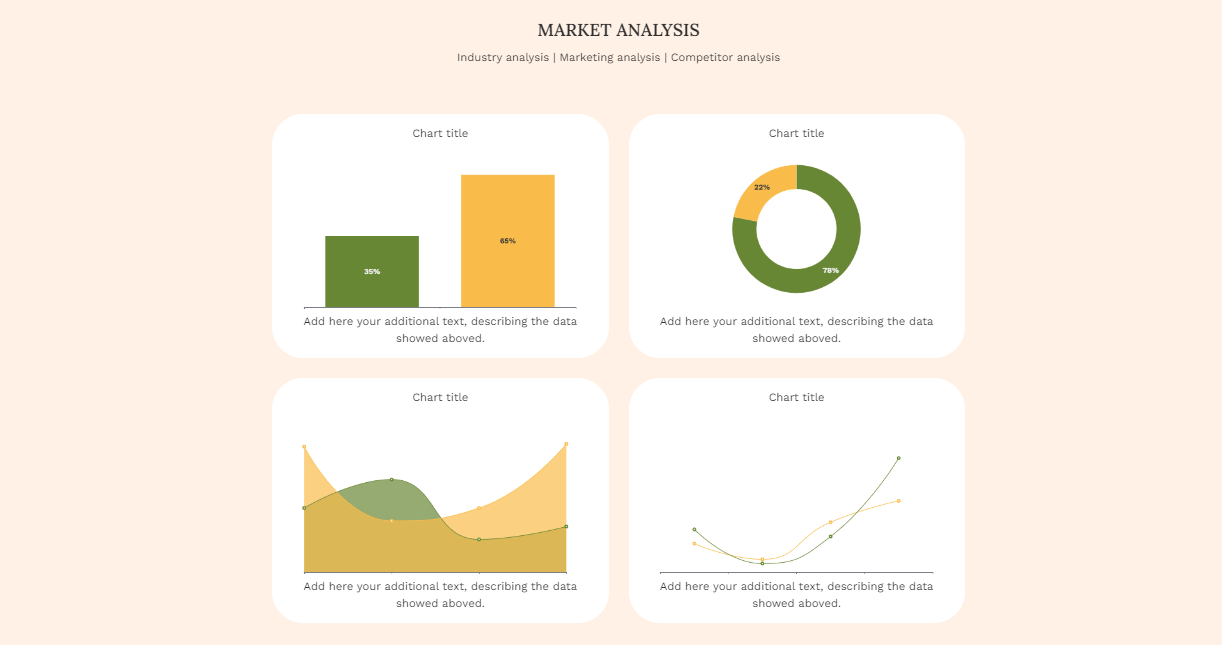
6) Address potential objections
Anticipate any potential objections or questions your audience might have and address them within your deck.
This not only shows that you've thought through your proposal thoroughly but also helps to build trust with your audience by acknowledging and addressing their concerns.
7) Keep your content focused
Avoid the temptation to include everything you know about the subject. Focus on what's most important.
Prioritize content that directly contributes to your objective and resonates with your audience. Less is often more when it comes to making a strong, focused argument.
8) Personalize where possible
If you can personalize aspects of your deck for specific audiences or stakeholders, do so. This could be as simple as including the client's logo or as complex as tailoring the content to address their unique challenges.
Personalization shows that you've put thought into your proposal and value your audience's specific needs.
Here's a great example of a personalized deck:

9) Include a clear call to action
What do you want your audience to do after they've seen your deck? Whether it's scheduling a meeting, signing a contract, or just considering your proposal, make this clear.
A strong call to action slide provides a clear next step for your audience and can significantly increase your chances of success.
Here's an example of a next step slide:

Incorporating an 'Accept' button into your proposal is another small change that makes a big difference.
It's a straightforward way for clients to give their approval, cutting down on the time it takes to get from proposal to partnership.
This feature is a smart move towards smoother, faster business agreements, benefiting both you and your clients with its simplicity and effectiveness.
Here's an example of a deck with an accept button:

Proposal deck design principles
The design of your deck is not just about looking good; it's about enhancing comprehension, retaining attention, and creating an experience that sticks with your audience long after the presentation is over.
Let's dive into the art of designing a proposal deck that not only looks professional but also communicates your message with clarity and impact.
1) Embrace interactive elements
When it comes to proposal decks, many turn to static legacy decks that are straightforward, often resembling a digital brochure filled with text.
They're like reading a book from cover to cover; you get all the information, but the journey is predetermined, with no room for interactive elements or personalized pathways.
They can also be a bit of a squeeze on mobile devices, often requiring zooming in and out to read the details.
Interactive decks are like stepping into a 'choose-your-own-adventure' book. They transform the viewer's experience from a passive receipt of information to an active exploration with elements such as embedded links, clickable tabs, and dynamic graphs.
It's about creating a journey where the audience can dive deeper into areas of interest, watch embedded videos for more insights, or interact with real-time data.
Here's what a static deck looks versus an interactive one:

2) Make sure the design is responsive
With people accessing content on a variety of devices, responsive design is crucial. Your proposal deck should look great and function well whether it's viewed on a desktop, tablet, or smartphone.
This means optimizing layouts, text sizes, and interactive elements to work seamlessly across different screen sizes. Responsive design ensures that your audience has a quality experience no matter how they choose to view your deck.
Here's an example of a mobile-responsive deck:

3) Visualize your data
Data visualization is a powerful tool in proposal decks. It turns complex data into easy-to-understand visuals like charts, graphs, and infographics.
Good data visualization should simplify information, not complicate it. Use it to highlight key points, show trends, or compare figures.
Remember, the goal is to make your data accessible and meaningful to your audience, helping them grasp your points quickly and clearly.
4) Maintain consistent branding
Your deck should reflect your brand's identity. Use your brand's color scheme, fonts, and logos consistently throughout the deck. This not only looks professional but also reinforces your brand in the minds of your audience.
Be mindful of color psychology and choose a palette that aligns with the mood and tone of your message.
Here's an example of a branded deck:

5) Implement narrated design
Narrated design is a modern approach that mimics the natural way we consume digital content. Instead of clicking through slides, the audience scrolls down a continuous canvas.
This design is intuitive and allows for a storytelling flow that feels seamless and cohesive.
It's particularly effective for online presentations, where the audience can scroll through the content at their own pace, ensuring they absorb information in a comfortable and engaging manner.
Here's an example of narrated design:

6) Balance text and imagery
A well-designed deck strikes a balance between text and imagery. Use high-quality images that complement and enhance your narrative.
Avoid overcrowding your slides with text; instead, use bullet points or short paragraphs. The imagery should serve to break the monotony of text, making your deck more visually appealing and easier to digest.
7) Use white space wisely
White space, or negative space, is a crucial design element. It's the space between text, images, and other elements on your slide.
Proper use of white space prevents your deck from looking cluttered and helps to focus the audience's attention on the most important elements. It makes your content more readable and gives your deck a clean, professional look.
8) Prioritize readability
Everything in your deck should be easy to read. This means choosing fonts that are clear and legible, even from a distance.
Be mindful of color contrasts; text should stand out against the background for easy reading. Remember, if your audience struggles to read your deck, they'll struggle to engage with your content.
Interactive proposal deck templates
The process of creating a proposal deck can be incredibly time-consuming, requiring not only a deep understanding of your content but also skills in design and interactivity.
It's a bit like building a house – you need a solid foundation, the right tools, and a clear plan.
Interactive proposal deck templates are like a well-equipped workshop, where the heavy lifting of structure and design has already been done for you. They bring a level of professionalism and polish that can be hard to achieve on your own.
Grab one and see for yourself.
Hi, I'm Dominika, Content Specialist at Storydoc. As a creative professional with experience in fashion, I'm here to show you how to amplify your brand message through the power of storytelling and eye-catching visuals.
Found this post useful?
Subscribe to our monthly newsletter.
Get notified as more awesome content goes live.
(No spam, no ads, opt-out whenever)
You've just joined an elite group of people that make the top performing 1% of sales and marketing collateral.

Create your best proposal deck to date.
Stop losing opportunities to ineffective presentations. Your new amazing deck is one click away!
How to Present a Business Proposal: The Complete Guide
Benjamin reimann, business proposal | business proposal presentation | how-to | sales tips | winning business, october 7, 2021.
It’s been three long months. You’ve done your research, toiled over every sentence, spent sleepless nights formulating the perfect business proposal. Surely, that should be enough, right?
Wrong. There is one more thing you need to do. And if you get it wrong, it could mean the last three months were for nothing — you need to do a business proposal presentation.
The one thing between your business and the finish line is a compelling presentation where you communicate the key points of your proposed solution. With so much riding on this, it’s easy to feel overwhelmed. But don’t worry: by the end of this 8-minute guide, you’ll be an expert on how to present a business proposal.
Get Pure Proposals Delivered to your inbox when we post!
Great you're on the list..
No Fluff. No Spam. Useful Content. Unsubscribe anytime.
- What Is A Business Proposal?
- What Is the Purpose of A Business Proposal Presentation?
Open with the problem or need
Offer a solution and elaborate, finish with a call-to-action, discuss benefits over features., practice incessantly and get lots of feedback., anticipate and incorporate answers to the questions you’ll receive., ask questions throughout to involve the audience., use stories throughout your presentation., provide written copies on the day of the presentation., don’t lean on your slides as a crutch..
- Building a Slide Deck Your Clients Will Remember
- Get Your Business Off The Ground Today With Pure Proposals
How do I write a business proposal?
What is in a business proposal, how long should a business proposal presentation be.
A business proposal is a document you present to a potential client or customers that details a solution to their problem. Typically, business proposals are written documents containing information about deliverables, performance metrics, budgeting projections, expected outcomes, and more.
You’re most likely to see business proposals in a business-to-business (B2B) setting, generally to win over business clients, suppliers, and partners. A proposal can be:
- Formally Solicited: Here, you’re given a list of requirements that you must follow to a tee.
- Informally Solicited: If the client isn’t entirely sure of what the problem or pain point is, they may put out an official request for your research and solutions.
- Unsolicited: These kinds of proposals are uncommon, but they have their place in sales and marketing funnels.
Often, the business proposal process is a laborious one. An in-person presentation tends to be the final barrier to overcome when trying to close a deal with a client.
Typically, after sending a business proposal document, you’ll be called in to deliver a presentation about the proposal. The presentation is where potential clients can finally see the human element of all the documents and spreadsheets they’ve been scanning thus far.
If you can’t communicate the contents of your business proposal clearly through a presentation, then there’s a good chance the days, weeks, or months you’ve spent preparing the proposal could go to waste. A well-delivered proposal presentation will inspire your audience to act then and there to accept your proposition.
- How To Structure Your Business Proposal Presentation
The last thing you want is for your presentation to feel too robotic and formulaic. That said, there are a few essential points you should always hit on:
Let’s dive deeper into each one.
A common mistake is to start with a 30-second spiel about you and your company. The problem? Your audience (aka potential clients) probably doesn’t care about you as much as they care about their own company’s issues. Fortunately, there’s an easy way to get past this: start by detailing their problems.
By opening with the customer’s needs vs. a self-introduction, you achieve three things:
- You demonstrate a vested interest in your clients’ success.
- You’re grabbing your audience’s attention by centering them in the presentation.
- You’ve set off a narrative structure by introducing the conflict. (More on this later).
Make sure to use facts, figures, and statistics here to drive your points home.
This will be the most comprehensive section of your presentation. Draw on the data from your written business proposal to flesh out this area, including information about project details, deliverables, performance metrics, budgets, talent, and more. It’s acceptable to follow the structure of your written proposal, but try to incorporate the details into a narrative format.
You should be going into this meeting with an ask in mind — signing a contract, purchasing a bundle, scheduling the next appointment. Ideally, your presentation leads towards this CTA, so you should make it easy for your audience to follow up: include your contact information on the slide, have printed copies of the contract on hand, etc.
Now that you have a basic idea of the structure of a business proposal presentation, let’s go over some tips to elevate your presentation from good to great.
- 7 Tips on How to Present a Business Proposal Presentation
Have you ever watched an Apple keynote delivered by Steve Jobs? Controversial as the man may have been, one thing is incontestable: he knew how to give a presentation. One of Jobs’ best tricks was to highlight benefits over features. Instead of telling you about the iPod’s internal architecture for data storage, he told you how many songs it could help you fit in your pocket. In your presentation, focus less on the technical specifications of your solution and more on the benefits it will give your client.
Anyone who’s ever winged a presentation with zero preparation knows how frustrating it can be — you know you could do better if only you had more time. Avoid those feelings by practicing as much as you can: in the mirror, in the car, and ideally in front of people who will give you honest and constructive feedback. That leads nicely into the following tip:
There’s a good chance you’ll offer your audience a Q&A period at the end of your business proposal presentation.To avoid getting caught off-guard, get questions from a practice audience in advance. If you can seamlessly mold the answers into your presentation, incorporate them. If not, it doesn’t hurt to have an appendix section at the end of your PowerPoint that you can use to address your potential client’s concerns. Speaking of questions…
Every effective presentation starts with a hook: a startling statistic, the start of a story, an exciting discovery, or a question for the audience. A common mistake is to stop there. You want your audience engaged throughout your business proposal presentation, after all. Include questions and tone shifts at various points in your PowerPoint to give your audience a chance to participate and engage.
Another powerful tool to keep your audience engaged is storytelling. Remember that narrative structure we mentioned earlier? Our brains are wired to process and recall information better if it’s framed in a story. The structure up above is a straightforward iteration of that: problem, solution, epilogue. You can also use smaller stories to add credibility during your presentation: customer testimonials, past achievements, and beyond.
It would be wrong to assume that every single person you’re presenting to has read the extended business proposal. That’s why it’s an excellent idea to have printed copies of the proposal ready and available when you give your presentation. It shows preparation and consideration for your client — a winning combination.
Technology is incredible. Unfortunately, it is also unreliable. You’ve probably been in a situation where technical difficulties have sullied, even ruined, a presentation or pitch. If you grow dependent on your slides to deliver the business proposal presentation, you’ll be in trouble if (and when) you run into computer issues. Construct your presentation so that it works without any slides — it’ll keep you prepared for the worst-case scenario.
So we’ve established that over-reliance on your PowerPoint presentation is a bad idea — but that doesn’t mean you ignore it entirely. Here are five tips for selecting, designing, and building an unforgettable slide deck:
Use consistent typography. Your slide aesthetics are a crucial part of conveying professionalism and thoughtfulness to your audience. Use a legible font (Sans Serif and some Serif fonts will do the trick) with enough contrast that viewers can read if they want to.
Follow a visually appealing color palette. A well-designed slide deck will flow seamlessly with your spoken presentation, but an ugly one will distract from your speech entirely. Keep it simple and stick to three to five colors that complement each other and your brand (or even your clients’).
Vary your slide layouts. Do your best to keep your PowerPoint visually interesting. Following the same format for every slide looks boring and comes across as lazy. Try slides with lots of whitespace and a central statistic, or one that’s entirely an image. On the subject of images…
Add distinctive images over generic ones. Your viewers will remember 65% of the details you provide when an image accompanies them. Unfortunately, that effect loses power when you use grainy, low-quality, and generic photos. Choose diagrams wisely — they should complement or clarify what you’re talking about, not just show it visually.
Don’t overload with text. When most people see a slide deck filled with text, they automatically start reading it. The result? They’re no longer paying attention to you. Don’t add a word-for-word transcript to your slide — instead, summarize the key points and expand upon them verbally.
You’ve got what you need to deliver a presentation that will amaze your client — all that’s left to do is present it! Show up early, speak with confidence, and have faith: you’re going to do great!.
By now, you’ve probably realized that the business proposal process is hard work. In all honesty, you probably just want to get back to the thing you love: your company.
That’s where we come in; here at Pure Proposals, our mission is to help your business thrive using PandaDoc to boost your sales, improve customer experience, and make proposals easier.
Curious to learn more? Chat with us today !
- Frequently Asked Questions
Your first step is to determine what the company requires from you — is it a formally solicited proposal? If not, follow traditional conventions: a title page, table of contents, executive summary, statement of need, proposed solution, explanation of capacity, projected billing and budget, and final terms and conditions. Check out our dedicated post on “How to Write a Business Proposal” .
A business proposal contains information regarding a client’s issues or pain points and a proposed solution on how to solve them. Business proposals tend to be data-driven and well-researched, so they may contain diagrams, graphs, and spreadsheets too.
Depending on the situation, varying proposal lengths are appropriate. For a more casual context, a one-pager that covers the basics is all you need. A longer document (around ten pages) is a better fit in more formal settings, such as with prospective customers.
Simplified business systems for busy people.
Systems Simplified. The top strategies and tools to streamline your sales process and close deals faster, in your inbox, every now and then.
Join hundreds of business leaders who receive Systems Simplified.
You May Also Like…
Pandadoc integration with hubspot.
May 30, 2024
In the digital age, businesses are constantly seeking ways to streamline their operations and improve efficiency. One...
How to Write a Funding Proposal: A Step-by-Step Guide
A funding proposal is a document that outlines a request for financial support for a project or initiative. Whether...
How to Write a Sponsorship Proposal
Sponsorship proposals are essential documents for individuals and organizations seeking financial support for their...
Automated page speed optimizations for fast site performance
6 Tips for Your Next Proposal Presentation
Shortlisted after submitting a proposal? Use these tips to create an effective proposal presentation and better align sales and proposal teams.
Proposal generation is often a key role in sales enablement. Frequently, after a proposal is submitted, the RFP issuer invites shortlisted bidders to present their proposal on-site. As a result, proposal teams and sales must work together to create a high-quality proposal presentation.
Proposal presentations are critical. This is an opportunity to address questions that the selection panel has. Additionally, the selection panel may compare your presentation to your competitors to sift out who is more technically competent.
No matter the purpose, proposal presentations require proposal teams and sales to align. Here are 6 tips for your next proposal presentation:
1. Define Your Agenda
Prospective clients and investors frequently ask for a presentation post-proposal submissions. Most often, they need to gain a better understanding of the proposal. Sometimes, they want information clarified. Other times, there was a question left out of the RFP that they now need to be answered. And, sometimes, they want to compare your proposed plan against that of a competitor’s.
In other words: Your audience has an agenda. So should you!

- Introductions
- Company history
- Defining the proposed plan
- Spelling out benefits
- Opportunity for questions
2. Start with a Story
What’s more compelling: A story? Or slide after slide of data? “While clients value data, they are also realistic about what data can – and cannot – tell them,” states John Hall of HubSpot , “They’ve seen many projects fail despite the glowing research results and they’ve seen projects succeed despite the lack of any data to back it up.”
Introduce the slides of data, charts, and graphs with a story. Storytelling has a positive impact on content. In fact, the human brain reacts considerably different when presented with facts versus stories. By sheer human nature, leading with a story will cause the selection panel to be more interested in the contents of your proposal presentation.
3. Think Lean
Lean thinking improves interactions with clients. Lean is commonly applied as a model for manufacturing systems . Lean thinkers drive value by eliminating practices that don’t add value to customers. Forbes contributor, Hakan Ener, suggests applying lean thinking to your proposal presentation. Avoid simply jumping to long-term projections of the future.
When speaking with potential business investors, clients, or partners, only ask for the resources that will cover the next phase of your action plan. Ask yourself if your presentation talking points provide immediate value.
4. Create a Gleaming Presentation
A proposal presentation is similar to a job interview. If you’re supposed to dress for the job you want, your presentation should be dressed for the business you want to win.
A poorly designed proposal presentation can detract from your talking points. A proposal presentation that is haphazardly thrown together could be perceived as indicative of poor quality to your business offering as well. Some of Small Business’ general best practices in presentation design include:
- Limiting ideas to one per slide
- Using a large font size
- Keeping a consistent, subtle background
- Ordering slides to the defined agenda
- Presenting easy-to-read charts, graphs, and tables
Lost on where to start in design? Check out these tips and tools that can help you create a killer presentation.

5. Ask Questions
A proposal presentation doesn’t mean you should talk, talk, talk. In fact, too much talking can do damage to your proposal. A few minutes into the start of the presentation, pause and ask the selection panel or client a question.
A Stanford GSB lecturer and public speaking expert, Matt Abrahams, outlines two primary purposes of asking your audience questions :
- Questions connect with the audience.
- Questions build your confidence.
For example, you can ask polling questions: Does this align with your needs?
6. Provide Handouts
Printed presentations help guide the selection panel. They can follow along, write notes, and bring home the information presented — including data, charts, graphs, and tables. Other beneficial handouts include supporting marketing collateral or sales literature in addition to the proposal itself. These handouts should contain compelling content and graphics that effectively reinforce your points.
Yet another benefit, printed materials solidify your proposed plan. Handouts can further define any resources needed or associated costs. Be sure that handout information doesn’t contradict with what’s in the already submitted proposal.
- twitter Tweet
- facebook Share
- pinterest Pin
Mimeo Marketing Team
Mimeo is a global online print provider with a mission to give customers back their time. By combining front and back-end technology with a lean production model, Mimeo is the only company in the industry to guarantee your late-night print order will be produced, shipped, and delivered by 8 am the next morning. For more information, visit mimeo.com and see how Mimeo’s solutions can help you save time today.
- Document Printing
- Wholesale Printing
- Warehousing Fulfilment
- Direct Mail Services
- Promotional Products
- Mimeo Print
- Mimeo Digital
- Mimeo Marketplace
- Training and Consultants
- Manufacturing
- Restaurant and Hospitality
- Medical Equipment
- Associations
- Construction
- Oil and Gas
- Pharmaceutical
- Real Estate
- Small Business
- Presentations
- Newsletters
- Business Cards
- Display Signage
- Kitting and Bundling
- Marketing Folders
- Posters and Banners
- News and Perspectives
- Mimeo Schools
- Mimeo Photos
- About Mimeo
- About Mimeo Business
Select your platform to login.
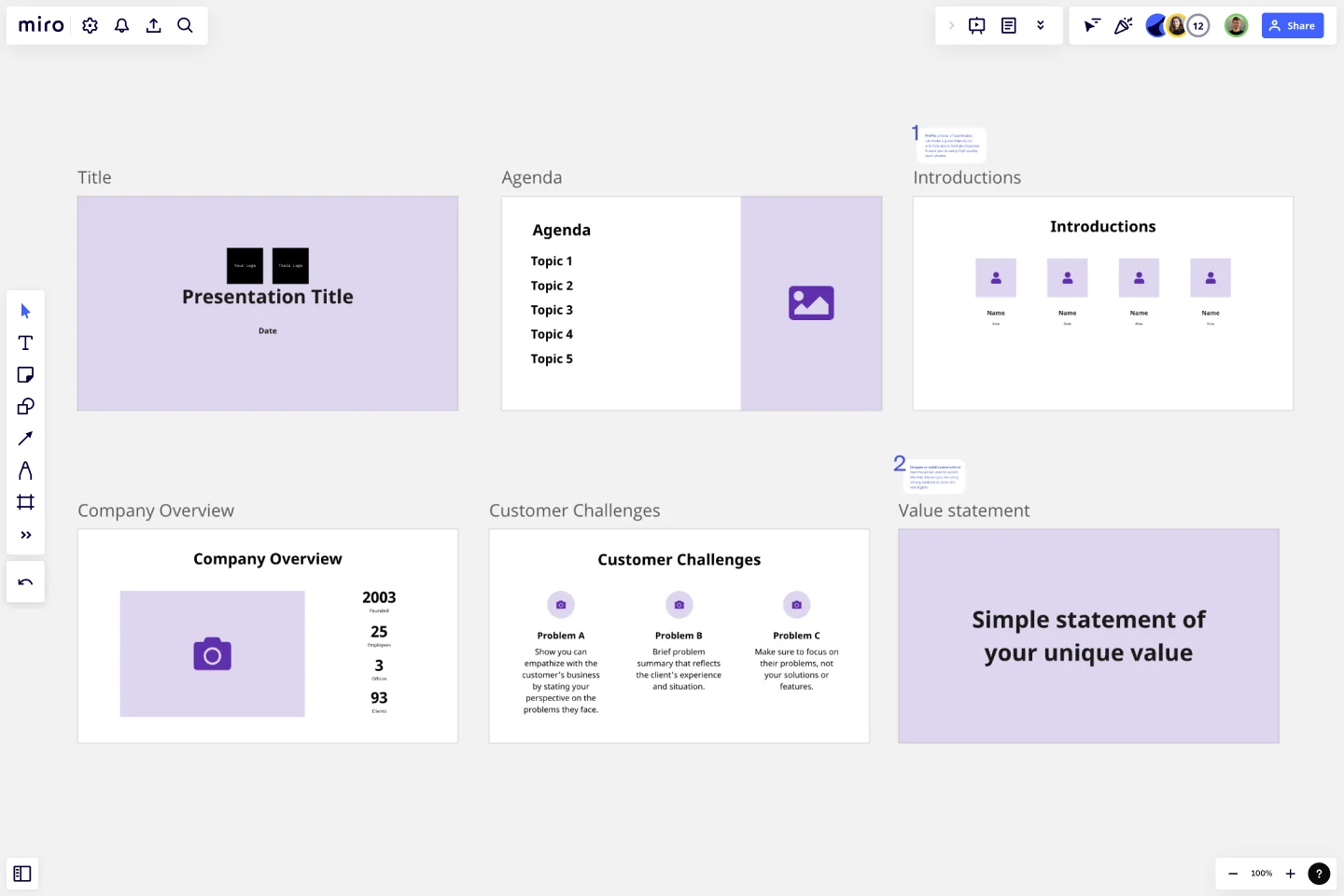
Proposal Template
Plan, structure, and deliver the perfect proposal presentation to your prospective clients.
About the Business Proposal Presentation Template
A Business Proposal Template is a framework for planning your upcoming proposal presentation. It allows you to address customer pain points, position yourself as a solution, and outline your product or service's scope and cost.
Whether you’re a consultant pitching to a prospect or a sales team trying to get a new customer on board — this template will give you the structure to convince a prospective customer to buy from you.
What should be included in a business proposal presentation?
Typically speaking, a business proposal includes the following:
Introduction and agenda
Overview of the problems or challenges your prospects face
How your product or service can solve their problems
Case studies and client testimonials
Budgets and pricing
Summary of the proposal details
An opportunity for questions and feedback
There's no single format for a business proposal. It varies depending on several factors, such as what your business does, who your client is, and what they want. That’s why using Miro’s template is so helpful — it’s fully customizable.
You can stick to our existing slide deck or add new presentation slides as you see fit. You can also customize the placeholder text in all the slides to create a compelling presentation for your prospective buyer.
Tips for delivering a successful proposal presentation
Put yourself in the shoes of your prospect. How would you feel if someone showed up and delivered a lackluster presentation? Chances are, you wouldn’t be impressed.
The way you prepare for and deliver your presentation can influence your success. When done well, you’re far more likely to get a good response. To make sure you deliver a thorough and well-structured presentation, use these tips:
Be prepared. Show potential clients you’re serious about working with them by being well-prepared. This means creating a thorough presentation with relevant and useful information. A proposal template is a great way to ensure you cover all your bases and don’t miss anything important.
Engage your audience. You want to keep your prospects engaged and interested in what you’re saying, so think about your presentation style. For example, don't spend the entire presentation reading directly from the slides. Use them to guide you, but try to talk directly to your audience.
Create an eye-catching presentation. The design of your presentation can also help keep your audience engaged. If you have visuals and images to support what you’re saying, you’ll have a better chance of holding their attention.
Show prospects how you can solve their problem. Your prospects need to know that you understand the challenges they face. To do this, be sure to address their pain points and position yourself as the solution. That way, they can see exactly how working with you will make their lives easier and improve their business.
Use data to back up your ideas. Show prospects that you’ve done your research and back your suggestions up with data. Use Miro’s charts to display this information or link externally to the data source.
How to use the Business Proposal Presentation Template
Miro’s digital workspace is the perfect place for individuals or collaborative teams to draft ideas. Keep track of all your notes in one location and use them to inform your proposal presentation.
When you’re ready to create your presentation, start by selecting this template. It’s free and easy to use, so you can start planning immediately. Then, follow these steps to create the perfect presentation.
Step 1: Have a rough outline for your proposal
Before you start creating your presentation, you need a rough idea of the structure. Visualize each step of the entire proposal and the key points you want to get across.
Step 2: Customize the proposal template
With a rough outline in mind, you can now start to customize our template to suit your needs. Add or remove slides, change their order, and edit the placeholder text to suit your presentation.
Step 3: Add the information for your presentation
With the structure in place, you can now add content to the slides. Remember, you can add images, visuals, and charts to any of the slides.
Step 4: Get feedback from peers
Share the presentation with team members and stakeholders to get feedback. Users can also add their suggestions directly into the template, making it easier for you to review their feedback and make the necessary changes.
Step 5: Deliver the presentation
To deliver the presentation, simply hop into presentation mode . This will put your presentation on full screen, and you can move through the slides using the arrow keys.
How do you start a proposal presentation?
Most start with an introduction followed by the problem and the proposed solution, but it varies from business to business. You should do whatever works for you and your prospect. If you’re unsure where to start, use this template to guide you.
How do you end a business proposal presentation?
Wrap things up by plainly outlining how much the client will need to spend and what they’ll get for their investment. Then, open the floor to questions.
What is the most important section of a proposal?
The answer to this question is subjective. Some will say it’s the overview of customer pain points — others will say it’s the overview of pricing. Ultimately, every part of your proposal has a role to play. To deliver a successful presentation, all of the elements need to come together.
What are the features of a good proposal?
Effective business proposals are clear, concise, and show awareness. Your prospects don’t want to be confused by your presentation. They want to follow every step of the journey and feel like you understand their challenges. That’s why using a presentation template is so helpful. It provides you with the structure you need to create a clear presentation that includes all the key information.
Get started with this template right now.
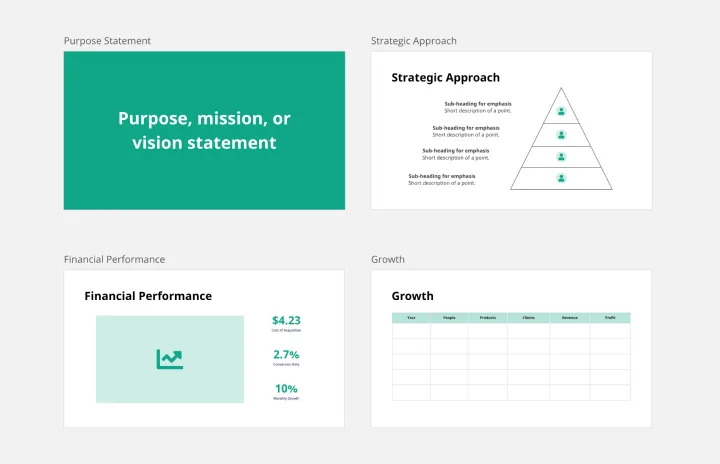
Annual Report Presentation Template
Works best for:.
Presentations, Business Management
Trying to cut down on the time it takes to create a stunning yet professional annual report presentation to wow your stakeholders? Use this template to outline all the in-depth information about your company’s performance in an engaging and easy-to-digest way.
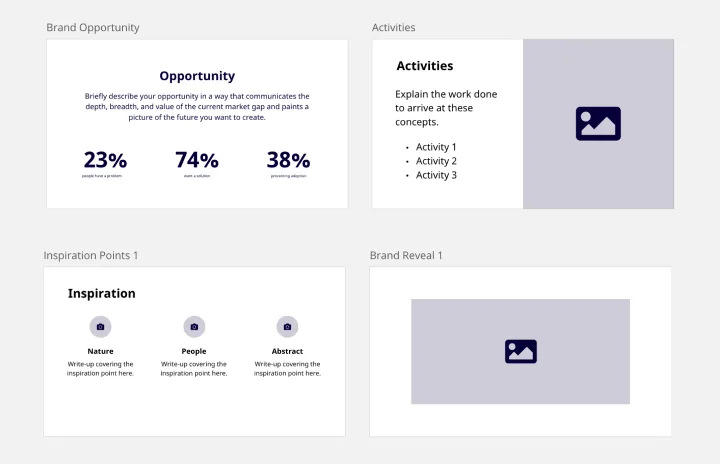
Rebranding Presentation
Presentations, UX Design
Out with the old, in with the new! Showcase your brand’s newly revised strategy with this dynamic Rebranding Presentation Template.
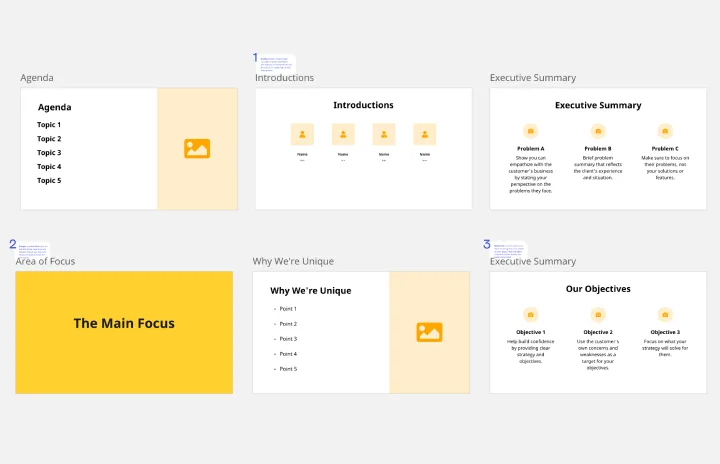
Consulting Proposal Template
Use this Consulting Proposal Template to develop an active working relationship with your prospects. Show them what you do, what you can deliver for them, and why they should work with you.
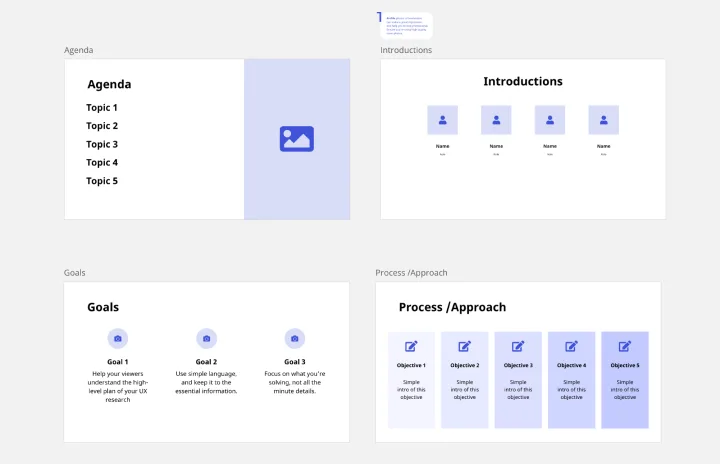
UX Presentation Template
Create a stunning UX presentation with Miro’s memorable slide deck. Customize your slide deck to display your UX research in the perfect format for your audience. Add charts, images, and visuals to present your findings.
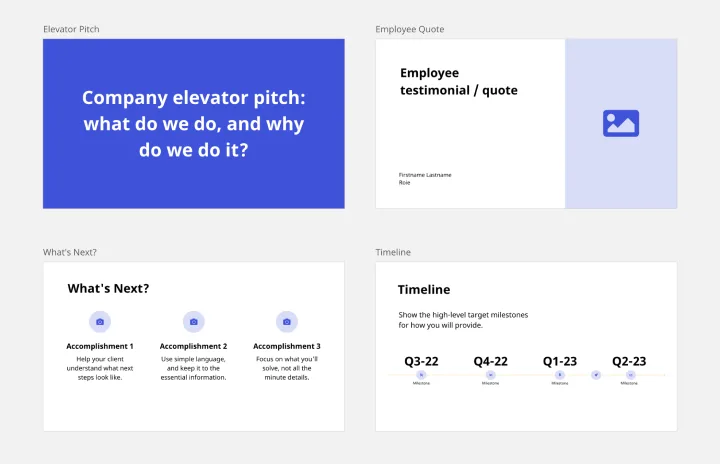
Company Vision Presentation Template
Creating or reimagining a company vision is just half the battle. You also need to make sure that your employees and customers understand and share it. Communicate your vision statement in the most effective and concise way with this Company Vision Presentation Template.
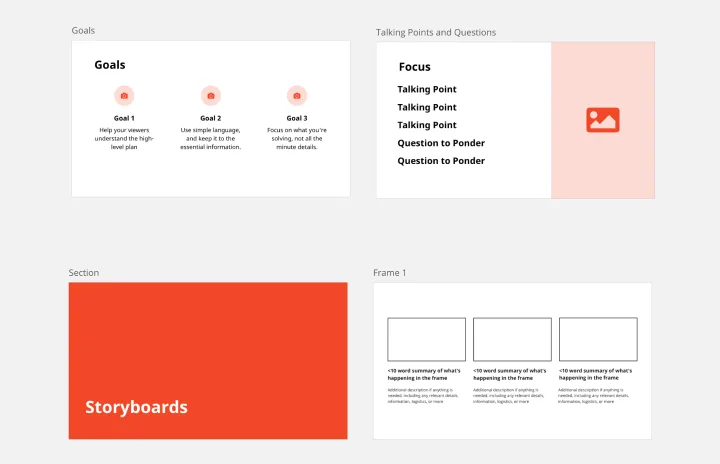
Storyboard Presentation Template
Presentations, Design Thinking
Use this Storyboard Presentation Template to visualize the structure, content, and flow of your presentation. Make sure that your presentation covers all the key points and hits the mark.

How To Write A Project Proposal Presentation?
Presenting your ideas well is essential to gaining quick approval for projects, whether internal or external. Even the strongest elevator pitch is not going to work by itself. Writing a project proposal presentation enters the picture at this point. You must be able to deliver a proposal for a project effectively if you have the technology or product to show a particular investor. This blog will help you understand how to write a project proposal presentation quickly and how to compose it.
What is a Project Proposal Presentation?
A project proposal serves as a project management tool for outlining the goals and specifications of a project. It facilitates initial project planning framework agreement between organizations and external project stakeholders.
Its primary goal is to win over decision-makers. Because of this, a project proposal presents the main selling point of your endeavor to internal and external project stakeholders. The proposal aims to catch the interest of project sponsors and stakeholders.
Different Types of Project Proposal Presentations
Before learning how to make a project proposal presentation, you need to know that they are of different types. Here are some of the types in which you can give a presentation of a project proposal:

1. Solicited Project Proposal:
A solicited project proposal is a formal document submitted in response to a specific request or invitation from an organization or entity seeking external project ideas or services. The one requesting issues a Request for Proposal (RFP).
The proponents create a solicited project proposal presentation detailing their approach, expertise, timelines, and costs for addressing the outlined needs. Organizations evaluate and compare the proposals that describe their solutions and services before selecting them.
2. Unsolicited Project Proposal
In an unsolicited proposal, you create a proposal after carefully identifying the possible solutions for the problems. It’s unlike an RFP but something an investor didn’t ask for. These project proposal presentations are sent to potential clients without being asked for as a pitch or an introduction to investors or sponsors.
3. Informal Project Proposal
With informal project proposals, potential customers express interest in your offerings and ask to review your proposal. Since these are based on conversations rather than official requests, they frequently include all the required information. So they usually need much more research.
4. Renewal Project Proposal
A renewal project proposal presentation is a document that outlines plans for extending, updating, or continuing an existing project or service. These offers are made to potential customers to prolong the support for an ongoing project close to completion. The proposal typically includes reviewing the project’s past performance, achievements, and any necessary adjustments or enhancements for the renewal period.
5. Continuation Project Proposal
A continuation project proposal is a document submitted to request for extension or continuation of an existing project beyond its initially planned time frame. It typically includes an assessment of the project’s progress, achievements, and the need for additional time to accomplish its goals. The proposal outlines the reasons for the extension, any adjustments to the project plan, and a renewed timeline to ensure the successful completion of the ongoing initiative.
6. Supplemental Project Proposal
A supplemental project proposal presentation is a formal request document submitted to propose additional work or modifications to an existing project. The use of this proposal arises due to changing project requirements, unforeseen challenges, or the identification of new opportunities during the project. The proposal details the scope of the supplemental work, its impact on the overall project, associated costs, and any adjustments needed in the project plan.
This section gives you some clarity on how to write a project proposal PowerPoint presentation. It outlines the blueprint of a comprehensive presentation, using a project proposal presentation example:

1. Understand Your Audience and the Problem you’re Solving:
Before diving into the content creation process, it’s essential to have a deep understanding of your audience. Identify their needs, concerns, and expectations to tailor your project proposal presentation accordingly. This ensures that your proposal addresses their specific requirements and resonates with them.
Persuade your reader with references and data. Among the inquiries to make are:
- What issue is your project trying to solve?
- What is known about this issue already?
- Who has previously tackled this issue, and what literature is available?
- Why can’t this problem be adequately addressed by previous research?
2. Define Clear Objectives:
Clearly outline the objectives of your project proposal presentation on PowerPoint or Google Slides . Whether seeking approval, securing funding, or gaining support, having well-defined goals will guide your content creation process and help you focus on delivering a persuasive message.
A few things to mention are:
- Your project’s mission statement
- Your project timeline, complete with significant checkpoints
- Roles and duties of the project team
- A risk register outlining your risk-reduction strategy
- Deliverables for the project
- Tools for reporting that you’ll utilize during the project
3. Structure Your Presentation:
Create a well-organized structure for your presentation to maintain clarity and flow. Begin with an engaging introduction, followed by a detailed overview of the project, the problem it aims to solve, proposed solutions, and a compelling conclusion. Use visual aids, such as slides and graphics, to enhance understanding and engagement.
As you’re defining the structure of your presentation, be sure to incorporate the following:
- The outcome or goal of your undertaking
- A schedule for the project’s deliverables’ readiness
- SMART objectives in line with the outputs you’re generating

4. Craft a Captivating Introduction:
Start your project proposal presentation with a hook that captures attention and sets the tone for the rest of the proposal. Clearly state the problem your project addresses and why it’s important. Establish a connection with your audience by highlighting the project’s relevance to their interests or goals.
5. Clearly Define The Project Scope:
Provide a comprehensive overview of your project, detailing its scope, objectives, and anticipated outcomes. Clearly articulate the timeline , milestones , and deliverables to give your audience a realistic understanding of what to expect.
6. Highlight The Value Proposition:
Emphasize the unique selling points and benefits of your project. Communicate how it addresses the identified problem and why it stands out from alternative solutions. Use data, testimonials, or case studies to bolster your claims and build credibility.
7. Develop A Realistic Budget:
Include a detailed budget that outlines the financial requirements of your project. Break down costs into categories and provide justifications for each expense. This demonstrates a thorough understanding of the financial implications and reinforces your credibility.
8. Address Potential Challenges And Risks:
Acknowledge potential challenges and risks associated with the project and outline mitigation strategies. Demonstrating a proactive approach to risk management reflects your preparedness and commitment to the project’s success.
9. Engage Your Audience:
Encourage audience interaction throughout your presentation. Incorporate opportunities for questions and discussions to address concerns, gather feedback, and foster a collaborative atmosphere.
10. Conclude with a Strong Call to Action:
Wrap up your presentation with a compelling conclusion reinforcing the project’s value and importance. Clearly state the desired action or decision you seek from your audience, whether it’s approval, support, or funding.
By following these comprehensive steps, you can create a project proposal presentation that informs and persuades, increasing the likelihood of successful project approval and implementation.

How To Present A Project Proposal Presentation?

Presenting a project proposal is an art that involves not just the spoken word but also the visual representation of your ideas. Each slide in your presentation plays a crucial role in conveying key information and building a compelling case for your project:
Slide 1: Title Slide
The title slide sets the tone for your presentation. Include the project title, your name or team name, and the date. Use visually appealing graphics or images related to the project to capture attention.
Slide 2: Agenda
Provide an overview of the presentation structure . This helps orient your audience and gives them a roadmap of what to expect. Clearly outline the key topics and sections you’ll be covering.
Slide 3: Introduction
Start with a compelling introduction. Highlight the problem your project addresses and why it is significant. Engage your audience initially, making them eager to learn more about your proposal.
Slide 4: Project Overview
Offer a brief but comprehensive overview of the project. Include key details such as the project’s purpose, goals, and objectives. Use visuals like charts or graphics to convey information succinctly.
Slides 5-8: Problem Statement and Need
Dedicate a few slides to articulate clearly the problem your project aims to solve. Provide data, statistics, or real-life examples to emphasize the urgency and relevance of the issue.
Slide 9: Solution
Present your proposed solution to the identified problem. Break it into key components and use visuals to illustrate how your project addresses the issues. Communicate the unique value of your solution.
Slides 10-12: Project Scope and Deliverables
Detail the scope of your project , including specific deliverables and milestones. Use visuals like timelines or Gantt charts to help your audience visualize the project’s timeline and workflow.
Slide 13: Budget
Introduce the financial aspect of your project. Break down the project budget into categories and provide a clear overview of the costs associated with each. Use graphs or pie charts to make the information easily digestible.
Slides 14-15: Risks and Mitigation
Acknowledge potential challenges and risks associated with your project . Demonstrate your awareness and preparedness by outlining mitigation strategies for each identified risk.
Slide 16: Team and Expertise
Introduce the key members of your project team and highlight their relevant expertise. This slide helps build credibility and assures your audience that you have the necessary skills to execute the project successfully.
Slide 17: Conclusion and Call to Action
Wrap up your presentation with a powerful conclusion. Reiterate the key points, emphasize the project’s value, and issue a clear call to action, whether it’s approval, support, or further discussion.
Tips On Giving A Project Proposal Presentation
Regardless of the type of presentation you deliver, your goal is to influence or wow the audience:
Define Your Agenda:
- Clarify proposal details for investors and clients.
- Address omitted RFP questions.
- Contrast your plan with rivals if requested.
Tell a Story:
- Introduce data, charts , and graphs with a narrative.
- Engage the audience by appealing to human nature.
- Enhance content through storytelling.
Think Lean:
- Apply lean thinking to enhance client relationships.
- Eliminate non-beneficial procedures in your presentation.
- Avoid jumping to long-term future estimates.
Construct an Eye-Catching Presentation:
- First, dress appropriately for the presentation you are about to give.
- A well-constructed presentation reflects positively on your company.
- Avoid hastily put-together presentations to maintain quality perception.
Ask Questions:
- Avoid excessive talking during the presentation.
- Engage the audience by posing questions.
- Boost your confidence and gather feedback through polls or direct inquiries.
ALSO READ: How to write an effective project charter?
Top 5 Project Proposal Templates
1. project proposal summary powerpoint template.

This template provides a concise and visually appealing overview of your project proposal, featuring key elements such as objectives, timelines, and budgetary considerations in a structured and professional format.
2. Project Proposal Presentation Template

The Project Proposal Presentation Template is designed for project leaders to propose new ideas to clients, investors, or business owners. Executives can also use it to propose their businesses to different investors. The marketing, product, and project management teams can use this presentation to propose new business or project ideas.
3. Project Management Lifecycle PowerPoint Template

Specifically designed to illustrate the phases and milestones of project management, this template guides stakeholders through the entire project lifecycle, emphasizing key stages, deliverables, and decision points for a comprehensive understanding.
4. Project Management Swimlane PowerPoint Template

This template employs a swimlane format to delineate responsibilities among team members or departments, offering a clear and organized visualization of tasks and workflows to enhance transparency and streamline project execution.
5. Business Proposal Deck PowerPoint Template

A sophisticated and customizable template for crafting compelling business proposals , this deck incorporates modern design elements to showcase essential details, including market analysis, value propositions, and financial projections, ensuring a professional and persuasive presentation.
Developing a project proposal is essential for connecting you, your group or organization, investors, and other stakeholders. Your greatest option for a concise, educational, and polished presentation is a project proposal presentation. As discussed above, making an eye-catching summary of your project will attract more interested outside collaborators and their encouraging comments.
You can also access SlideUpLift, one of the top platforms for presentation templates and tools to help with the presentation-making task. You can select from a wide range of carefully crafted templates for project proposals. SlideUpLift gives presenters the tools to make visually striking and memorable presentations, emphasizing customization, clarity, and aesthetics.
How do I make a project proposal PowerPoint presentation?
To create a project proposal PowerPoint presentation, start by outlining the project’s goals, objectives, and key details. Utilize SlideUpLift’s Project Proposal templates for a professional look and incorporate visuals for clarity.
What is the step-by-step process for the presentation of a project proposal?
During the project proposal presentation, the presenter should introduce the project, present an overview, detail the methodology, present the timeline and budget, and conclude with a summary of key points.
What should I include in the presentation of a project proposal?
In a project proposal presentation, you should cover essential elements such as project goals, methodology, budget, and team details to provide a comprehensive overview for stakeholders.
How should I start a project proposal presentation?
Begin your project proposal presentation with a strong opening, clearly introducing the project’s name and purpose and highlighting its significance to capture the audience’s attention.
Where to find the best Project Proposal Presentation templates?
There are a variety of project proposal presentation templates available on SlideUpLift. Just find your desired template on SlideUpLift.com and download it.
Table Of Content
Related presentations.

Animated Business Proposal PowerPoint Template

Project Scope Summary PowerPoint Template

Marketing Proposal PowerPoint Template
Related posts from the same category.

15 Dec, 2023 | SlideUpLift
How to Create a Successful Project Presentation?
In any business, project managers need to be able to communicate a project strategy to clients effectively. It can bring in new, long-term clients to your agency if done correctly.

20 Dec, 2023 | SlideUpLift
How to Introduce Project Members In a Team Presentation?
The introduction of a project team in a team presentation is not only a formality but a deliberate undertaking with significant consequences in the ever-changing field of project management. It

21 Dec, 2023 | SlideUpLift
Top 10 Project Management Presentation Topics
Project Management Presentation Topics are a range of subjects related to efficiently managing projects. The topics cover different aspects. These include planning methods, team collaboration, risk management, leadership, and emerging
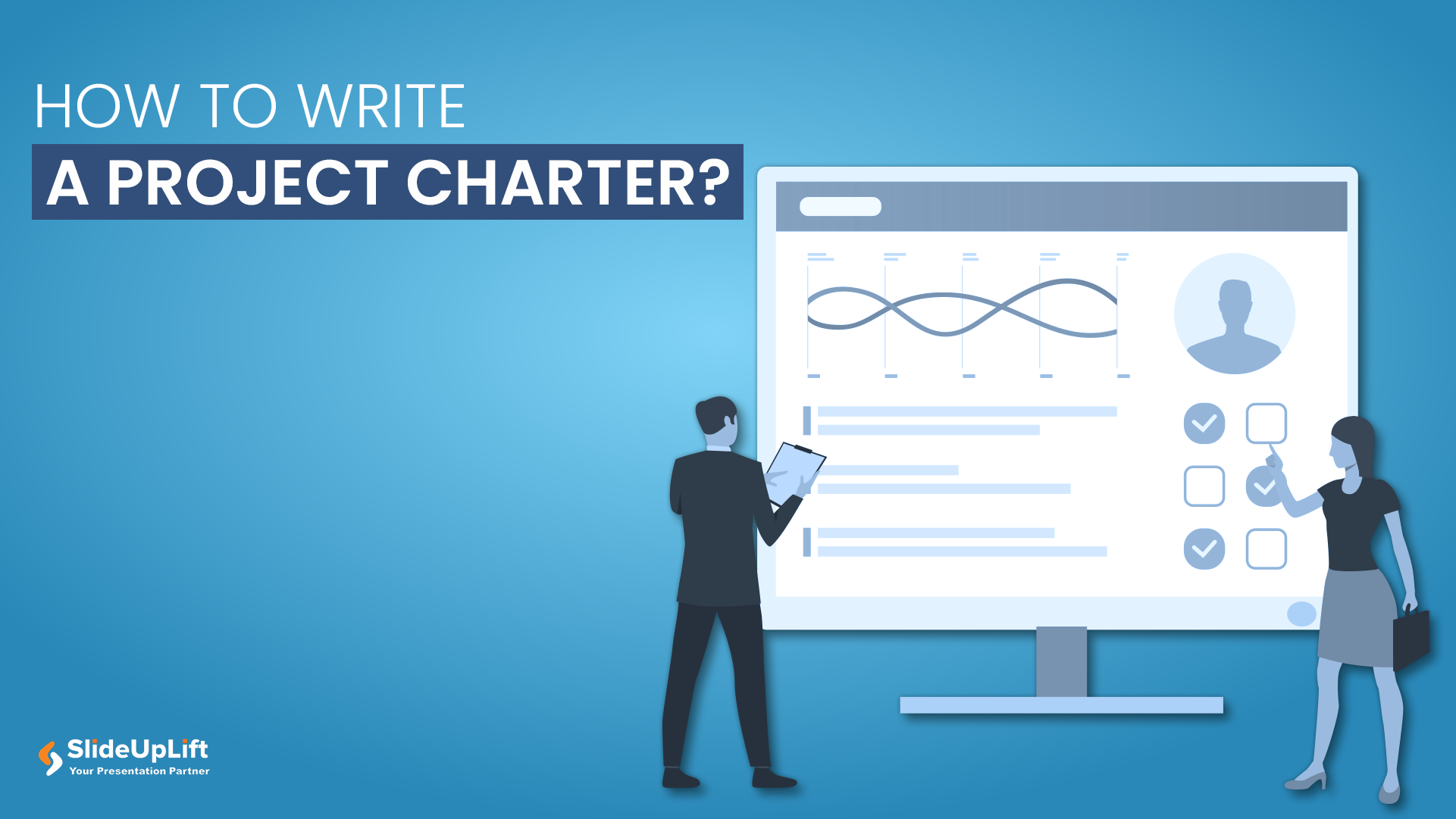
22 May, 2020 | SlideUpLift
How to Create a Project Charter Presentation?
A project charter serves as the foundational document that officially initiates a project and grants authority to the project manager. This concise yet comprehensive document outlines the project's purpose, objectives,
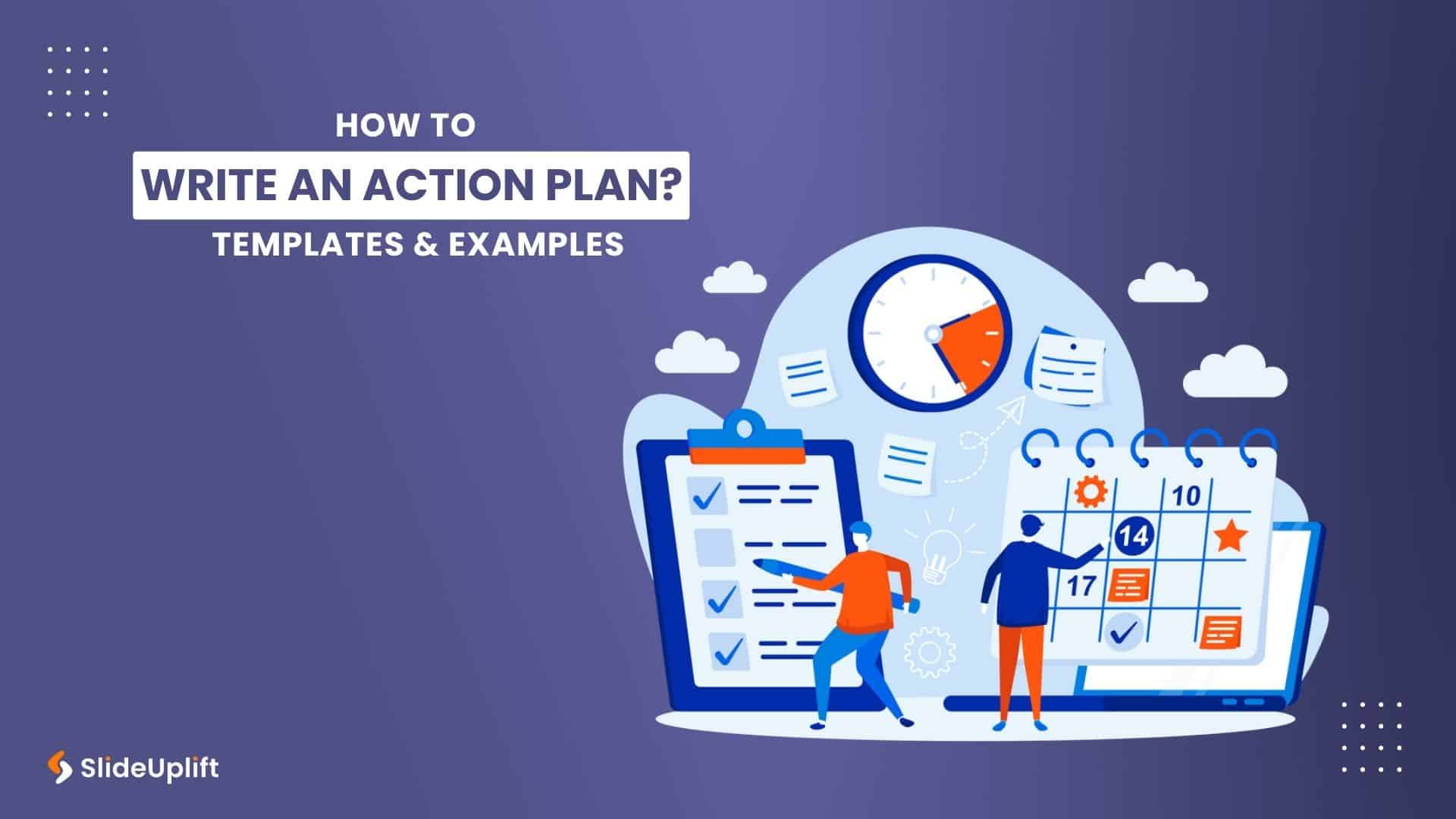
8 Jan, 2024 | SlideUpLift

How to Write an Action Plan? Templates & Action Plan Examples
When going through the strategic planning process, many firms have wasted their time and money, and no meaningful changes or solutions have resulted. A badly thought out or implemented action

31 Oct, 2022 | SlideUpLift
The Savvy Project Manager Series: 5 Steps To Successful Project Planning
We encounter projects in our everyday lives. You might be building or contributing to a deliverable like a report, a website, a tool, or a product. These are real projects

6 Jun, 2024 | SlideUpLift
A Comprehensive Guide To Project Kickoff Meetings
It is always exciting to start work on a new project with your team, but before you even begin, there is one meeting you need to have: a project kickoff

12 Aug, 2021 | SlideUpLift
8 Project Management KPIs For Project Managers
Sometimes the best-managed projects fall apart because they are not working towards specific and measurable goals. Or they are working with too broad or too narrow objectives that do not

5 Jul, 2022 | SlideUpLift
Communicate With Authority Using These Highly Effective Project Presentations
Project management is the application of resources, techniques, and talent to create the required deliverables. Yet, mere delivery is not sufficient- a key differentiator within Project Management is seamless communication

8 Jul, 2021 | SlideUpLift
Avoid Making These 7 Project Management Mistakes
Making mistakes is not a bad thing; tons of lessons can be learned from them. And in the field of Project Management, lessons abound. Projects, unfortunately, seldom go smoothly. There
Related Tags And Categories
Forgot Password?
Privacy Overview
Necessary cookies are absolutely essential for the website to function properly. This category only includes cookies that ensures basic functionalities and security features of the website. These cookies do not store any personal information
Any cookies that may not be particularly necessary for the website to function and is used specifically to collect user personal data via ads, other embedded contents are termed as non-necessary cookies. It is mandatory to procure user consent prior to running these cookies on your website.
- EXPLORE Random Article
- Happiness Hub
How to Present a Proposal
Last Updated: February 22, 2024 Approved
This article was co-authored by Michael McCutcheon, PhD . Dr. Michael McCutcheon is a career coach, psychologist, and award-winning public speaker who specializes in procrastination elimination, goal achievement, and increasing life satisfaction. With a background as a counseling psychologist, he guides clients toward becoming more aware of their desires and anxieties to break old patterns, create new habits, and achieve life-changing results. He also helps clients improve organization skills, embark on a new career, get promoted, get admitted into graduate schools, and transition from school to the working world. He is a published author and lecturer in graduate psychology courses at New York University (NYU), a position he has twice won the Teaching Award (2014 & 2019). His work has appeared in the press as a lifestyle and career expert for The Washington Post/The Associated Press, The New York Post, Scholastic, Lifehacker, and The Coca-Cola Company. He has served as a contributing writer for Out Magazine and featured panelist on National Public Radio (NPR). There are 7 references cited in this article, which can be found at the bottom of the page. wikiHow marks an article as reader-approved once it receives enough positive feedback. In this case, 100% of readers who voted found the article helpful, earning it our reader-approved status. This article has been viewed 56,776 times.
Presenting a business proposal requires more than simply reading a transcript of the proposal text. Gaining the confidence of your audience requires tact, research, and a whole lot of preparation. If done correctly, your presentation can inspire your listeners to adopt your proposal.
Preparing the Proposal

- If possible, talk to someone who has already seen the proposal, and gauge their interest.
- Check recent news stories which indicate the current financial state of the company or individual you're targeting.
- Think about the audience's values, goals, and ideals. Your proposal should address not just their economic needs but their corporate mission, too.

- Your written proposal should not be identical to your oral presentation. Simply reading the proposal word for word will bore your audience. Your oral presentation should use the proposal text as a foundation but should also expand on your main points without lingering on every detail.

- An improper or incomplete proposal submission may jeopardize your chances of not only having your proposal approved but also receiving future RFPs. Use care when crafting your submission.

Making the Pitch

- This is especially important when conducting an RFP presentation.

- Slide shows can help listeners retain information and better understand the main points of your proposal.
- You can use the slide show to supplement or replace your own notes. They can keep you on track and keep your audience engaged.

- Before you begin, try breathing in and out slowly for a while.
- Assume your audience is receptive, not hostile, to your proposal.

- Avoid interjecting filler words like "uh" or "um" into your presentation.

Sealing the Deal

- If you get an off-topic or difficult question, address it honestly, but artfully try to redirect the question back to why your proposal is a good one. [11] X Trustworthy Source Harvard Business Review Online and print journal covering topics related to business management practices Go to source

Expert Q&A

- Don't feel defeated if your proposal is not accepted. Think of it as a learning experience, and try to identify points which could be stronger next time. Thanks Helpful 0 Not Helpful 0
- Pay attention to the details. This applies to both the written proposal and your oral presentation. Thanks Helpful 0 Not Helpful 0
- Dress professionally for your presentation. First impressions are important. A sloppy appearance could hurt your proposal's chances of success no matter how good your presentation is. Thanks Helpful 0 Not Helpful 0
- Do not take beta-blocker drugs in an attempt to relax before your presentation. You run the risk of becoming a little too relaxed and doing or saying something you'll later regret. Thanks Helpful 1 Not Helpful 0
You Might Also Like

- ↑ Michael McCutcheon, PhD. Career Coach & Psychologist. Expert Interview. 14 October 2020.
- ↑ https://www.entrepreneur.com/starting-a-business/7-steps-to-a-winning-business-proposal/299681
- ↑ http://www.fripp.com/selling-your-way-to-success-how-to-present-your-proposal-at-an-executive-meeting/
- ↑ Paul R. Timm, How to Make Winning Presentations, https://books.google.com/books?id=qqScv8LU9noC&lpg=PP1&dq=winning%20presentations&pg=PT60#v=onepage&q=winning%20presentations&f=false
- ↑ Thomas Leech, How to Prepare, Stage, and Deliver Winning Presentations, https://books.google.com/books?id=GEJn-UPf1cEC&lpg=PP1&dq=winning%20presentations&pg=PA80#v=onepage&q=proposal&f=false
- ↑ https://hbr.org/2010/11/how-to-get-their-approval.html
- ↑ https://hbr.org/2010/11/defend-your-research-people-often-trust-eloquence-more-than-honesty/ar/1
About this article

To present a business proposal, make sure to speak in a clear, audible voice to command your audience’s attention, and avoid using distracting filler words like “uh” and “um.” Additionally, emphasize the main points rather than reading your proposal word for word, since your audience will have the text before them. You should also use visuals, like PowerPoint slide shows, to help the audience have a better understanding of your main points. Then, end your proposal by reiterating your main points in a simple, straightforward way. For more advice, like how to write your proposal with inspiring, optimistic language, keep reading! Did this summary help you? Yes No
Reader Success Stories
Kudzie Brown
Jan 3, 2018
Did this article help you?
Jul 1, 2017
Jun 30, 2018

- About wikiHow
- Terms of Use
- Privacy Policy
- Do Not Sell or Share My Info
- Not Selling Info
These cookies are required for the website to run and cannot be switched off. Such cookies are only set in response to actions made by you such as language, currency, login session, privacy preferences. You can set your browser to block these cookies but this might affect the way our site is working.
These cookies are usually set by our marketing and advertising partners. They may be used by them to build a profile of your interest and later show you relevant ads. If you do not allow these cookies you will not experience targeted ads for your interests.
These cookies enable our website to offer additional functions and personal settings. They can be set by us or by third-party service providers that we have placed on our pages. If you do not allow these cookies, these services may not work properly.
These cookies allow us to measure visitors traffic and see traffic sources by collecting information in data sets. They also help us understand which products and actions are more popular than others.
Business Proposal Presentation Template
Crafting an impactful business proposal has never been simpler. Introducing our business proposal presentation template, where stunning design meets all the requirements to capture your audience and win them over.
Whether you’re pitching to investors, seeking new partnerships, or securing project contracts – allow this template to showcase your professionalism, expertise, and brand.
Our business proposal template can also help you:
- Introduce your project to stakeholders
- Clarify objectives and overall goals
- Identify your target audience
How to use our template to create a business proposal presentation
This proposal presentation serves as an opportunity to boost sales, attract new investors or audiences, and showcase your planning skills. Say goodbye to cumbersome formatting with this template that provides key sharing and summary points for whoever you’re pitching to. Those slides include:

Pro tips for building a business proposal deck
Tailoring the template to your own business is simple. Whether you need to secure funding, win a contract, or solidify partnership opportunities, you can bring these plans to life with this customizable template and our entire library of professionally designed template slides. As you use this template to build your own business proposal presentation, keep these tips in mind:
Tailor your presentation to your audience’s preferences and level of sophistication. Consider factors such as level of technical expertise and knowledge of the industry or competitors.
Ensure your message can be easily understood by your audience. Use clear, concise language with ample white space to improve comprehension.
Images, icons, charts, graphs, and animations enhance the visual appeal of your proposal. However, avoid overcrowding the slides as it can distract from the main content.
With Beautiful.ai’s analytics feature, you can gather insights and identify areas for improvement. Things like slide click through rate, time spent on each slide, and any other feedback you’ve gathered can help when analyzing the success of your presentation.
More Popular Templates

Performance Review Presentation Template
Learn how Beautiful.ai’s performance review template can help you engage your team and set them up for success.

OKR Presentation Template
Learn how Beautiful.ai’s OKR template can help leadership set goals and expectations to improve team processes.

Digital Marketing Proposal Template
Pitch a new project or reel in potential new clients by using our digital marketing proposal template for your next meeting.

Sales Battlecard Presentation Template
Learn how Beautiful.ai’s sales battlecard presentation template can help sales teams position themselves against competitors in the sales cycle.

SEO Competitor Analysis Report Presentation Template
Learn how Beautiful.ai’s competitor analysis report template can help you define where your SEO efforts are winning and where they’re falling short.

Reddit Presentation Template
The popular site Reddit helps users engage with communities and conversations of varying topics so we’ve revamped their presentation deck to help them create more engagement with their presentations.
We use essential cookies to make Venngage work. By clicking “Accept All Cookies”, you agree to the storing of cookies on your device to enhance site navigation, analyze site usage, and assist in our marketing efforts.
Manage Cookies
Cookies and similar technologies collect certain information about how you’re using our website. Some of them are essential, and without them you wouldn’t be able to use Venngage. But others are optional, and you get to choose whether we use them or not.
Strictly Necessary Cookies
These cookies are always on, as they’re essential for making Venngage work, and making it safe. Without these cookies, services you’ve asked for can’t be provided.
Show cookie providers
- Google Login
Functionality Cookies
These cookies help us provide enhanced functionality and personalisation, and remember your settings. They may be set by us or by third party providers.
Performance Cookies
These cookies help us analyze how many people are using Venngage, where they come from and how they're using it. If you opt out of these cookies, we can’t get feedback to make Venngage better for you and all our users.
- Google Analytics
Targeting Cookies
These cookies are set by our advertising partners to track your activity and show you relevant Venngage ads on other sites as you browse the internet.
- Google Tag Manager
- Infographics
- Daily Infographics
- Popular Templates
- Accessibility
- Graphic Design
- Graphs and Charts
- Data Visualization
- Human Resources
- Beginner Guides
Blog Business How to Write Business Proposal (Examples + Free Templates)
How to Write Business Proposal (Examples + Free Templates)
Written by: Aditya Sheth Jan 25, 2024

The great Mark Cuban once said, “Sales cure all.” If a business doesn’t sell, it doesn’t make money and by extension the business fails. That’s why you need to write business proposals .
A well-written business proposal can often mean the difference between winning or losing a prospective client.
In this in-depth guide to creating business proposals, we show you how to close more deals, make more sales and crush your business goals — all by using easy-to-edit professional business proposal templates .
Here’s what this guide will cover (click to jump ahead):
What is a business proposal, what are the components of a business proposal.
- How to write a business proposal step by step
More business proposal examples + writing and design tips
What should you include in a business proposal, what are the types of business proposals.
- FAQs about business proposals
Looking for a shortcut? Watch this quick video for an overview of everything to include in your business proposal:
A business proposal is a document designed to outline a business plan to convince potential client, investor or partner to engage in a business agreement with you or your company. It’s basically a sales pitch in writing to persuade potential clients to show them benefits of working with you or your company for their business success.
A business proposal outlines what your business does and what you can do for your client . It can be general like this business proposal example:

Or it can be more specific, like this business proposal template which focuses on proposing a project for the Newton Center Rail:

Or this business proposal sample, which presents a plan for a social media strategy and campaign:

To design a business proposal that holds the client’s attention, identify their pain points. Then provide your buyer with the right solution to alleviate those frustrations.
Working on a new project? These project proposal examples might come in handy for you.
The components of a business proposal can change depending on the field, company size and client needs. While details may differ, strong proposals typically introduce your company, explain the problem, offer a solution and its benefits, highlight your team’s skills, and outline timeline, cost and next steps.
Sometimes, the complexity of crafting a business proposal, especially in projects requiring thorough market analysis or technical details, calls for professional insight. Seeking research proposal writing help can be invaluable in these instances, ensuring that your business proposals are not only well-structured but also highly persuasive and tailored to meet specific client needs.
How to write a business proposal step by step
Before you start creating your business proposal template, you need to understand the business proposal format. At a high level, your effective business proposal should include the following:
- Create a compelling business proposal title
- Build a table of contents
- Craft the executive summary
- Write a detailed problem statement
- Propose your solutions
- Showcase your team’s expertise
- Create a realistic timeline
- Present your payment structure
- Specify the terms and conditions
- Receiving the decision
Below, you can see business proposal examples that demonstrate how to include these 10 sections.
1. Create a compelling business proposal title
A compelling title could mean the difference between someone reading your proposal or ignoring it in favor of a competitor’s.
What makes a good title page? Here are the essential elements to include:
- Your name along with your company’s name
- The name of the prospect (or their business)
- The date you’re submitting the proposal

The gray business consulting proposal template above contains all the details a prospect would want to know. The title also offers a strong tangible benefit to the prospective buyer. Honestly, “Who doesn’t want to grow their business?”
2. Build a table of contents
The table of contents is a fundamental part of every winning business proposal template. It makes your proposal scannable and easy to read.
The people you will be pitching to are usually C-level executives like the CEO (Chief Executive Officer), COO (Chief Operating Officer), or fractional executives who work part-time. These are busy people who don’t have time to read your entire proposal in one go.
That’s why most of the business proposal examples in this list include a table of contents.
Adding a table of contents to your document makes it easy for them to go through it at their own pace. They can also skim through parts of the proposal that they deem more important. You can see how this abstract business proposal template uses the table of contents:

You can also make your business proposal template easier to navigate by adding hyperlinks to the document, particularly in the table of contents. This way your clients can jump to specific sections without having to scroll through the entire document. Ensuring your business plan format follows a clear structure can greatly enhance readability and comprehension for potential investors or partners.
It’s easy to add hyperlinks in the Venngage editor. Select the text you’d like to turn into a link, then click the link icon in the top bar. From there, select the page you want to link to! Then download your completed design as an Interactive PDF .

3. Craft the executive summary
The executive summary is a staple in all kinds of annual reports , leadership development plan, project plans and even marketing plans. It is a concise summary of the entire contents of your document. In other words, write a business proposal outline that is easy to glance over and that highlights your value proposition.
The goals of your executive summary are:
- Introduce your company to your buyer
- Provide an overview of your company goals
- Showcase your company’s milestones, overall vision and future plans
- Include any other relevant details
This gray business proposal example has a detailed yet short executive summary including some social proof in the form of clients they’ve worked with:

Take note of how precise this business proposal example is. You want to keep your executive summary concise and clear from the get-go. This sets the right tone for the rest of your proposal. It also gives your buyer a reason to continue reading your proposal.
Crafting an executive summary and keeping it concise and compelling can be challenging, but you can use an AI summarizer online or an AI proposal generator to create a polished document or executive summary. Such tools are trained on relevant AI models that can extract core points from a given text. You can get such a point either in bullet form or in abstract summary form.
Pro Tip: Try to write an executive summary such that, even if your prospective client doesn’t read the entire proposal (with a good executive summary, they most likely will), they should have a clear idea about what your company does and how you can help them.
4. Write a detailed problem statement
The point of writing a business proposal is to solve a buyer’s problem. Your goal is to outline the problem statement as clearly as possible. This develops a sense of urgency in your prospect. They will want to find a solution to the problem. And you have that solution.
A well-defined problem statement does two things:
- It shows the prospect you have done your homework instead of sending a generic pitch
- It creates an opportunity for you to point out a problem your prospect might not be aware they had in the first place.

This bold business proposal template above clearly outlines the problem at hand and also offers a ray of hope i.e. how you can solve your prospect’s problem. This brings me to…
5. P ropose your solutions
The good stuff. In the proposed solution section, you show how you can alleviate your prospective buyer’s pain points. This can fit onto the problem statement section but if you have a comprehensive solution or prefer to elaborate on the details, a separate section is a good idea.
Spare no details regarding the solution you will provide. When you write a business proposal, explain how you plan to deliver the solution. Include an estimated timeline of when they can expect your solution and other relevant details.
For inspiration, look at how this business proposal template quickly and succinctly outlines the project plan, deliverables and metrics:

6. Showcase your team’s expertise
At this point, the prospect you’re pitching your solution to likes what they’re reading. But they may not trust you to deliver on your promises. Why is this?
It’s because they don’t know you. Your job is to convince them that you can fix their problem. This section is important because it acts as social proof. You can highlight what your company does best and how qualified your team is when you write a business proposal for a potential client.

This free business proposal template showcases the company’s accolades, client testimonials, relevant case studies, and industry awards. You can also include other forms of social proof to establish yourself as a credible business. This makes it that much more likely that they will say yes!
Pro Tip: Attaching in-depth case studies of your work is a great way to build trust with a potential client by showcasing how you’ve solved similar problems for other clients in the past. Our case study examples post can show you how to do just that.
7. Create a realistic timeline
To further demonstrate just how prepared you are, it’s important to outline the next steps you will take should your buyer decide to work with you.
Provide a timeline of how and when you will complete all your deliverables. You can do this by designing a flow chart . Or add a roadmap with deadlines. Pitching a long-term project? A timeline infographic would be a better fit.
If you look at this abstract business proposal template below, even something as simple as a table can do the trick.

The timeline is not always set in stone, rather it’s an estimation. The goal is to clarify any questions your potential client might have about how you will deliver for the underlying B2B sales process.
8. Present your payment and terms
On this page, you can outline your fees, payment schedule, invoice payment terms, as well as legal aspects involved in this deal. You can even use the Excel Invoice Template to create professional-looking invoices (including brand logo and other elements) and add them to this page.
The adoption of invoice templates is beneficial for small businesses as it streamlines the invoicing process and maintains professionalism in financial dealings. Also, by utilizing small business invoice templates, you can efficiently manage invoicing tasks while upholding a polished and structured approach to financial transactions.
The key to good pricing is to provide your buyer with options. A pricing comparison table can help with this. You want to give your client some room to work with. Make sure you’re not scaring off your client with a high price, nor undervaluing yourself.
Breaking up your pricing in stages is another great way to make sure your potential client knows what he’s paying for. Look at how this simple business proposal template does this:

The legal aspects can slot right into the terms and conditions section. Alternatively, you can add them to the signature section of the proposal to keep things simple.
9. Specify the terms and conditions
Summarize everything you have promised to deliver so far. Include what you expect from your prospective buyer in return. Add the overall project timeline from start to end, as well as payment methods and payment schedule, incorporating these details into an online project management tool. This way, both of you will be clear on what is being agreed on.
This step is very important as it outlines all the legal aspects of the deal. That is why the terms and conditions section of your proposal needs to be as clear as possible.

I recommend consulting a lawyer or your legal team when working on this section of the business proposal. If you’re a business veteran and understand the legalities of your business, you can use the same terms and conditions across all your proposals.
10. Receiving the decision
The final step of this whole process. Your client has read your business proposal and they want to buy what you have to offer.
Add a small section at the end of your proposal to get the necessary signatures. This way, you and your client can sign the proposal and the partnership becomes official.
Be sure to also include your contact information in your business proposal template. It acts as a gentle prompt to your client to contact you in case they have any questions. A professional way of doing that would be to include an e-business card with your contact details, email i.d and any other social links you want to share.

Now that you know how to write a business proposal, let’s look at how you can optimize your proposal to deliver results!
Below you’ll find some winning business proposal templates and examples to get you started. I’ve also included some design tips to keep in mind when you’re creating your next business proposal:
1. Know your audience
If you have some clarity on who your ideal buyer is — their pain points, their budget, deadlines, among other things — you’ve already won half the battle.
If you are a business that helps clients with everything from running giveaways or helping grow their blog, identify which customers to pitch. This is a sure-shot way to close the deal.
Mapping user personas for your ideal buyer can help bring some clarity. It will also help you position your business proposal correctly. This improves the chance of your buyer moving your business proposal to the “Yes!” pile.
2. Put your brand front and center
If your company follows certain brand guidelines, incorporate them in your business proposal templates. Consider how business proposal examples like the one below highlight brand identity :

From the color palettes to the company logos, everything follows their brand guidelines. The result: a business proposal that’s consistent across the board.
Pro Tip: Switching this template to match your brand assets is actually pretty easy. Venngage’s My Brand Kit feature allows you to import your color palettes, logos as well as font choices. Any Venngage template can now be your template.
You can also consider this sample business proposal template:

App design companies sure do know their design. They did a phenomenal job keeping their brand colors consistent while opting for a black design. This unique color scheme also makes their white logo prominent throughout the proposal.
3. Try less text, more visuals
Have you ever read a proposal and thought to yourself, “Wow, this is all text and has no images, I love it!”? Yeah, me neither.
The free business proposal template below is a perfect example of the “less is more” principle. It does a phenomenal job of communicating what it needs to. By substituting some of the text with icons and visuals, you get a clean business proposal that’s much more scannable.

Want to keep things strictly professional? Instead of icons, you can always add your team’s headshots. This shows your buyer exactly who they’ll be working with.
Check out this formal business proposal format for some inspiration:

4. Switch up your business proposal designs
It doesn’t hurt to go above and beyond once in a while. Jazz up your business proposal template with some extra colors. This helps make your business proposal more engaging. It also helps your buyers retain information faster.

The business proposal example alternates between black, white and grey backgrounds. It still manages to maintain consistency in its branding . Just switching up your backgrounds once in a while can also bring in some variety to an otherwise standard business proposal.
This SEO business proposal sample proves that it’s possible to switch up the colors in every other page. But it still maintains the same color scheme across the entire proposal just like a professionally designed website:

Pro Tip: Not a color expert? Our guide on picking colors can help you pick the right color scheme for your proposals.
A business proposal usually aims to answer the following questions:
- Who you are and what your company does
- The problem your buyer is facing
- The solution your company offers to alleviate the problem
- How your company will implement this solution effectively
- An estimate of resources (time, money, etc) required to implement the solution
You can see how this sample business proposal template covers the above points.

Notice how this proposal template addresses the same project like in one of the previous templates, but uses a completely different design style (more retro, while the previous business proposal template is more modern and minimalistic).
Generally, there are three types of business proposals:
1. Formally solicited
A formally solicited business proposal is made when you respond to an official request to write a business proposal.
In this scenario, you know all the requirements and have more (if not all) information about a prospective buyer. You simply need to write the business proposal for your buyer to evaluate so you can begin the sales process .
2. Informally solicited
Informally solicited business proposals are written when there isn’t an official request for a proposal. A prospective buyer is interested in your services and asks for a proposal so they can evaluate it.
An informally solicited proposal requires a lot more research from your end. These types of proposals are usually created out of informal conversations. They are not based on official requests which often contain more detail.
3. Unsolicited
Think of this as a marketing brochure or a cold email. Unsolicited business proposals will often take a generic, one-size-fits-all approach to business proposals. Unsolicited proposals lack any understanding of the buyer or their requirements.
But with additional market research, personalization and identifying customer pain points, you can propose a customized solution based on your buyer’s needs. This can be a very persuasive approach, such as in this business proposal example:

FAQ about business proposals
What is the purpose of a business proposal.
A business proposal aims to streamline the B2B sales process (which is often complex) between you as a seller and a buyer.
It does this by serving the dual purpose of acting as a source of information. The proposal also acts as a sales pitch aimed at convincing your buyer why they should buy what you have to offer.
What are the best practices for business proposal design?
- Do a thorough spell-check. The goal of your business proposal is to convince your buyer why you’re the perfect person for the job. A proposal with typos or grammatical errors communicates the opposite. A thorough spell-check before you send your proposal is a must.
- Keep things clear and readable: Clarity is an important aspect that you have to ensure in your business proposal. If you want your proposal to hit home and make an impact on the buyer, you have to write it in an understandable way. To keep things clear and readable, there are a couple of things that you can do. You can, for one, take care to use easy wording and segmented sentences from the get-go. You can also try paraphrasing the hard parts of your proposal once you are done writing it.
- Let your brand shine. As discussed before, writing a business proposal is all about knowing your ideal buyer and focusing on their pain points. But that doesn’t mean your business proposal template has to be boring. Demonstrate how different you are compared to other companies. You can do this through your brand guidelines, by using more visuals, switching up your proposal design or showing off your personality in your writing .
- Create a business proposal PDF. Downloading your business proposal in PDF format allows you to attach other collaterals with your business proposal. These can include a company explainer video or case studies showcasing the work done with past clients. Also, who doesn’t love saving paper?
How long should your business proposal be?
The length depends on the scope of the work as well as the complexity of the project. Here is a one-page business proposal template:

Can your business proposal template really be one page? Yes, as long as you understand who your buyer is and their pain points. You should also have the ability to communicate everything your ideal buyer needs to know about your business in a succinct manner.
Or if you’re feeling adventurous how about just two pages? Often, clients prefer if you go straight to the point and avoid all the fluff.
For example, this green modern marketing proposal template wastes no time in getting down to brass tacks:

Need more inspiration? Check out this blog on the 5 marketing proposal examples that’ll help elevate your business.
There is no one size fits all approach when it comes to deciding how many pages you should include in your business proposal template. And at the end of the day, “the only rules are the ones you set for yourself”.
At the end of the day, writing winning business proposals that sell is all about you understanding your buyer, their potential pain points and positioning yourself as someone who can alleviate those pain points.
Now that you know how to write compelling business proposals, what are you waiting for?
Take action and start creating your own business proposals to close more deals and grow your business today!
More business communications templates + writing tips you might be interested in…
- 31 Consulting Proposal Templates to Close Deals
- 20+ Professional Business Letterhead Templates + Branding Tips
- How to Write a White Paper [Tips & Templates]
Discover popular designs

Infographic maker

Brochure maker

White paper online

Newsletter creator

Flyer maker

Timeline maker

Letterhead maker

Mind map maker

Ebook maker
Proposal templates
Pitch your product, service, or collaboration idea to potential customers and partners with our collection of free proposal templates.

- Design for Business
- Most Recent
- Presentations
- Infographics
- Data Visualizations
- Forms and Surveys
- Video & Animation
- Case Studies
- Digital Marketing
- Design Inspiration
- Visual Thinking
- Product Updates
- Visme Webinars
- Artificial Intelligence
How to Write a Project Proposal (Examples & Templates)

Written by: Unenabasi Ekeruke

A project is not something that just comes together overnight. It often takes strategic planning and a significant amount of time to get it right and receive the support it needs to thrive.
To fast-track approval for an external or internal project, it’s important to successfully present your ideas . And although a convincing elevator pitch may work in some circumstances, it’s often not enough. This is where writing a project proposal comes in.
But what is a project proposal exactly?
A project proposal is a powerful document that communicates what the project is all about, how it will be executed, and what outcomes can be expected.
Read on to learn what a project proposal is and what it should include. We've also included templates and tips to help you create a winning project proposal.
Here’s a short selection of 8 easy-to-edit project proposal templates you can edit, share and download with Visme. View more templates below:

Table of Contents
What is a project proposal, types of project proposals.
- How to Write a Project Proposal
10 Project Proposal Template Examples
The top 7 tips for writing a project proposal, project proposal faqs, give your project proposal an upgrade today.
- A project proposal is a document that communicates everything stakeholders should know about a project, including the objectives, deliverables, timeline and budget.
- Project proposals are created to secure funding and stakeholder buy-in, win clients over and convince higher-ups to allocate resources to an idea.
- The six major types of project proposals include solicited, unsolicited, informal, renewal, continuation and supplemental project proposal.
- Six steps to writing a project proposal: write the executive summary, explain the project background, present a solution, and define the project deliverables and resources needed.
- Top tips for writing a persuasive project proposal: know your audience, keep it simple and make it persuasive, do you research, use a template and cover letter.
- Tap into Visme’s extensive template library to create winning project proposals .
A project proposal is a document or set of documents that clearly communicates and defines your project and ideas, including the goals and objectives, timelines , deliverables and budget.
Project proposals are used to tell the story of why a project idea should be executed and supported.
They are typically created for the purpose of securing funding or buy-in, winning new clients, extending an existing client’s contract or convincing someone to allocate resources to a new initiative.
It should establish what the project is, what you’re aiming to achieve with it, how you plan on getting there and why it’s worthwhile. You can use a timeline maker to visualize timelines, deadlines, and milestones, while a budget planner can help you work out inflow and outflows.
Essentially, a project proposal should not just grab attention for the sake of it. It should be persuasive with a clear, confident and congruent message.
As the project's foundation, project proposals are vital for creating clarity around the goals. They define the priorities and requirements of a project before and when a stakeholder gets involved.
There are different types of project proposals to choose from, depending on your proposal's audience and the type of proposal you're presenting.
Made with Visme Infographic Maker
Here's a brief description of each of them.
Solicited Project Proposal
A solicited project proposal is sent in response to a Request for Proposal (RFP). An RFP is a document that gets sent to a qualified organization. It announces a project, describes it and asks for a bid.
RFPs are competitive and often put businesses up against top candidates. They come with highly specific directions and require thorough research and sharp persuasive writing skills.
Unsolicited Project Proposal
An unsolicited project proposal is just that — unsolicited. It’s a bit like the cold call version of a proposal. In this situation, no one has asked for your proposal and there is no RFP involved. However, under the right circumstance, a well-executed unsolicited project proposal can be a game-changer.
A possible downside to unsolicited project proposals is not having clear knowledge of a stakeholder’s needs.
Maybe you've identified a problem and the solution to it. While the opportunity presents itself, you need resources to bring your idea to life. This is when you might turn to an unsolicited project proposal.
Informal Project Proposal
In the case of an informal project proposal, a client may reach out with an informal request for a project proposal to be sent to them. Once completed, you can respond with your pitch.
However, because this isn’t an official RFP , the rules aren’t as well established. This means that this type of proposal most likely isn’t going to come with much context. The writer will need to do a lot of solo research.
Renewal Project Proposal
A renewal is used when a project has run its course and needs to start again. The research that goes into this type of proposal typically stems from the success data of the last project.
In this project proposal format, the goal is to highlight ideal past results produced via the project. If the results are worth it, you should work to persuade project sponsors and other stakeholders of your capabilities to produce similar, or even better, future results.
Continuation Project Proposal
Continuations are usually done on a calendar basis when a project is entering a new phase or when new resources are needed to ensure the project can continue. These proposals don’t require as much work as the project has already been approved and is up and running.
For example, you can send continuation proposals when you seek additional funding to extend the project's duration and scope or continue an ongoing project beyond its initial funding period.
Supplemental Project Proposal
Along the lines of a continuation proposal, a supplemental proposal is needed in situations where you may have gone over budget or need more resources than you originally requested.
Essentially, the project scope has grown beyond initial expectations. The project team needs to modify the project's scope, budget, or timeline to address unforeseen circumstances or take advantage of new opportunities not included in the original proposal.
This proposal aims to persuade stakeholders to invest more resources by proving the value of the modified scope or project.
Manage your projects in style
- Create professional branded documents , from project timelines to budgets
- Visualize important project metrics with engaging charts and infographics
- Allow your team to comment , collaborate and move from draft to final format in no time
Sign up. It’s free.

How To Write a Project Proposal
After you’ve completed your project proposal outline, it’s time to write.
How you write a project proposal can make or break its success. It’s often the first and last impression a reader will have to make a final decision. So, how do you put together a project proposal that’s impactful, formative and memorable?
The best way is to follow this step-by-step plan, regardless of the type of proposal. These project proposal writing steps below will make sure your proposal is a winner.
Step 1: Write the Executive Summary
Coming up with an executive summary is the first step to take when writing a project proposal. It’s a relatively shorter section designed to give investors and stakeholders a brief overview of the most important information about the project. It should summarize what’s coming and also persuade the reader to continue reading.
It often contains a short statement that addresses the main selling points of the project, such as:
- The core problem your proposal aims to solve
- Who will benefit and how
- What resources are needed
- A timeline and budget
- How the success of the project will be measured
- Return on investment (ROI) and more
The goal of an executive summary is to capture your audience’s attention . It should get them excited and motivated about the project you’re pitching and its potential impact.
Follow the executive summary tips below.

Step 2: Explain the Project Background
This section gives you the opportunity to go into the background of the project.
When putting together the project background, it’s critical to explain the current state of the problem and why your audience should care about solving it. Using references and statistics in this section can be helpful in getting your point across effectively.
Some points to cover may include:
- A deeper dive into the problem your project addresses
- What’s already known about the problem
- Who has addressed the problem before
- What research is out there already (if any) and
- Why past research has been insufficient at fixing the problem.
The best practice is to keep this section no longer than one page.
Step 3: Present a Solution
Now that you’ve presented the problem, you must now present the solution. This section serves as a great opportunity to outline your project approach in more extensive detail.
Some of the key items to include are a vision statement, the project schedule and any important milestones . Also include project team roles and responsibilities, reporting tools to be used throughout the project and more.

This section is great for showcasing how you’ll be measuring and reporting on your project’s success. Give an overview of which metrics you’ll watch and how you intend to display those results accurately.

Step 4: Define the Project Deliverables
Defining your project deliverables is a crucial step during the project proposal process. Stakeholders want to know just what it is you’re going to be delivering to them at the end of the project. This could be a product, a program, an upgrade in technology or something similar.

For example, depending on your project type, your project deliverable can be any of these things:
- A software application
- Training material
- Report, plan or policy document
- Infrastructure (buildings, bridges, or highways)
- Artistic or literary works
When defining project deliverables, the stakeholders should easily be able to visualize your project and the end goal in mind. Also, include realistic timelines outlining the time and date of each deliverable.

Step 5: Request Your Needed Resources
Hopefully, by this point, you have convinced your reader that your project can’t wait and needs to be implemented. Congratulations! But you're not out of the weeds yet.
Now is the time to share the pivotal details on:
- The project budget. This involves everything from the supplies needed to create the project to ad pricing and team salaries.
- A breakdown of the costs. This should cover why you need the specific resources you do. That way, stakeholders have a firm grasp on what their buy-in is being used for.
- A resource allocation plan. It’s important to include an overview of your resources being allocated and where they plan to be used. For instance, if you need $100,000 to complete your project, where will this money be going? Technology, materials, etc.?

Requesting resources can be tricky. So it’s important to be clear on what you need, how much you need and most importantly, why you need it.
It’s a good idea to save the required resources for the end of your project proposal so you’re not overwhelming anyone right away with requests. It’s better they know first what their resources are actually going to provide and the objective at hand.
Step 6: State Your Conclusion
The conclusion section of a project proposal should give a final summary and brief review of all the points already discussed. This is your last chance to win over your audience. So make it count by ensuring it incorporates the absolute most important evidence in order to receive approval.
This serves as the closing moment to emphasize the impact of your project. Prove you have adequately researched all potential solutions and are positive your proposed method is the best way to go.
This section is typically dedicated to any additional graphs , charts , images or reports that were not already cited in the proposal. With Visme’s data visualization tool , you can bring your project proposals to life with interactive graphs and charts like the one below.
For example, you can visualize key financial metrics associated with the project, such as
- Gross margin
- Cost-benefit analysis
- Return on investment (ROI) analysis
- Break-even analysis
When visualizing project tasks, milestones, and dependencies, Also, Gantt charts, PERT charts and flowcharts can come in handy.
The amount of detail you choose to include in your project proposal can vary significantly, depending on the project itself and its scope. In some cases, a brief proposal may suffice; in others, an extensive document spanning many pages may be a better fit.
No matter what amount of detail or length your project proposal needs to be, Visme has got you covered. We offer a variety of beautiful and customizable project proposal templates.
If you’re short on time and need a project proposal ASAP, use Visme’s AI Designer . This AI-powered tool will ask you a series of questions to craft a personalized template for your industry and project needs. Either way, you’re bound to find a template you love!
Here's what Autumn, a finance manager, has to say about Visme.
“I feel that for anyone who wants to improve efficiency and effectiveness at the workplace, VISME gives you the extra edge to take things forward. It's an apt tool for quickly converting your thought process into a unique communication.”
Take a look at some of Visme’s top proposal template examples.
Example #1: Web Development Project Proposal
With this project proposal template, you can share your project ideas, attract investor interest and get them to pull out their checks. The template features an attractive cover page, color combination and layout bound to hold your readers spellbound.
Every design element in this template is customizable. You can swap content, colors, fonts, shapes and logo to match your branding.

Example #2: Project Management Proposal Template
Share your business idea and impress potential clients with this project management proposal template. The template features a sleek black theme with multiple bright colors flowing through the footer, giving off a trendy look.
Notice how this project proposal example uses icons on the cover and images in the adjoining pages. That’s the beautiful thing about using Visme. You can switch things up as much as you want.
Visme has a rich library of high-quality images and other design assets, including 3D icons, shapes and illustrations and animated graphics to make your proposal shine. So, when you’re creating a proposal template, it’s more likely to stand out professionally and visually.

Even if you don’t find a perfect fit, Visme’s got your back. You can upload yours or use our AI-image generator tool to whip up stunning images, art, illustrations and graphics in seconds.
Example #3: Technical Project Proposal
If you’re embarking on a technical project and need to secure approval, funding and the resources needed for execution, this proposal template is a must-have. This proposal serves as a plan of action that outlines the steps necessary to complete the project and helps stakeholders understand the technical aspects of the project.
Visme’s intuitive editor makes it super easy for you to customize every part of their template. You can visualize data using graphs, charts, diagrams and widgets like progress bars and radial gauges.
Notice how page 5 depicts the project timeline. You can do that and more with Visme’s timeline maker .

Example #4: Architectural Project Proposal
This template has everything you need to create a winning project proposal. From the aesthetics to the layout to the content, every part of this proposal oozes elegance and quality. It features sections like project goals, milestones and budgets, plus lots of images to add more context, each helping to bring your best project proposal ideas to life.

Amp up your proposal and create engaging reading experiences using animation and interactive elements like popups, hover effects, animated icons, illustrations and special effects.
Example #5: Simple Business Proposal Template
This simple business proposal template cuts across a wide range of use cases. You can use it to secure buy-in for a short or long-term project or business. It features key sections like introduction, services, customer reviews, setup process, delivery timeline and pricing.

Sometimes it can be difficult to create project proposals in silos. Fortunately, you can get your team involved in the process and collaborate with style using Visme’s collaboration feature .
You can add your team to a single workspace and assign user roles and permissions. Team members can tag each other, leave comments and feedback, react, resolve and delete comments.
Furthermore, you can take advantage of the workflows feature to assign different sections of the proposal to specific team members. Likewise, you can use it to ask the team lead for approval on the final design.
Example #6: Construction Proposal Template
Win your next project bid with this attention-grabbing project proposal template. The bright color combination and high-quality images are next-level, giving your proposal a trendy and professional look.
Customize the template by replacing the placeholder text and then proceed to edit the visual elements until you’re satisfied with the look and feel.
Once done, you can download your proposal in PDF, JPG, PNG and HTML5 format. Or share it online using a live link or embed it on your website.

Example #7: Nonprofit Proposal Template
Are you running a nonprofit organization and want to solicit funding, grants, or other forms of support from individuals, corporations, or government agencies? We’ve got a project proposal template for you.
Share important information about your project, program or initiative using this enchanting proposal template from Visme. The template has a superb selection of high-resolution stock photos that add flair to your design, plus an exquisite design layout that will help you draw attention to your content.

Example #8: Financial Proposal Template
Elevate your company's product proposal using Visme's polished proposal template. Our templates offer a sophisticated design layout, a range of high-quality stock photos, and separate sections for product specifications, budget, and usage. This expertly crafted template serves as the perfect example of a proposal that knows how to stand out.
Utilize our data visualization tools to effectively visualize financial details like budget, cost and expenditure analysis. You can even add an extra page to your document to capture investment requirements, cost analysis, revenue projections, risk analysis and more.

Example #9: Corporate Proposal Template
This template is professionally to grab the attention of potential business partners and give your corporate image a boost. You can customize the proposal for a new product development project or corporate initiative.
Visme’s brand design tool can help ensure your proposal stays on brand. You can create beautiful templates, a library of assets and reusable content blocks tailored specifically to your brand. Simply input your website address into the AI-powered brand wizard and watch the magic happen.

Example #10: Partnership Proposal Template
Writing a partnership proposal requires putting your best foot forward. And that’s what this template offers. It encapsulates all of the key details, including the company overview, benefits or value proposition and legal considerations.
With Visme’s Dynamic Fields , preparing a proposal is a piece of cake. You can easily update information throughout your projects and ensure you don’t miss out on anything important.

Example #11: Purchasing Proposal Template
Writing a good proposal is also an essential skill for procurement experts. If you’re looking to convince higher-ups, clients and other stakeholders to release funds for procurement, this template is a perfect pick. It highlights why they should invest in the equipment, the specifications and pricing details.
Feel free to add in more details as you deem fit. Add a flipbook effect so your readers can flip through pages as though they are opening a book.

Example #12: Freelance Proposal Template
Whether you’re a freelancer, creative or professional, you need a captivating proposal that pitches your service in the most compelling way.
The good news is that this template fits the bill. The template displays unique designs, distinctive layout, color and font combinations on all pages.
Use it to show your clients why you’re the best fit for the project, what they should expect, goals, payment and budget. After sharing your proposal, monitor Visme’s analytics to see who has viewed or clicked on it.

Example 13: Bid Proposal Template
Make a strong case for your company and win your next bid with this stunning project proposal template from Visme.
The proposal template features a minimalist yet sleek design that captures the eyes. The colorful geometric pattern and a blend of high-resolution photos make this template a masterpiece.
Furthermore, it includes a formal letter, budget and conditions for project commencement and completion.
Get help writing critical proposal sections so they’re concise and easy to understand, using the Visme AI Writer . Use the prompt window to ask the AI to condense, reword, summarize or edit your proposal text.
Make this template your own by editing content, changing image(s), applying custom colors, fonts and logo and more.

Example #14: One Page Proposal Template
Who says your proposal has to consist of multiple pages? Visme allows you to switch things up with your designs.
Capture the essence of your project using this attractive one-page proposal . The template design layout allows you to keep the information short, sweet and to the point, making it easy for clients to make decisions fast.

Didn’t see what you were looking for? No problem. Visme has a large variety of proposal templates that are colorful, visual, attractive and simple to use. Check out the rest of our project proposal templates in our fully stocked library.
No matter which proposal format you’re working on, here are seven tips that apply as best practices for all.
1. Know Your Audience
It’s important to keep your audience (i.e. the stakeholders) in mind while you write your proposal. Consider where they’re coming from. Why should they give you funding? Will it have a direct impact on them? Knowing your audience can help increase your chances of winning your audience over.
2. Keep It Simple
Although a project proposal is often a hefty lift, that doesn’t mean it needs to be overly complex. This means you can discuss the project plan , but you don’t need to discuss every technical detail. It’s also imperative to keep your writing style simple, clear and free of errors .
3. Be Persuasive
If your reader isn’t intrigued by your project, it will be much harder to get them on board. To combat this, focus more on how it will benefit others and how it will positively impact your industry, rather than just sharing the features it will offer.
4. Do Your Research
A winning project proposal includes thorough research and knowing the ins and outs, backwards and forwards. Be sure you can back up your problem - and solution - with reputable sources via outlets such as case studies , customer testimonials, user analytics, statistics or charts.
5. Utilize the Smart Method When Setting Goals
When writing a project proposal, setting your project’s objective and locking down the right goals should not be overlooked.
If you’re running into roadblocks, consider implementing the SMART (Specific, Measurable, Attainable, Relevant, Time-bound) method. They help ensure your KPIs cover everything and every goal can be met effectively.
6. Include a Cover Letter and Table of Contents
Your project proposal should read like a book. Therefore, it should come as no surprise that your proposal should also include a cover letter and a table of contents .
A cover letter, paired with a table of contents, makes for a great couple. When combined, they are a perfect way to help set your audience up mentally for what they’re about to read.
To enhance reader experience, consider making your Table of Contents (TOC) clickable. This allows readers to easily navigate between sections of your proposal.
7. Use a Template
In a lot of ways, project proposals are all about making the best impression possible. Establishing a proposal using a pre-built template can help keep everyone on the same (virtual) page. It also helps keep your template looking modern and visually eye-catching. When in doubt, use a template .
Even more, use AI-backed tools like Visme’s AI document generator . Use the chatbot prompt to describe what your project proposal needs to include and the tool will suggest a number of styles based on Visme templates. Choose one and let the AI save you time and effort to create a first draft for your project proposal.
Q. Project Proposal vs. Project Charter
A project proposal is a preliminary document used to secure approval and funding for a project. The proposal typically includes a high-level overview of the project, a description of the problem or opportunity the project addresses, the proposed solution, the expected outcomes, and the cost and resource estimates.
On the other hand, a project charter is a formal document used to initiate and manage the project once it has been approved.
The purpose of a project charter is to provide a clear, concise, and shared understanding of the project and its objectives and to establish a framework for project management and decision-making. The charter is typically created after the project proposal has been approved, and it provides a more detailed and specific plan for the project.
Q. What Is the Difference Between a Project Proposal and a Project?
A project proposal and a project are two distinct concepts in project management.
A project proposal is a document that outlines the plan for a proposed project. It describes what the project is about, what needs to be done, and how it will be done.
A project on the other hand, is the actual work that is carried out to achieve the objectives outlined in the project proposal. It is a specific set of activities that are planned, executed, and monitored to achieve a specific goal within a defined timeline and budget.
Q. What Are the Two Types of Proposals?
The two types of proposals are solicited proposals and unsolicited proposals .
Solicited proposals are those that are requested by a client or organization. The client typically issues a Request for Proposal (RFP) that outlines the requirements and specifications for the project and invites interested parties to submit proposals in response.
Solicited proposals are usually more structured and formal, as they need to address the specific needs and requirements outlined in the RFP.
Unsolicited proposals, on the other hand, are submitted without a formal request or invitation. These proposals are typically used to pitch an idea, product or service to a potential client or organization and persuade them to consider a partnership or collaboration. This type of proposal is usually less structured and formal.
Q. What Are the 6 Types of Project Proposals?
As highlighted in the article, the six types of project proposals include:
- Unsolicited project proposals
- Solicited project proposals
- Informal project proposals
- Renewal project proposals
- Continuation project proposals
- Supplemental project proposals
Q. What Are the 4 C’s in Proposal?
The 4 C's in a proposal refer to the key components that should be included to make a winning proposal.
Customer-focused: A good proposal should be customer-focused, meaning it should be tailored to meet the specific needs and requirements of the customer.
Clear: The proposal should be clear and concise, with a well-defined structure and logical flow. It should be easy to read and understand. Try to avoid technical jargon or unnecessary complexity.
Compelling: The proposal should be compelling, capturing the customer's attention and persuading them to take action. Make sure to use persuasive language, compelling visuals, and a well-crafted value proposition.
Competitive: The proposal should be competitive, meaning it should demonstrate how your solution is superior to that of your competition. You can achieve this by highlighting your unique selling proposition, competitive advantages, and value proposition. Also, include a clear pricing strategy and demonstrate good value for money.
Q. How Long Should a Project Proposal Be?
The length of a project proposal can vary depending on the complexity and scope of the project.
However, as a general rule, a project proposal should be concise and to the point while still providing enough information to fully describe the project, including the purpose, scope, objectives, deliverables, timelines, budget, and potential impact.
A typical project proposal can range from 5 to 20 pages, although it can be shorter or longer depending on the funding organization's requirements or the nature of the project.
Q. What Is The Format of a Proposal?
The basic proposal writing format is as follows:
- An executive summary to introduce the proposal.
- The project’s background and the problem it aims to solve.
- The potential and expected solutions the project offers.
- A list of project deliverables that will be done at the end of the project.
- A request for resources to complete the project.
- Financial metrics to highlight a budget and costs.
- Review and conclusion to close the proposal.
You can create a proposal as a document or as a presentation. Both options are viewable as flipbooks, when created with Visme.
When it comes to proposal writing and designing, it’s in your best interest to follow a formula that’s tried and true. Stick to what your clients expect from you and add a dose of your brand personality through the messaging.
Make the best impression possible and get one step closer to your goal by using a visually striking and compelling professional proposal template from Visme. Then, deploy all the design and business features to plan, create, share and manage all sorts of content within the platform.
Start creating your project proposal today with our free and easy-to-use tool.
Put together compelling proposals in seconds using Visme

Trusted by leading brands
Recommended content for you:

Create Stunning Content!
Design visual brand experiences for your business whether you are a seasoned designer or a total novice.
About the Author
Unenabasi is a content expert with many years of experience in digital marketing, business development, and strategy. He loves to help brands tell stories that drive engagement, growth, and competitive advantage. He’s adept at creating compelling content on lifestyle, marketing, business, e-commerce, and technology. When he’s not taking the content world by storm, Unenabasi enjoys playing or watching soccer.
- Privacy Policy

Home » How To Write A Proposal – Step By Step Guide [With Template]
How To Write A Proposal – Step By Step Guide [With Template]
Table of Contents

How To Write A Proposal
Writing a Proposal involves several key steps to effectively communicate your ideas and intentions to a target audience. Here’s a detailed breakdown of each step:
Identify the Purpose and Audience
- Clearly define the purpose of your proposal: What problem are you addressing, what solution are you proposing, or what goal are you aiming to achieve?
- Identify your target audience: Who will be reading your proposal? Consider their background, interests, and any specific requirements they may have.
Conduct Research
- Gather relevant information: Conduct thorough research to support your proposal. This may involve studying existing literature, analyzing data, or conducting surveys/interviews to gather necessary facts and evidence.
- Understand the context: Familiarize yourself with the current situation or problem you’re addressing. Identify any relevant trends, challenges, or opportunities that may impact your proposal.
Develop an Outline
- Create a clear and logical structure: Divide your proposal into sections or headings that will guide your readers through the content.
- Introduction: Provide a concise overview of the problem, its significance, and the proposed solution.
- Background/Context: Offer relevant background information and context to help the readers understand the situation.
- Objectives/Goals: Clearly state the objectives or goals of your proposal.
- Methodology/Approach: Describe the approach or methodology you will use to address the problem.
- Timeline/Schedule: Present a detailed timeline or schedule outlining the key milestones or activities.
- Budget/Resources: Specify the financial and other resources required to implement your proposal.
- Evaluation/Success Metrics: Explain how you will measure the success or effectiveness of your proposal.
- Conclusion: Summarize the main points and restate the benefits of your proposal.
Write the Proposal
- Grab attention: Start with a compelling opening statement or a brief story that hooks the reader.
- Clearly state the problem: Clearly define the problem or issue you are addressing and explain its significance.
- Present your proposal: Introduce your proposed solution, project, or idea and explain why it is the best approach.
- State the objectives/goals: Clearly articulate the specific objectives or goals your proposal aims to achieve.
- Provide supporting information: Present evidence, data, or examples to support your claims and justify your proposal.
- Explain the methodology: Describe in detail the approach, methods, or strategies you will use to implement your proposal.
- Address potential concerns: Anticipate and address any potential objections or challenges the readers may have and provide counterarguments or mitigation strategies.
- Recap the main points: Summarize the key points you’ve discussed in the proposal.
- Reinforce the benefits: Emphasize the positive outcomes, benefits, or impact your proposal will have.
- Call to action: Clearly state what action you want the readers to take, such as approving the proposal, providing funding, or collaborating with you.
Review and Revise
- Proofread for clarity and coherence: Check for grammar, spelling, and punctuation errors.
- Ensure a logical flow: Read through your proposal to ensure the ideas are presented in a logical order and are easy to follow.
- Revise and refine: Fine-tune your proposal to make it concise, persuasive, and compelling.
Add Supplementary Materials
- Attach relevant documents: Include any supporting materials that strengthen your proposal, such as research findings, charts, graphs, or testimonials.
- Appendices: Add any additional information that might be useful but not essential to the main body of the proposal.
Formatting and Presentation
- Follow the guidelines: Adhere to any specific formatting guidelines provided by the organization or institution to which you are submitting the proposal.
- Use a professional tone and language: Ensure that your proposal is written in a clear, concise, and professional manner.
- Use headings and subheadings: Organize your proposal with clear headings and subheadings to improve readability.
- Pay attention to design: Use appropriate fonts, font sizes, and formatting styles to make your proposal visually appealing.
- Include a cover page: Create a cover page that includes the title of your proposal, your name or organization, the date, and any other required information.
Seek Feedback
- Share your proposal with trusted colleagues or mentors and ask for their feedback. Consider their suggestions for improvement and incorporate them into your proposal if necessary.
Finalize and Submit
- Make any final revisions based on the feedback received.
- Ensure that all required sections, attachments, and documentation are included.
- Double-check for any formatting, grammar, or spelling errors.
- Submit your proposal within the designated deadline and according to the submission guidelines provided.
Proposal Format
The format of a proposal can vary depending on the specific requirements of the organization or institution you are submitting it to. However, here is a general proposal format that you can follow:
1. Title Page:
- Include the title of your proposal, your name or organization’s name, the date, and any other relevant information specified by the guidelines.
2. Executive Summary:
- Provide a concise overview of your proposal, highlighting the key points and objectives.
- Summarize the problem, proposed solution, and anticipated benefits.
- Keep it brief and engaging, as this section is often read first and should capture the reader’s attention.
3. Introduction:
- State the problem or issue you are addressing and its significance.
- Provide background information to help the reader understand the context and importance of the problem.
- Clearly state the purpose and objectives of your proposal.
4. Problem Statement:
- Describe the problem in detail, highlighting its impact and consequences.
- Use data, statistics, or examples to support your claims and demonstrate the need for a solution.
5. Proposed Solution or Project Description:
- Explain your proposed solution or project in a clear and detailed manner.
- Describe how your solution addresses the problem and why it is the most effective approach.
- Include information on the methods, strategies, or activities you will undertake to implement your solution.
- Highlight any unique features, innovations, or advantages of your proposal.
6. Methodology:
- Provide a step-by-step explanation of the methodology or approach you will use to implement your proposal.
- Include a timeline or schedule that outlines the key milestones, tasks, and deliverables.
- Clearly describe the resources, personnel, or expertise required for each phase of the project.
7. Evaluation and Success Metrics:
- Explain how you will measure the success or effectiveness of your proposal.
- Identify specific metrics, indicators, or evaluation methods that will be used.
- Describe how you will track progress, gather feedback, and make adjustments as needed.
- Present a detailed budget that outlines the financial resources required for your proposal.
- Include all relevant costs, such as personnel, materials, equipment, and any other expenses.
- Provide a justification for each item in the budget.
9. Conclusion:
- Summarize the main points of your proposal.
- Reiterate the benefits and positive outcomes of implementing your proposal.
- Emphasize the value and impact it will have on the organization or community.
10. Appendices:
- Include any additional supporting materials, such as research findings, charts, graphs, or testimonials.
- Attach any relevant documents that provide further information but are not essential to the main body of the proposal.
Proposal Template
Here’s a basic proposal template that you can use as a starting point for creating your own proposal:
Dear [Recipient’s Name],
I am writing to submit a proposal for [briefly state the purpose of the proposal and its significance]. This proposal outlines a comprehensive solution to address [describe the problem or issue] and presents an actionable plan to achieve the desired objectives.
Thank you for considering this proposal. I believe that implementing this solution will significantly contribute to [organization’s or community’s goals]. I am available to discuss the proposal in more detail at your convenience. Please feel free to contact me at [your email address or phone number].
Yours sincerely,
Note: This template is a starting point and should be customized to meet the specific requirements and guidelines provided by the organization or institution to which you are submitting the proposal.
Proposal Sample
Here’s a sample proposal to give you an idea of how it could be structured and written:
Subject : Proposal for Implementation of Environmental Education Program
I am pleased to submit this proposal for your consideration, outlining a comprehensive plan for the implementation of an Environmental Education Program. This program aims to address the critical need for environmental awareness and education among the community, with the objective of fostering a sense of responsibility and sustainability.
Executive Summary: Our proposed Environmental Education Program is designed to provide engaging and interactive educational opportunities for individuals of all ages. By combining classroom learning, hands-on activities, and community engagement, we aim to create a long-lasting impact on environmental conservation practices and attitudes.
Introduction: The state of our environment is facing significant challenges, including climate change, habitat loss, and pollution. It is essential to equip individuals with the knowledge and skills to understand these issues and take action. This proposal seeks to bridge the gap in environmental education and inspire a sense of environmental stewardship among the community.
Problem Statement: The lack of environmental education programs has resulted in limited awareness and understanding of environmental issues. As a result, individuals are less likely to adopt sustainable practices or actively contribute to conservation efforts. Our program aims to address this gap and empower individuals to become environmentally conscious and responsible citizens.
Proposed Solution or Project Description: Our Environmental Education Program will comprise a range of activities, including workshops, field trips, and community initiatives. We will collaborate with local schools, community centers, and environmental organizations to ensure broad participation and maximum impact. By incorporating interactive learning experiences, such as nature walks, recycling drives, and eco-craft sessions, we aim to make environmental education engaging and enjoyable.
Methodology: Our program will be structured into modules that cover key environmental themes, such as biodiversity, climate change, waste management, and sustainable living. Each module will include a mix of classroom sessions, hands-on activities, and practical field experiences. We will also leverage technology, such as educational apps and online resources, to enhance learning outcomes.
Evaluation and Success Metrics: We will employ a combination of quantitative and qualitative measures to evaluate the effectiveness of the program. Pre- and post-assessments will gauge knowledge gain, while surveys and feedback forms will assess participant satisfaction and behavior change. We will also track the number of community engagement activities and the adoption of sustainable practices as indicators of success.
Budget: Please find attached a detailed budget breakdown for the implementation of the Environmental Education Program. The budget covers personnel costs, materials and supplies, transportation, and outreach expenses. We have ensured cost-effectiveness while maintaining the quality and impact of the program.
Conclusion: By implementing this Environmental Education Program, we have the opportunity to make a significant difference in our community’s environmental consciousness and practices. We are confident that this program will foster a generation of individuals who are passionate about protecting our environment and taking sustainable actions. We look forward to discussing the proposal further and working together to make a positive impact.
Thank you for your time and consideration. Should you have any questions or require additional information, please do not hesitate to contact me at [your email address or phone number].
About the author
Muhammad Hassan
Researcher, Academic Writer, Web developer
You may also like

Grant Proposal – Example, Template and Guide

Business Proposal – Templates, Examples and Guide

Proposal – Types, Examples, and Writing Guide

How To Write A Business Proposal – Step-by-Step...

How to choose an Appropriate Method for Research?

How To Write A Grant Proposal – Step-by-Step...
- Contact sales
Start free trial
How to Write a Project Proposal (Examples & Template Included)

Table of Contents
Types of project proposals, project proposal vs. project charter, project proposal vs. business case, project proposal vs. project plan, project proposal outline, how to write a project proposal, project proposal example, project proposal tips, what is a project proposal.
A project proposal is a project management document that’s used to define the objectives and requirements of a project. It helps organizations and external project stakeholders agree on an initial project planning framework.
The main purpose of a project proposal is to get buy-in from decision-makers. That’s why a project proposal outlines your project’s core value proposition; it sells value to both internal and external project stakeholders. The intent of the proposal is to grab the attention of stakeholders and project sponsors. Then, the next step is getting them excited about the project summary.
Getting into the heads of the audience for which you’re writing the project proposal is vital: you need to think like the project’s stakeholders to deliver a proposal that meets their needs.
We’ve created a free project proposal template for Word to help structure documents, so you don’t have to remember the process each time.

Get your free
Project Proposal Template
Use this free Project Proposal Template for Word to manage your projects better.
In terms of types of project proposals, you can have one that’s formally solicited, informally solicited or a combination. There can also be renewal and supplemental proposals. Here’s a brief description of each of them.
- Solicited project proposal: This is sent as a response to a request for proposal (RFP) . Here, you’ll need to adhere to the RFP guidelines of the project owner.
- Unsolicited project proposal: You can send project proposals without having received a request for a proposal. This can happen in open bids for construction projects , where a project owner receives unsolicited project proposals from many contractors.
- Informal project proposal: This type of project proposal is created when a client asks for an informal proposal without an RFP.
- Renewal project proposal: You can use a renewal project proposal when you’re reaching out to past customers. The advantage is that you can highlight past positive results and future benefits.
- Continuation project proposal: A continuation project proposal is sent to investors and stakeholders to communicate project progress.
- Supplemental project proposal: This proposal is sent to investors to ask for additional resources during the project execution phase.
All the elements in the above project proposal outline are present in our template. This free project proposal template for Word will provide you with everything you need to write an excellent project proposal. It will help you with the executive summary, project process, deliverables, costs—even terms and conditions. Download your free template today.

A project proposal is a detailed project document that’s used to convince the project sponsor that the project being proposed is worth the time, money and effort to deliver it. This is done by showing how the project will address a business problem or opportunity. It also outlines the work that will be done and how it will be done.
A project charter can seem like the same thing as a project proposal as it also defines the project in a document. It identifies the project objectives, scope, goals, stakeholders and team. But it’s done after the project has been agreed upon by all stakeholders and the project has been accepted. The project charter authorizes the project and documents its requirements to meet stakeholders’ needs.
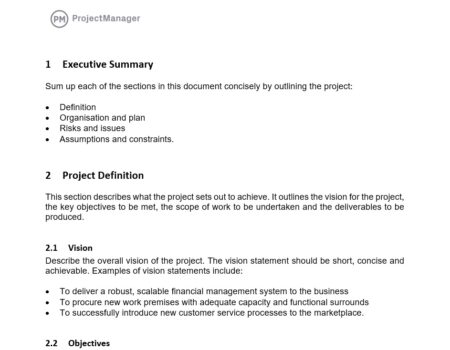
A business case is used to explain why the proposed project is justified. It shows that the project is worth the investment of time and money. It’s more commonly used in larger companies in the decision-making process when prioritizing one project over another.
The business case answers the questions: what is the project, why should it be taken up, who will be involved and how much will it cost? It’s therefore related to a project proposal, but the project proposal comes before the business case and is usually part of the larger proposal.
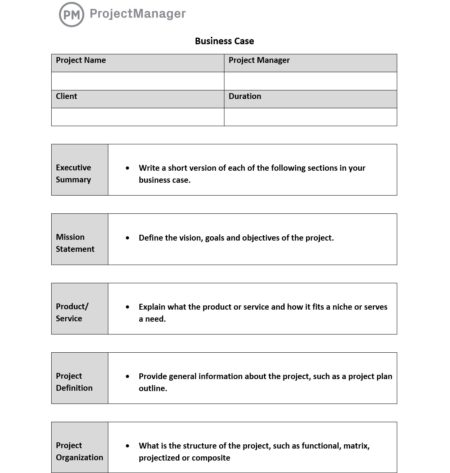
Again, the project proposal and the project plan in this case are very similar documents. It’s understandable that there would be some confusion between these two project terms. They both show how the project will be run and what the results will be. However, they’re not the same.
The project proposal is a document that aims to get a project approved and funded. It’s used to convince stakeholders of the viability of the project and their investment. The project plan, on the other hand, is made during the planning phase of the project, once it’s been approved. It’s a detailed outline of how the project will be implemented, including schedule, budget, resources and more.

There are several key operational and strategic questions to consider, including:
- Executive summary: This is the elevator pitch that outlines the project being proposed and why it makes business sense. While it also touches on the information that’ll follow in the project proposal, the executive summary should be brief and to the point.
- Project background: This is another short part of the proposal, usually only one page, which explains the problem you’ll solve or the opportunity you’re taking advantage of with the proposed project. Also, provide a short history of the business to put the company in context to the project and why it’s a good fit.
- Project vision & success criteria: State the goal of the project and how it aligns with the goals of the company. Be specific. Also, note the metrics used to measure the success of the project.
- Potential risks and mitigation strategies: There are always risks. Detail them here and what strategies you’ll employ to mitigate any negative impact as well as take advantage of any positive risk.
- Project scope & deliverables: Define the project scope, which is all the work that has to be done and how it will be done. Also, detail the various deliverables that the project will have.
- Set SMART goals: When setting goals, be SMART. That’s an acronym for specific, measurable, achievable, relevant and time-bound. All your goals would be defined by those five things.
- Project approach: Define the approach you’ll use for the contract. There are several different types of contracts used in construction , for example, such as lump sum, cost plus, time and materials, etc. This is also a good place to describe the delivery method you’ll use.
- Expected benefits: Outline the benefits that will come from the successful completion of the project.
- Project resource requirements: List the resources, such as labor, materials, equipment, etc., that you’ll need to execute the project if approved.
- Project costs & budget: Detail all the costs, including resources, that’ll be required to complete the project and set up a budget to show how those costs will be spent over the course of the project.
- Project timeline: Lay out the project timeline , which shows the project from start to finish, including the duration of each phase and the tasks within it, milestones, etc.
In addition to these elements, it’s advisable to use a cover letter, which is a one-page document that helps you introduce your project proposal and grab the attention of potential clients and stakeholders.
To make the best proposal possible, you’ll want to be thorough and hit on all the points we’ve listed above. Here’s a step-by-step guide to writing a persuasive priority proposal.
1. Write an Executive Summary
The executive summary provides a quick overview of the main elements of your project proposal, such as your project background, project objectives and project deliverables, among other things. The goal is to capture the attention of your audience and get them excited about the project you’re proposing. It’s essentially the “elevator pitch” for the project life cycle. It should be short and to the point.
The executive summary should be descriptive and paint a picture of what project success looks like for the client. Most importantly, it should motivate the project client; after all, the goal is getting them to sign on the dotted line to get the project moving!
2. Provide a Project Background
The project background is a one-page section of your project proposal that explains the problem that your project will solve. You should explain when this issue started, its current state and how your project will be the ideal solution.
- Historic data: The history section outlines previously successful projects and those that could have run more smoothly. By doing so, this section establishes precedents and how the next project can be more effective using information from previous projects.
- Solution: The solution section addresses how your project will solve the client’s problem. Accordingly, this section includes any project management techniques , skills and procedures your team will use to work efficiently.
3. Establish a Project Vision & Success Criteria
You’ll need to define your project vision. This is best done with a vision statement, which acts as the north star for your project. It’s not specific as much as it’s a way to describe the impact your company plans to make with the project.
It’s also important to set up success criteria to show that the project is in fact doing what it’s proposed to do. Three obvious project success criteria are the triple constraint of cost, scope and time. But you’ll need to set up a way to measure these metrics and respond to them if they’re not meeting your plan.
4. Identify Potential Risks and Mitigation Strategies
To reduce the impact of risk in your project, you need to identify what those risks might be and develop a plan to mitigate them . List all the risks, prioritize them, describe what you’ll do to mitigate or take advantage of them and who on the team is responsible for keeping an eye out for them and resolving them.
5. Define Your Project Scope and Project Deliverables
The project scope refers to all the work that’ll be executed. It defines the work items, work packages and deliverables that’ll be delivered during the execution phase of your project life cycle. It’s important to use a work breakdown structure (WBS) to define your tasks and subtasks and prioritize them.
6. Set SMART Goals for Your Project Proposal
The best mindset when developing goals and objectives for your project proposal is to use the SMART system :
- Specific – Make sure your goals and objectives are clear, concise and specific to the task at hand.
- Measurable – Ensure your goals and objectives are measurable so it’s obvious to see when things are on track and going well, and conversely, when things are off track and issues need to be addressed. Measurable goals make it easy to develop the milestones you’ll use to track the progress of the project and identify a reasonable date for completion and/or closure.
- Attainable – It’s important every project has a “reach” goal. Hitting this goal would mean an outstanding project that extends above and beyond expectations. However, it’s important that the project’s core goal is attainable, so morale stays high and the job gets done with time and resources to spare.
- Relevant – Make sure all of your goals are directly relevant to the project and address the scope within which you’re working.
- Time-Based – Timelines and specific dates should be at the core of all goals and objectives. This helps keep the project on track and ensures all project team members can manage the work that’s ahead of them.
7. Explain What’s Your Project Approach
Your project approach defines the project management methodology , tools and governance for your project. In simple terms, it allows project managers to explain to stakeholders how the project will be planned, executed and controlled successfully.
8. Outline The Expected Benefits of Your Project Proposal
If you want to convince internal stakeholders and external investors, you’ll need to show them the financial benefits that your project could bring to their organization. You can use cost-benefit analysis and projected financial statements to demonstrate why your project is profitable.
9. Identify Project Resource Requirements
Project resources are critical for the execution of your project. The project proposal briefly describes what resources are needed and how they’ll be used. Later, during the planning phase, you’ll need to create a resource management plan that’ll be an important element of your project plan. Project requirements are the items, materials and resources needed for the project. This section should cover both internal and external needs.
10. Estimate Project Costs and Project Budget
All the resources that you’ll need for your project have a price tag. That’s why you need to estimate those costs and create a project budget . The project budget needs to cover all your project expenses, and as a project manager, you’ll need to make sure that you adhere to the budget.
11. Define a Project Timeline
Once you’ve defined your project scope, you’ll need to estimate the duration of each task to create a project timeline. Later during the project planning phase , you’ll need to create a schedule baseline, which estimates the total length of your project. Once the project starts, you’ll compare your actual project schedule to the schedule baseline to monitor progress.
Now let’s explore some project proposal examples to get a better understanding of how a project proposal would work in the real world. For this example, let’s imagine a city that’s about to build a rapid transit system. The city government has the funds to invest but lacks the technical expertise and resources that are needed to build it, so it issues a request for proposal (RFP) document and sends it to potential builders.
Then, the construction companies that are interested in executing this rapid transit project will prepare a project proposal for the city government. Here are some of the key elements they should include.
- Project background: The construction firm will provide an explanation of the challenges that the project presents from a technical perspective, along with historical data from similar projects that have been completed successfully by the company.
- Project vision & success criteria: Write a vision statement and explain how you’ll track the triple constraint to ensure the successful delivery of the project.
- Potential risks and mitigation strategies: List all risks and how they’ll be mitigated, and be sure to prioritize them.
- Project scope & deliverables: The work that’ll be done is outlined in the scope, including all the deliverables that’ll be completed over the life cycle of the project.
- Set SMART goals: Use the SMART technique to define your project goals by whether they’re specific, measurable, achievable, relevant and time-bound.
- Project approach: Define the methodology that the project manager will employ to manage the project. Also, figure out what type of contract will be used to define the project.
- Expected benefits: Show how the project will deliver advantages to the company and define what these benefits are in a quantifiable way.
- Project resource requirements: List all the resources, such as labor, materials, equipment, etc., needed to execute the project.
- Project costs & budget: Estimate the cost of the project and lay that out in a project budget that covers everything from start to finish.
- Project timeline: Outline the project schedule, including phases, milestones and task duration on a visual timeline.
Whatever project proposal you’re working on, there are a few tips that apply as best practices for all. While above we suggested a project proposal template that would have a table of contents, meaning it would be many pages long, the best-case scenario is keeping the proposal to one or two pages max. Remember, you’re trying to win over stakeholders, not bore them.
Speaking of project stakeholders , do the research. You want to address the right ones. There’s no point in doing all the work necessary to write a great proposal only to have it directed to the wrong target audience. Whoever is going to read it, though, should be able to comprehend the proposal. Keep the language simple and direct.
When it comes to writing, get a professional. Even a business document like a project proposal, business case or executive summary will suffer if it’s poorly constructed or has typos. If you don’t want to hire a professional business writer, make sure you get someone on your project team to copy, edit and proof the document. The more eyes on it, the less likely mistakes will make it to the final edition.
While you want to keep the proposal short and sweet, it helps to sweeten the pot by adding customer testimonials to the attachments. Nothing sells a project plan better than a customer base looking for your product or service.
ProjectManager & Project Proposals
ProjectManager allows you to plan proposals within our software. You can update tasks for the project proposal to signify where things stand and what’s left to be done. The columns allow you to organize your proposal by section, creating a work breakdown structure (WBS) of sorts.
When building a project proposal, it’s vital to remember your target audience. Your audience includes those who are excited about the project, and see completion as a gain for their organization. Conversely, others in your audience will see the project as a pain and something to which they aren’t looking forward. To keep both parties satisfied, it’s essential to keep language factual and concise.
Our online kanban boards help you think through that language and collaborate on it effectively with other team members, if necessary. Each card shows the percentage completed so everyone in the project management team is aware of the work done and what’s left to be done.

As you can see from the kanban board above, work has begun on tasks such as product documentation and design. Tasks regarding stakeholder feedback, ideation, market research and more have been completed, and there’s a good start on the engineering drawings, 3D rendering, supply chain sourcing and translation services.
A PDF is then attached to the card, and everyone added to the task receives an email notifying them of the change. This same process can be used throughout the life-cycle of the project to keep the team updated, collaborating, and producing a first-class project proposal. In addition to kanban boards, you can also use other project management tools such as Gantt charts , project dashboards, task lists and project calendars to plan, schedule and track your projects.
Project proposals are just the first step in the project planning process. Once your project is approved, you’ll have to solidify the plan, allocate and manage resources, monitor the project, and finally hand in your deliverables. This process requires a flexible, dynamic and robust project management software package. ProjectManager is online project management software that helps all your team members collaborate and manage this process in real-time. Try our award-winning software with this free 30-day trial .

Deliver your projects on time and on budget
Start planning your projects.
Home Blog Business Consulting Presentation Slides: A Guide to PPT Consultant Tools
Consulting Presentation Slides: A Guide to PPT Consultant Tools
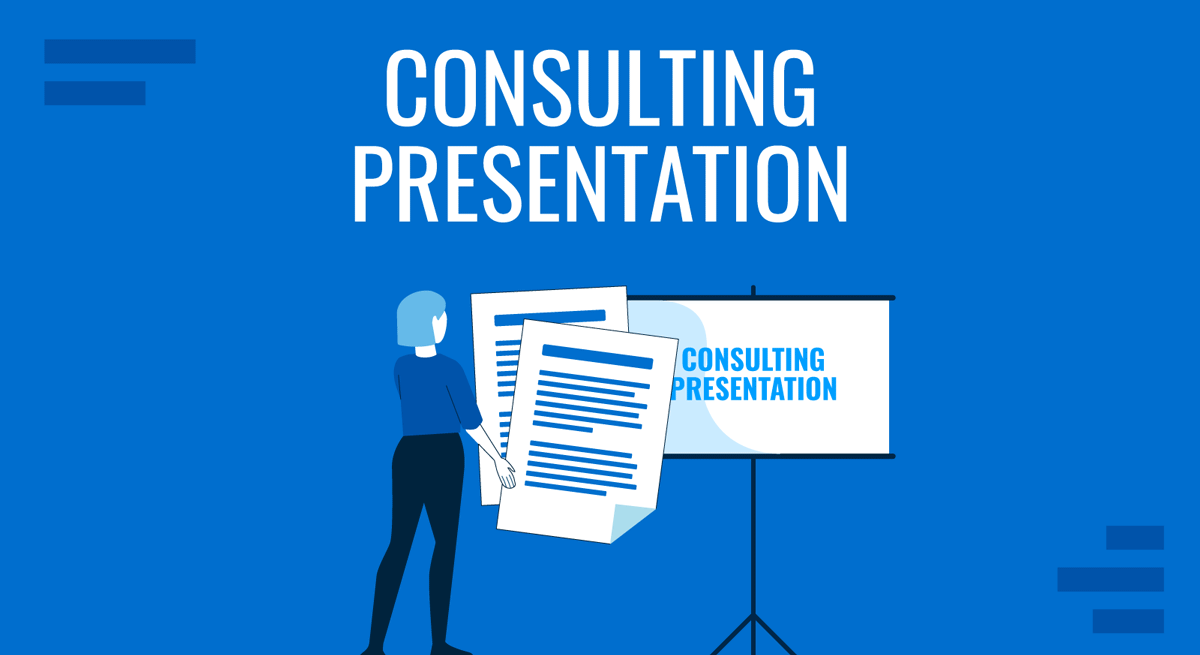
Consulting presentations are the foundation of professional communication in disciplines like strategic planning, management, and corporate decision-making. Notably, firms like McKinsey & Company, Boston Consulting Group (BCG), and other leading management consulting firms have mastered the art of creating effective slide decks to a level where these presentations are not just tools but strategic assets.
Fundamentally, consultant presentation slides allow business professionals to share insights, recommendations, and any kind of complex data in a coherent, visual, engaging format that facilitates understanding [3]. In this article, we will explore what defines a consulting presentation, what a consulting slide deck is, and the types of templates we can implement in our daily work lives for this purpose.
Table of Contents
What is a Consulting Presentation?
What is a consulting presentation template, types of consulting presentation slides, final words.
A consulting presentation is a carefully structured visual tool consultants use to communicate analyses, findings, and recommendations to clients. It synthesizes complex information into digestible, visually engaging slides that facilitate understanding and decision-making [1]. Typically, these presentations are grounded in rigorous research and analysis and aim to address specific client challenges or opportunities.
Consulting presentations serve multiple purposes: to inform, persuade, and provide a clear path forward based on data-driven insights and strategic thinking. The effectiveness of a consulting presentation lies in its ability to make the complex simple, turn data into narratives, and inspire action among its audience, which often includes key stakeholders and decision-makers within an organization.
We can define a consulting presentation template as a slide or slide deck tailored to create assets inside consulting presentations. These templates can depict graphs, diagrams, roadmaps, dashboards, strategies, etc. Presenters can mix and match templates from different styles, modify their PowerPoint theme, customize the content, and get it ready to create a unique slide deck for a consultancy report.
In this section, we will group the different consultancy presentation templates by category. Remember that McKinsey presentations, BCG slides, and other popular consulting deck options are made from these tools.
Strategy Consulting Templates
Strategy consulting templates are visual tools designed to assist in developing and presenting business strategies. They facilitate a systematic approach to analyzing market conditions, competitive landscapes, and internal capabilities to make strategic decisions. McKinsey slide decks are fine examples of this category.
Market Analysis and Competitive Landscape
Whenever we use market analysis or competitive landscape templates, we aim to present research on market trends, customer behavior, and competitive landscapes. To name a few potential options, we can work with a Go-To-Market template outlining the target market, value proposition, marketing and sales strategies, distribution channels, and competitive analysis of a product or service release.
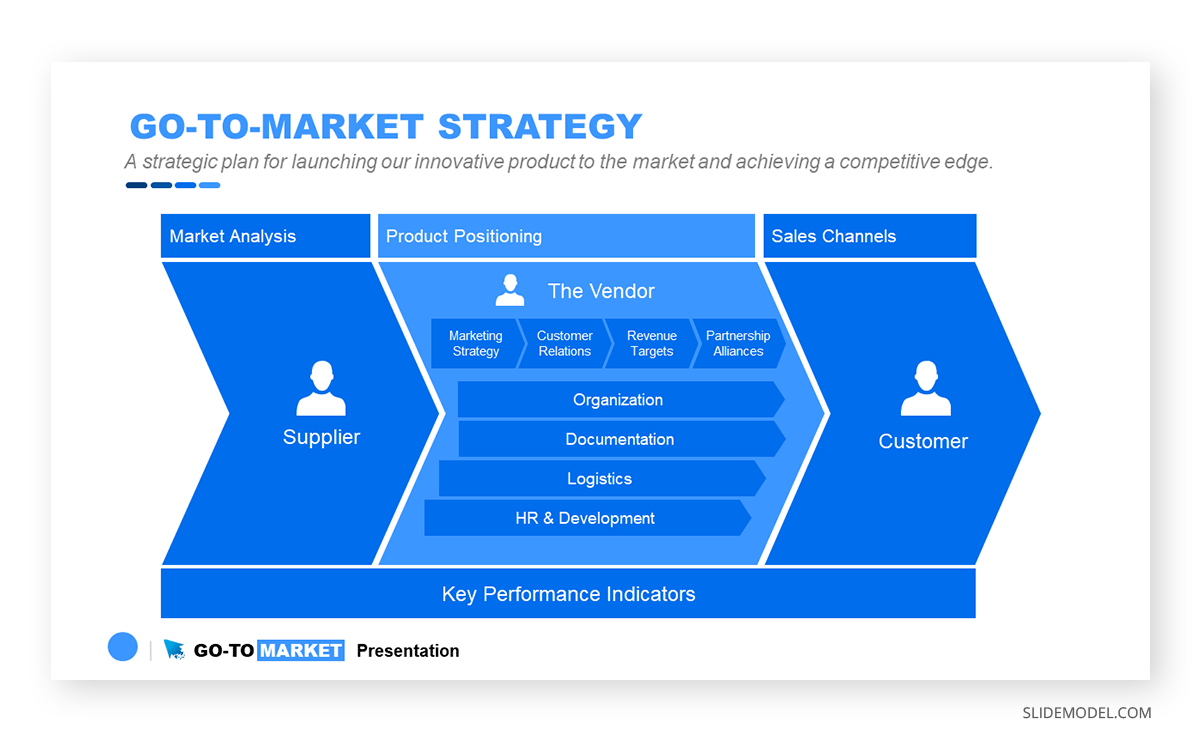
A second option would be to work with a Sales Battlecard , a concise, strategic document used by sales teams to understand and communicate the key features, benefits, and differentiators of their product or service compared to competitors. It’s designed to equip sales representatives with quick references and talking points highlighting competitive advantages and addressing potential objections during sales conversations. For this reason, it can be instrumental in consulting presentations to develop new sales strategies for your operators.
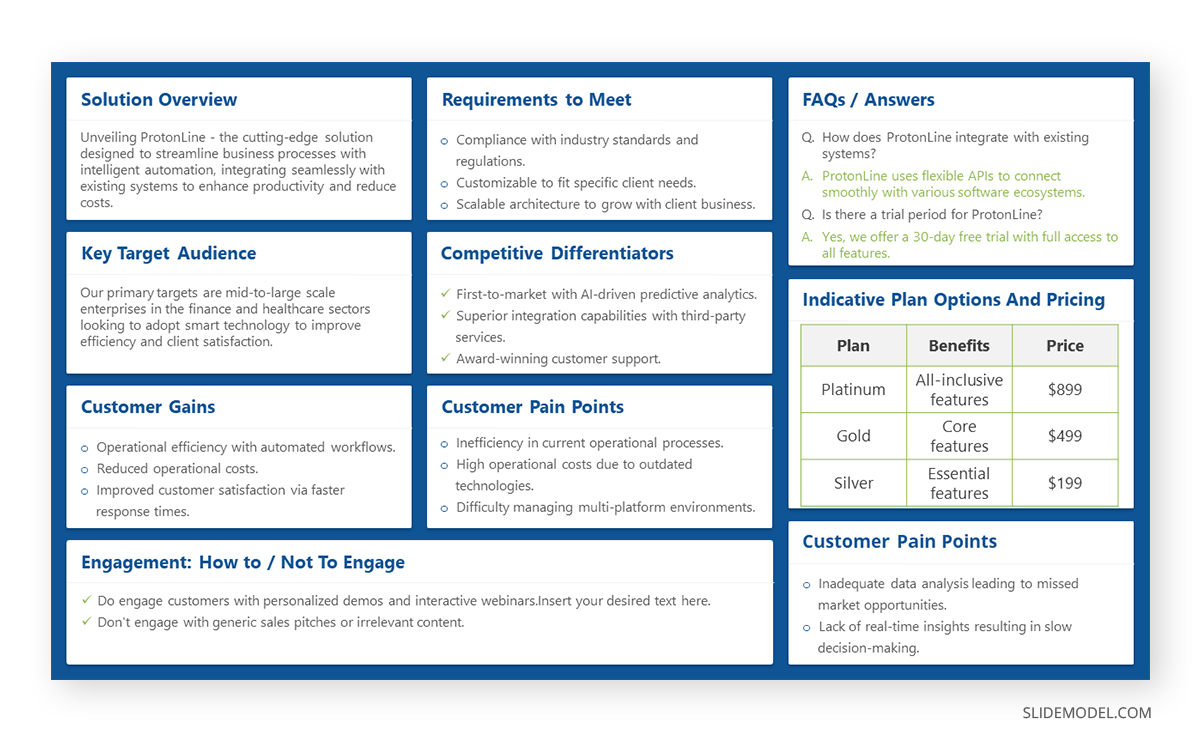
A third option is to implement a Competitive Landscape slide in the format of a competitor matrix to identify the leading competitors and understand their products, strategies, strengths, weaknesses, market share, and positioning. By analyzing competitors’ performance and strategies, a business can better position itself, differentiate its offerings, anticipate competitor moves, and identify areas for growth and improvement.

Business Model Canvas
The business model canvas evaluates a company’s value proposition, infrastructure, customers, and finances. Therefore, it helps businesses align their activities by illustrating potential trade-offs. The canvas includes nine key components: Key Partners, Key Activities, Key Resources, Value Propositions, Customer Relationships, Channels, Customer Segments, Cost Structure, and Revenue Streams.
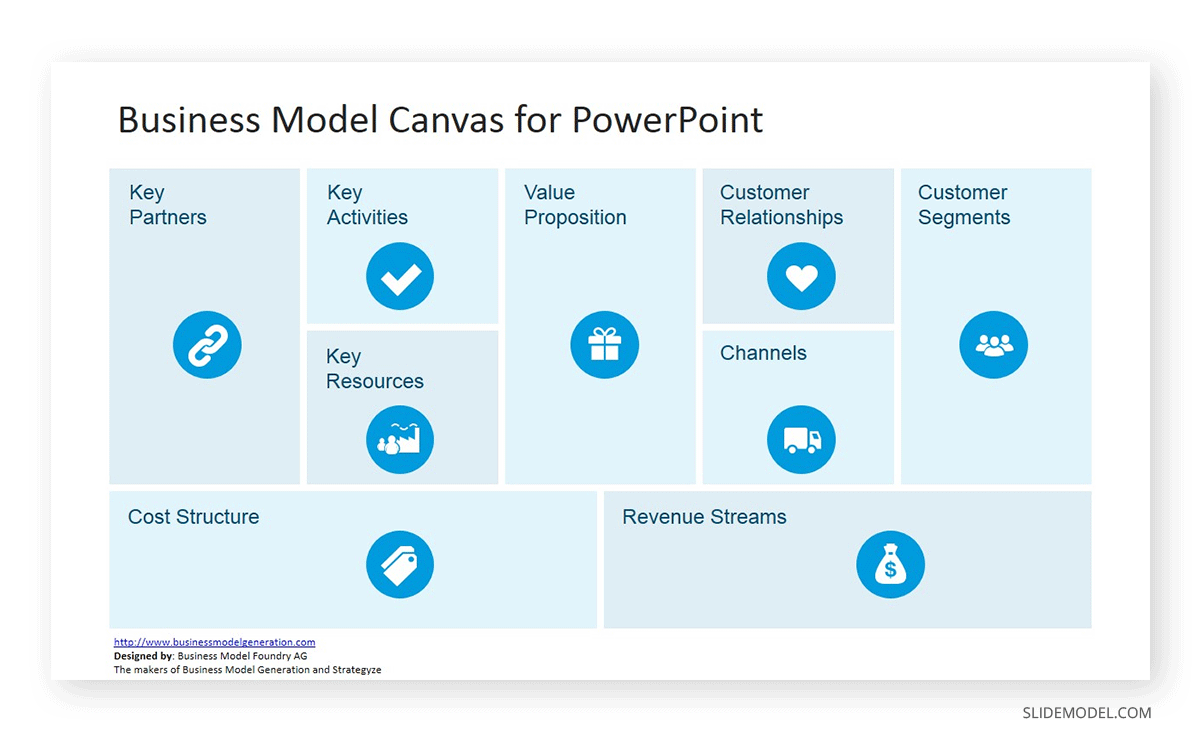
If you seek a creative option, try this layout alternative to the typical business model canvas PPT template.

SWOT Analysis (Strengths, Weaknesses, Opportunities, Threats)
The SWOT analysis framework is a popular tool across presenters as it can be repurposed for any industry. They allow us to provide a comprehensive overview of the current strategic situation for consultancy presentations. Organizations can then leverage strengths and opportunities while addressing weaknesses and mitigating threats.
Some options of SWOT Analysis PPT templates include:
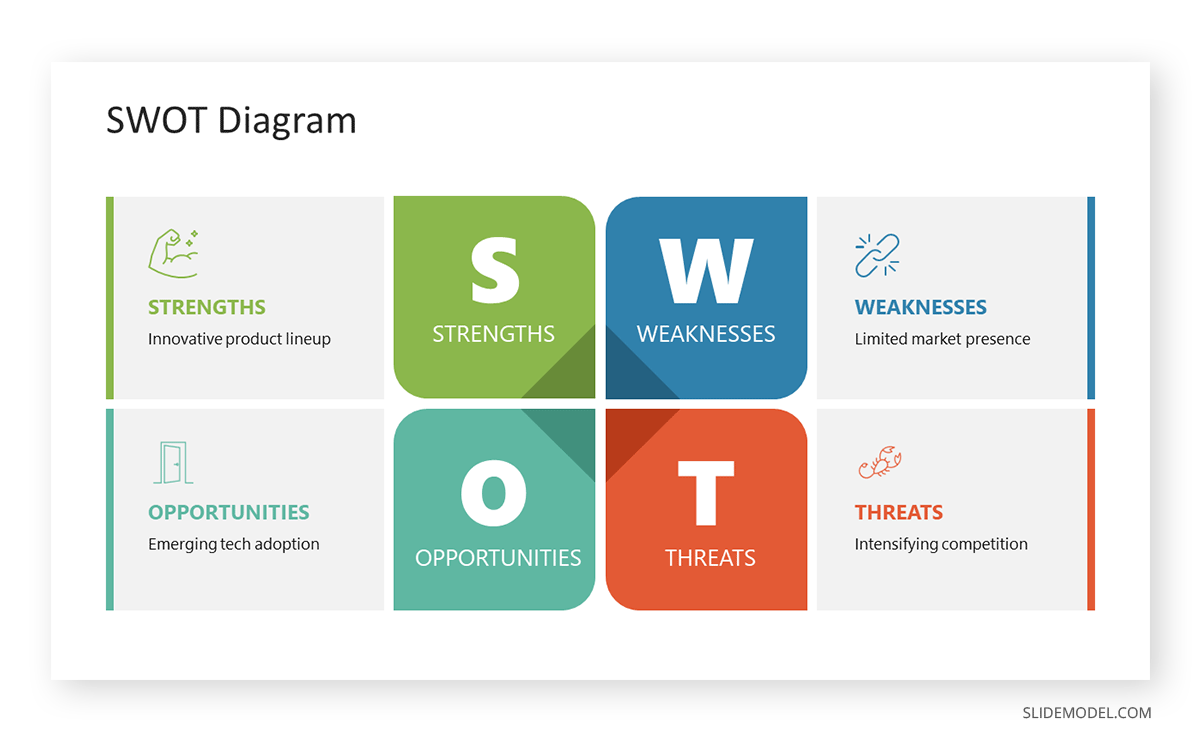
Porter’s Five Forces Analysis
Porter’s Five Forces is a framework developed by Michael E. Porter that analyzes the industry structure and corporate strategy. It identifies the intensity of competition and attractiveness of a market through five forces: Competitive Rivalry, Threat of New Entrants, Threat of Substitute Products or Services, Bargaining Power of Suppliers, and Bargaining Power of Buyers. In consulting presentations, this framework is instrumental for several reasons:
- Industry Analysis and Strategic Planning: This tool allows us to get a comprehensive overview of the external environment, which helps customers understand an industry’s dynamics. It will also enable consultants to identify where power lies in business situations, guiding the decision-making toward profitability and competitiveness. You can find some McKinsey slides examples covering this approach [2].
- Assessment of Profitability Potential: A market with weak forces suggests higher profitability potential, while solid forces may signal a competitive and challenging market.
- Investment Decisions: For clients considering entering new markets or industries, Porter’s Five Forces can guide investment decisions by highlighting the barriers to entry, the potential for rivalry, and other critical factors influencing the sector’s attractiveness.
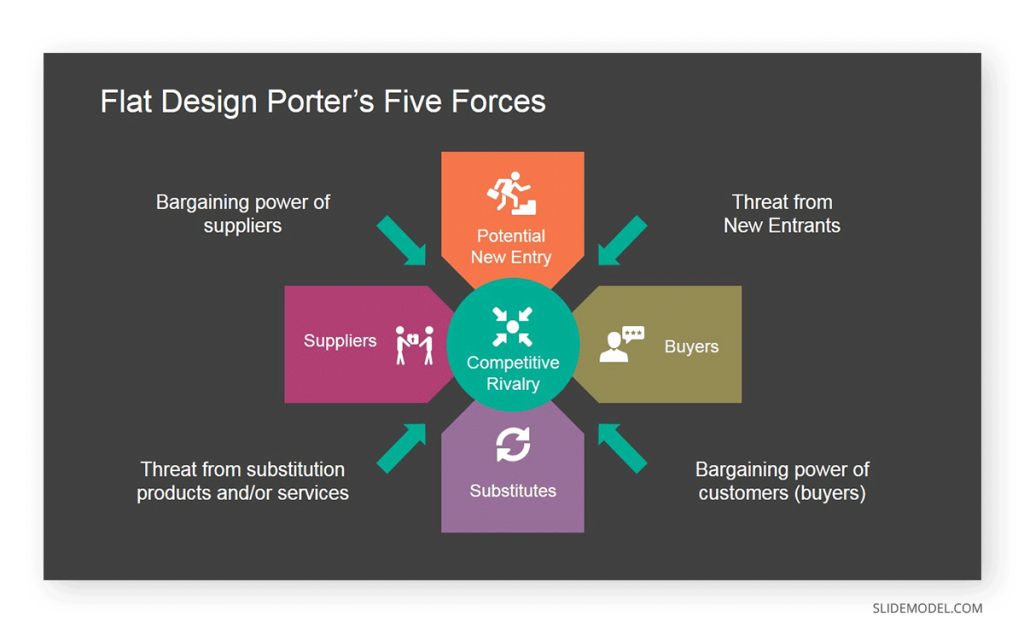
Blue Ocean Strategy
The Blue Ocean Strategy , developed by W. Chan Kim and Renée Mauborgne, is a business strategy that encourages companies to create new demand in an uncontested market space, or a “Blue Ocean,” rather than competing head-to-head with other companies in an existing industry, or “Red Ocean.” This approach focuses on innovation, differentiation, and creating value for both the company and its customers, leading to new opportunities for growth.
Consultants can apply this framework to encourage clients to explore new, uncontested markets. Another approach is to emphasize the importance of the unique value proposition.
Presenters can also combine this tool with strategic planning to boost organizational innovation.
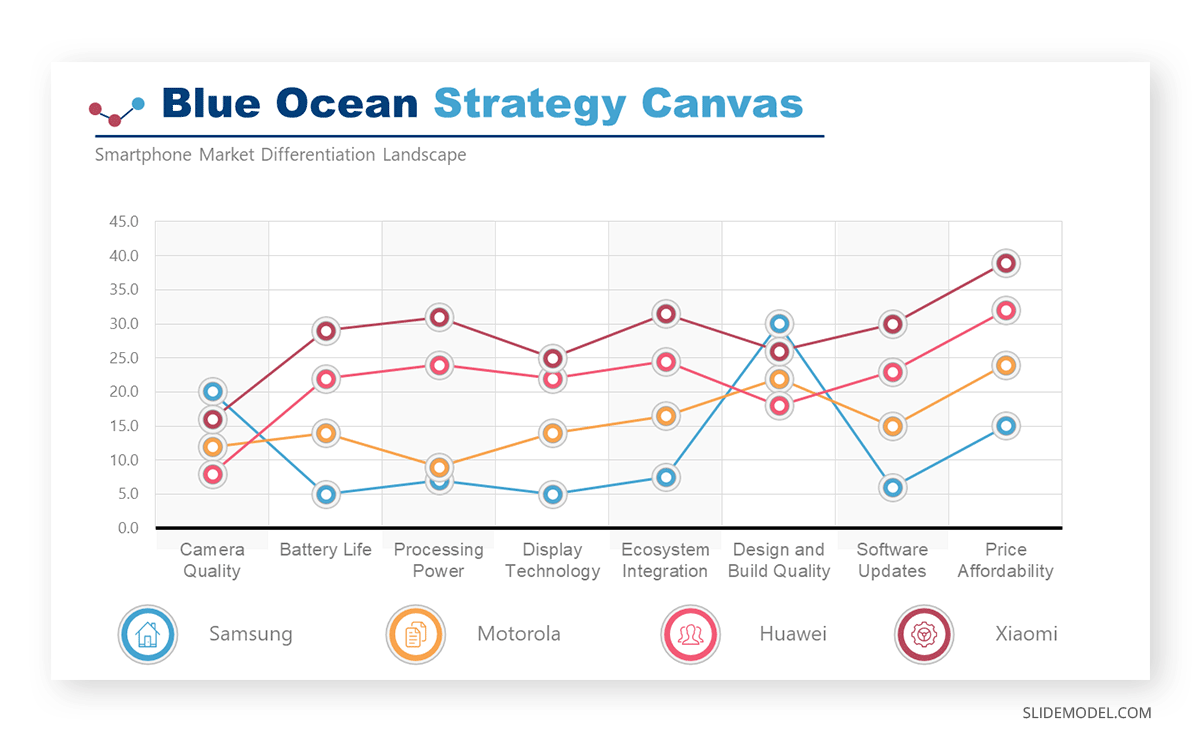
Strategy Roadmap
To implement the strategies defined in a plan, consulting firm presentations must use graphic methods to clearly depict the different stages. This is where Strategic Roadmaps become valuable resources for consulting presentations. We can use the road metaphor for the roadmap, work with timelines, or use any other visual tool to depict a segmented plan.
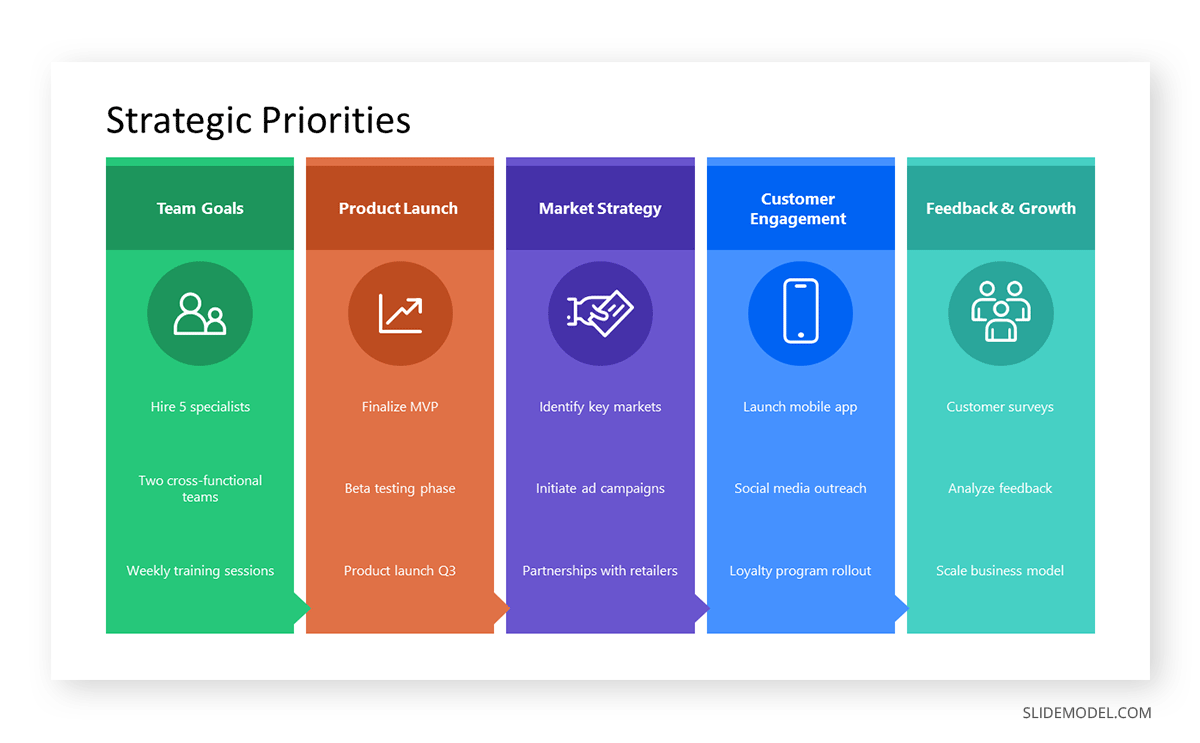
Operations Consulting Templates
Operations consulting templates are visual tools designed to showcase the analysis and improvement of business processes and operations. Business professionals can use these graphic elements in presentations to identify bottlenecks, waste, and opportunities for improvement. In short, operations consulting templates enable consultants to deliver actionable recommendations that enhance operational performance.
Supply Chain Management
Supply Chain Management (SCM) is a critical element in Operations as it involves overseeing/managing the flow of goods and services, from raw materials to delivered products to the customer. Working with SCM templates helps consultants present tailored reports about supply chain processes and their inefficiencies: bottlenecks, sub-optimized stages, etc. Consequently, organizations can work on cost-reduction strategies, leverage IoT technologies, and aim for sustainable practices.
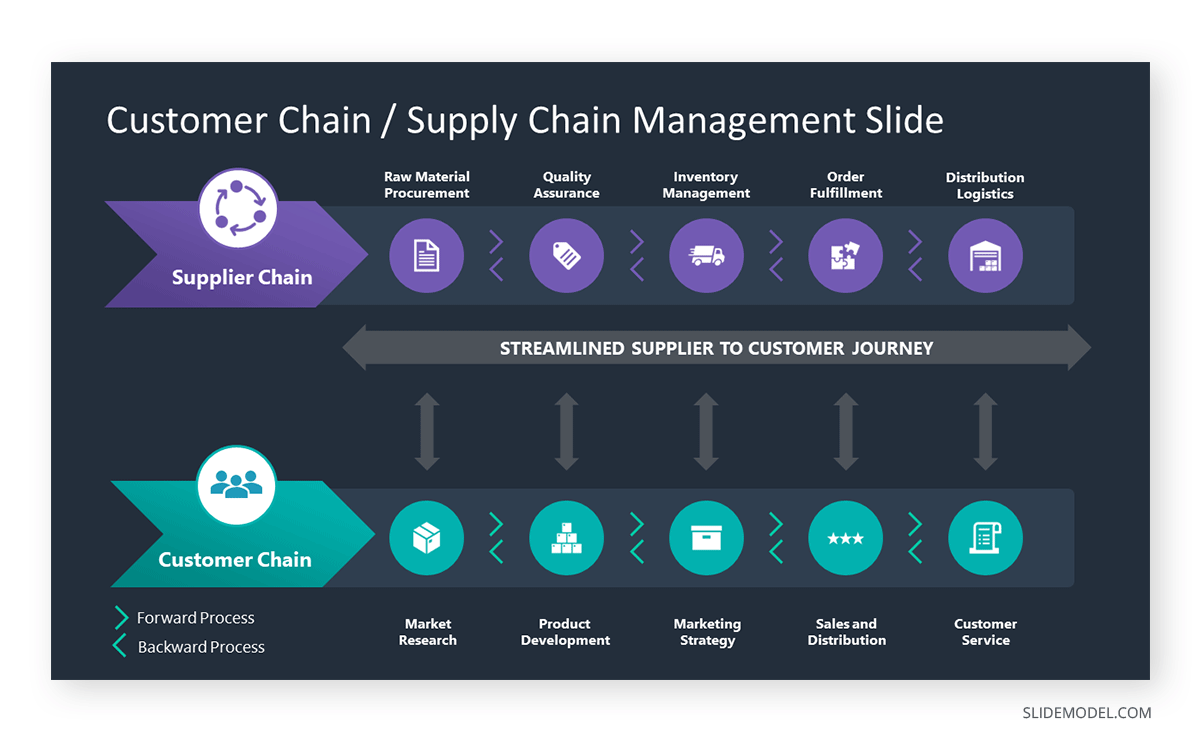
Lean Management and Six Sigma
Presenters can use a multitude of slides to discuss lean management or Six Sigma processes, but above all, two elements stand out: the DMAIC and the SIPOC diagram .
The DMAIC diagram can be used for multiple cases in consulting presentations. One option would be presenting a case study where defining the project scope led to targeted improvements, illustrating how a similar focus could benefit the client. For companies already implementing Six Sigma strategies, consultants can share benchmark data and metrics from past projects during the Measure phase, showing how precise measurement informed the strategy. Or discuss an Analyze phase from a previous engagement where deep data analysis revealed unexpected insights, suggesting a thorough examination could uncover similar opportunities for the client.
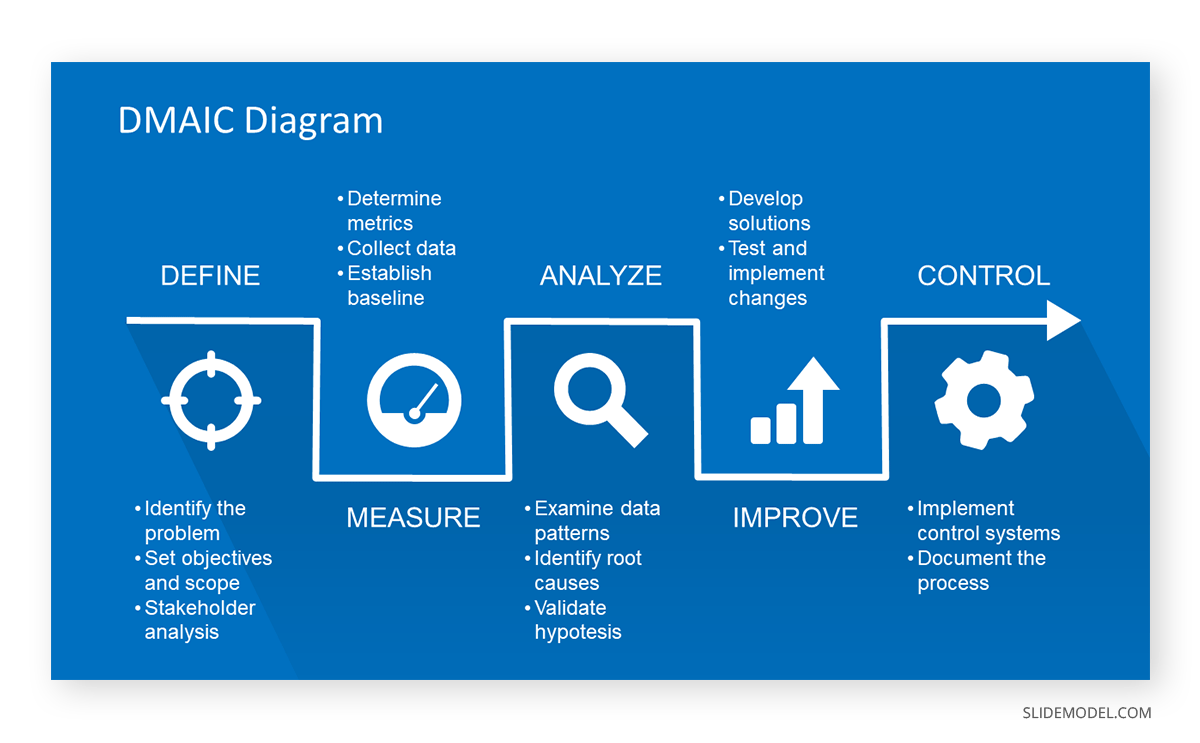
In turn, the SIPOC diagram can visually summarize a process by mapping out its key components, aiding in understanding and communication with the client. Consultants can highlight specific segments of the SIPOC diagram to pinpoint where inefficiencies or issues occur, directing focus to areas with the most significant potential for improvement. Another use in consulting presentations is before implementing changes, as the SIPOC diagram can capture the current state of a process as a baseline, making it easier to measure the impact of improvements post-implementation.
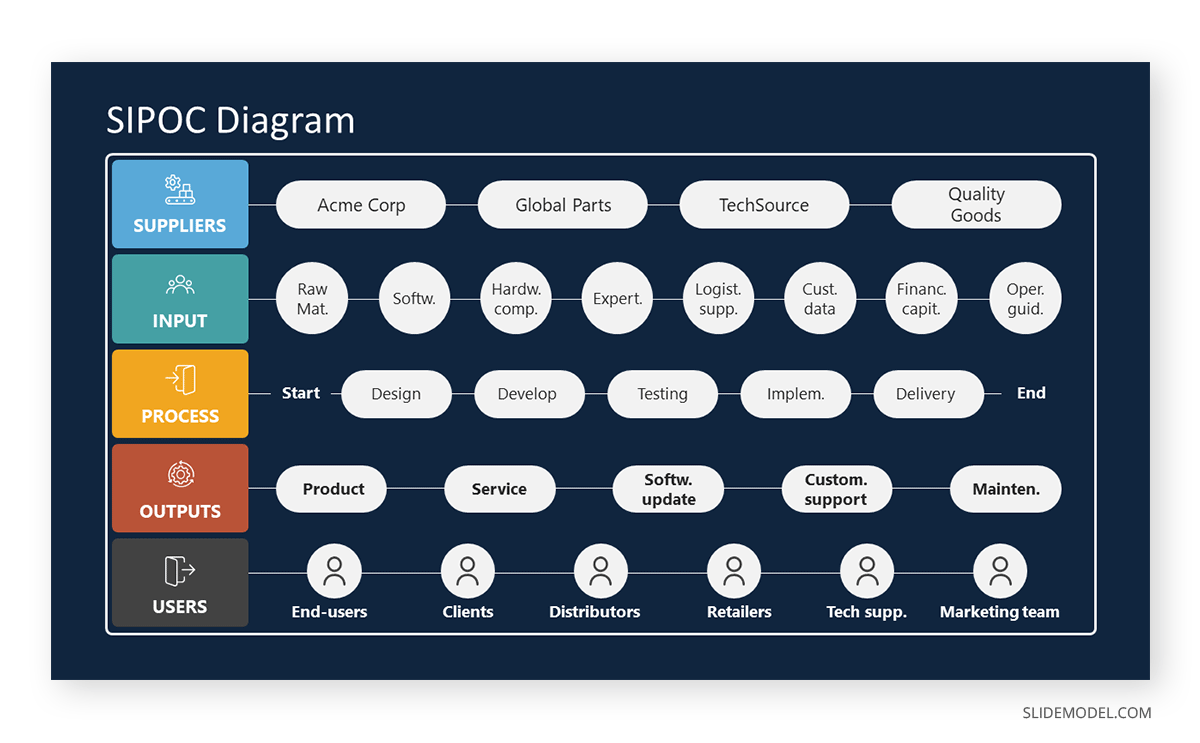
Performance Dashboard
As the final element in this category, consultants are often hired to analyze a company’s performance. This is where Performance Dashboard PPT templates shine, offering a visual method to share condensed data extracted from analysis. The performance dashboard can reflect sales operations, logistics, marketing engagement rate, and plenty of other options. It’s a versatile tool that can be customized to track different metrics.
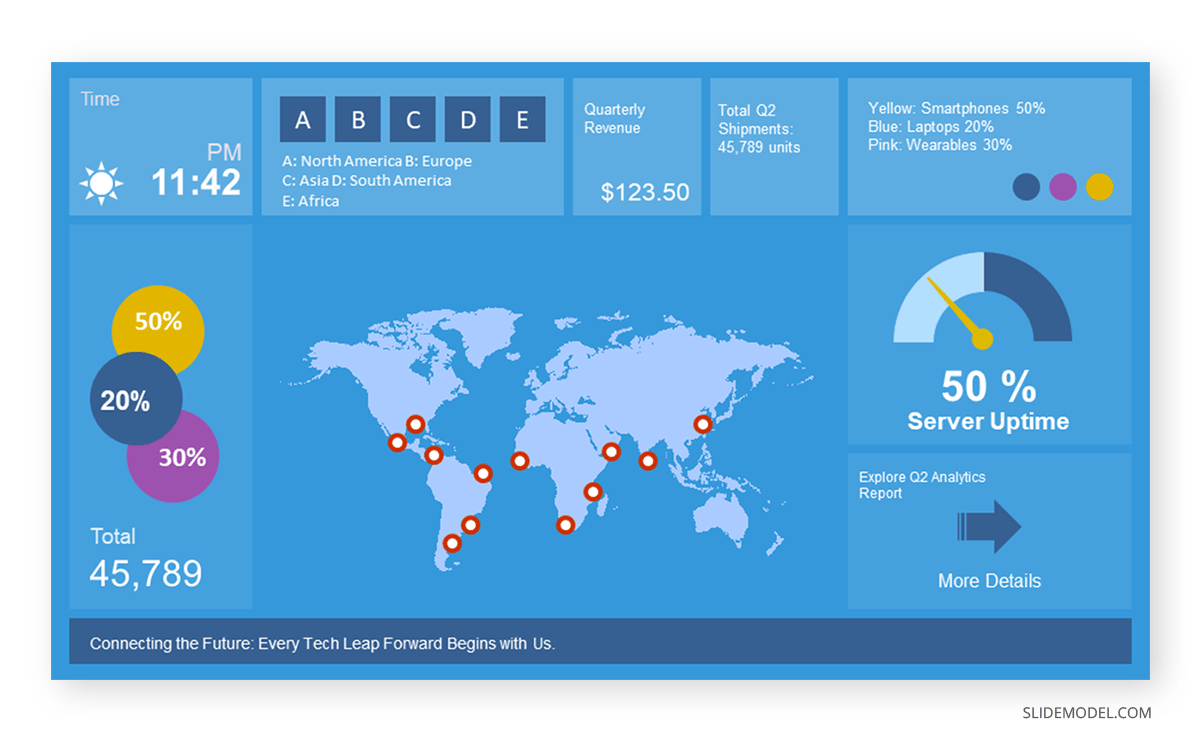
Financial Consulting Templates
Financial consulting templates help consultants guide the analysis and presentation of financial data, strategies, and recommendations. They enable systematically reviewing and communicating aspects of financial health, including performance analysis, budgeting, forecasting, and investment strategies. Elements like financial ratios, cash flow analysis, and cost-benefit assessments are typical examples, allowing for a comprehensive evaluation of financial stability and growth opportunities.
Financial Performance Analysis
Several tools can be used to conduct a financial performance analysis in a consulting presentation. The typical options are the Profit & Loss (P&L), financial dashboards, and performance review templates.
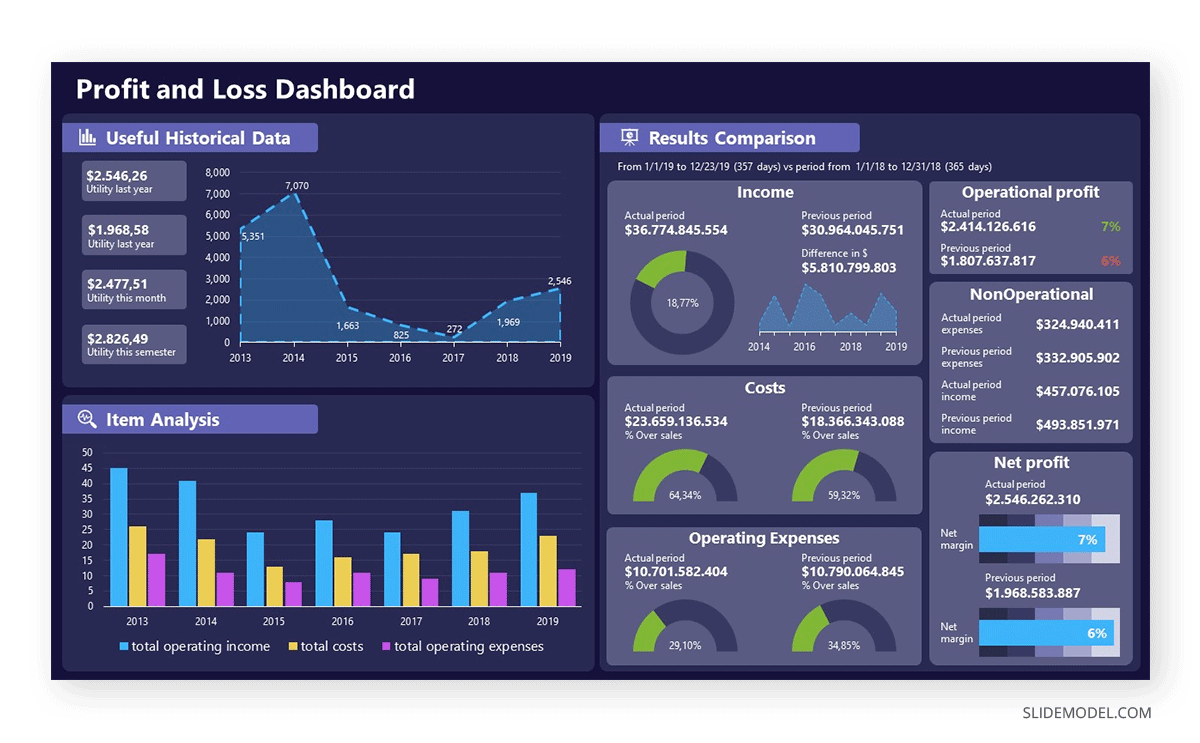
Cost Reduction Strategies
These templates showcase proposed strategies to minimize operational costs and increase overall profit. We can select the preferred presentation template depending on the company’s size, operational complexity, and other variables. Here, we leave you two potential options.
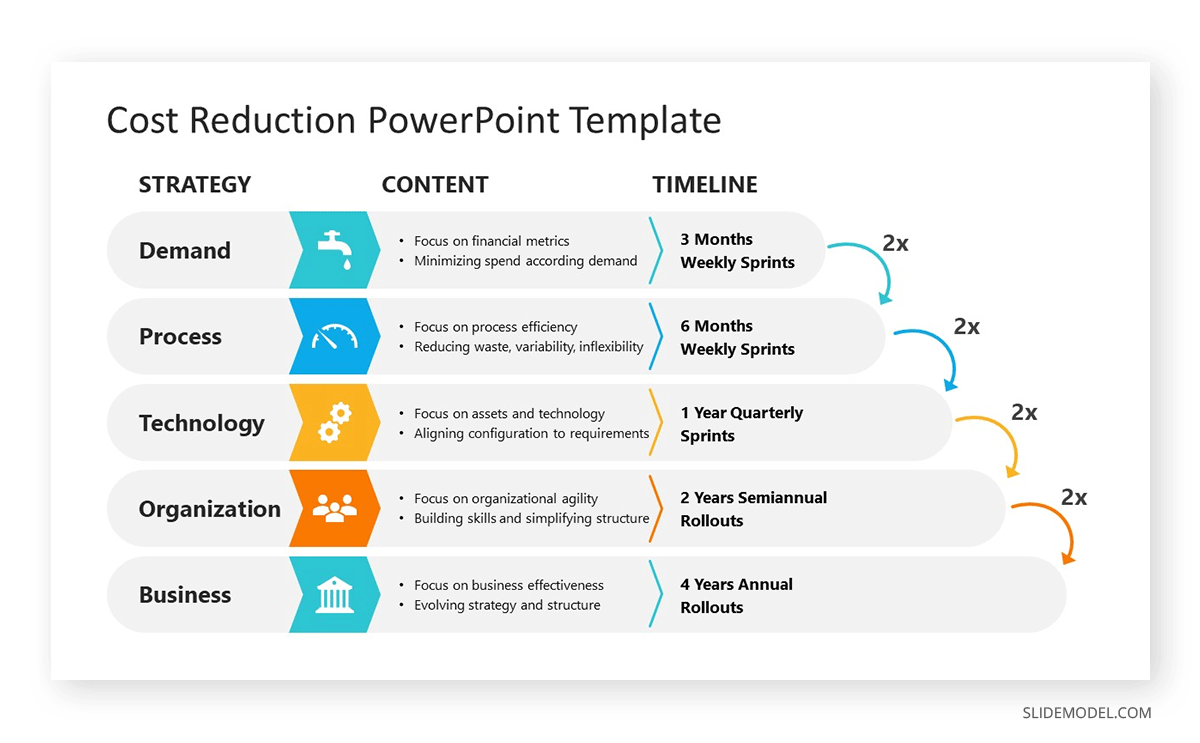
Investment Appraisal
The Investment Appraisal slide deck contains tools to evaluate the viability and profitability of proposed investments or projects. Although you can find some valuable tools for this in the format of Porter’s Five Forces, DMAIC and SIPOC, and SWOT analysis, it’s best to work with tailored slide decks for investment and financial projects.
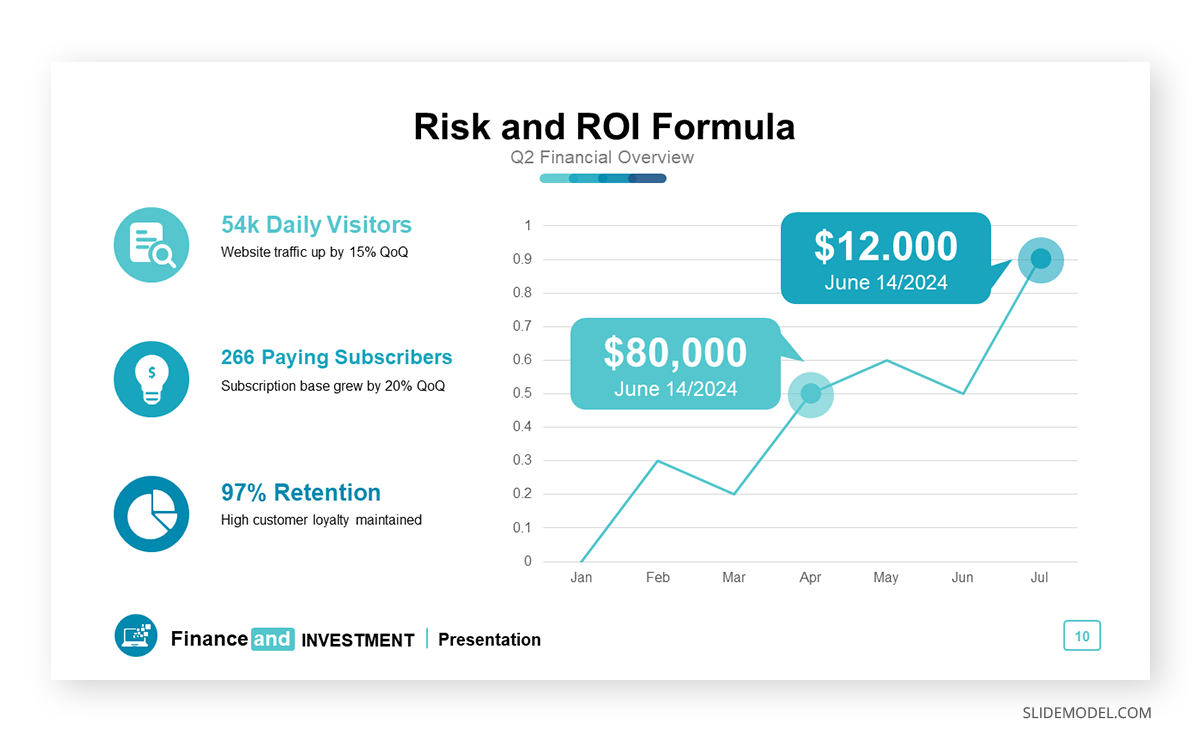
Mergers & Acquisitions (M&A) Strategy
Business deals and negotiations regarding mergers or company acquisitions should be handled carefully. Consultants addressing clients about these two situations must communicate clearly, simplify the steps to follow, define the best practices to complete the process smoothly and define how to communicate with the personnel. You can check our Business Partnership PowerPoint template for a well-rounded framework for consultants to discuss these topics.
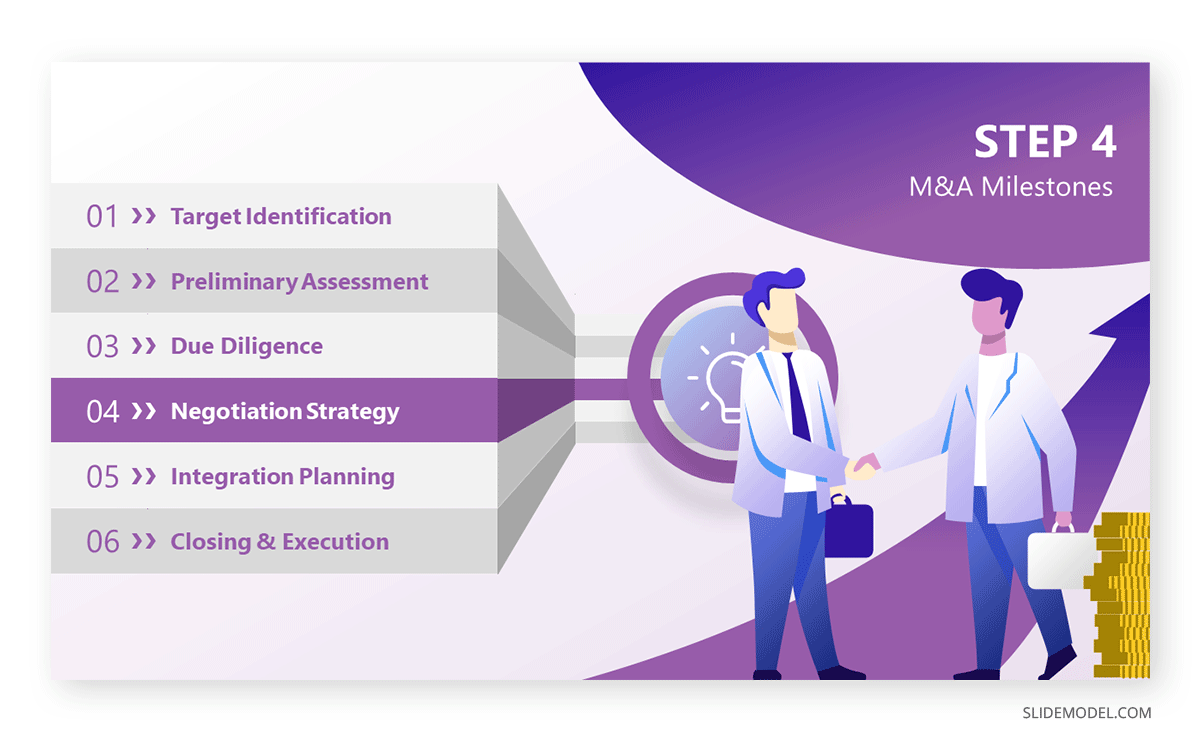
Financial Modeling Overview
We can work with plenty of templates for this last element to discuss financial modeling. For instance, the P&L model is a good fit in this category, but we can broaden our horizons – depending on the type of analysis – by using tools like the ones below.
The Efficient Frontier Curve is a concept from portfolio theory. It illustrates the set of optimal portfolios that offer the highest expected return for a given level of risk or the lowest risk for a given level of expected return. As part of a financial model overview, it can help investors understand the risk-return trade-off of different investment portfolios, aiding in selecting an investment strategy that aligns with their risk tolerance and return objectives.
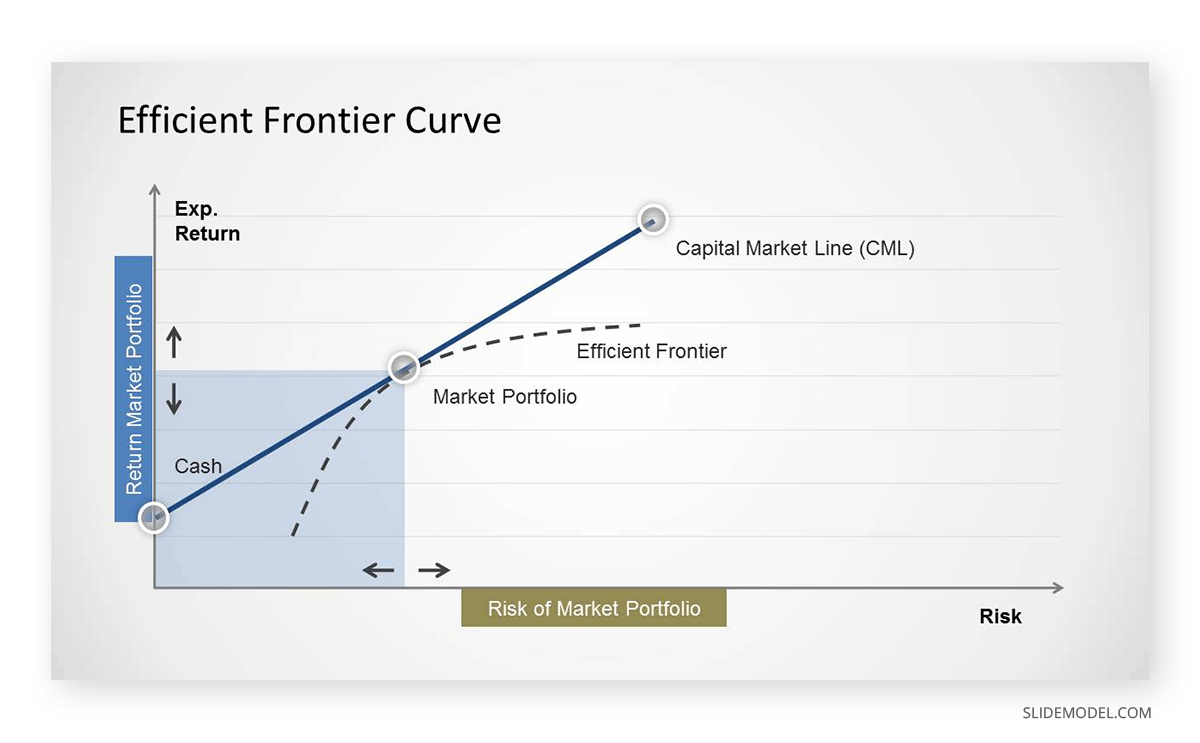
The Optimal Capital Structure Curve demonstrates the relationship between a company’s debt-to-equity ratio and its overall cost of capital. Including this in a financial model overview can provide insights into how different financing strategies might affect a company’s value. It highlights the theoretically optimal mix of debt and equity financing that minimizes the company’s cost of capital and maximizes its value.
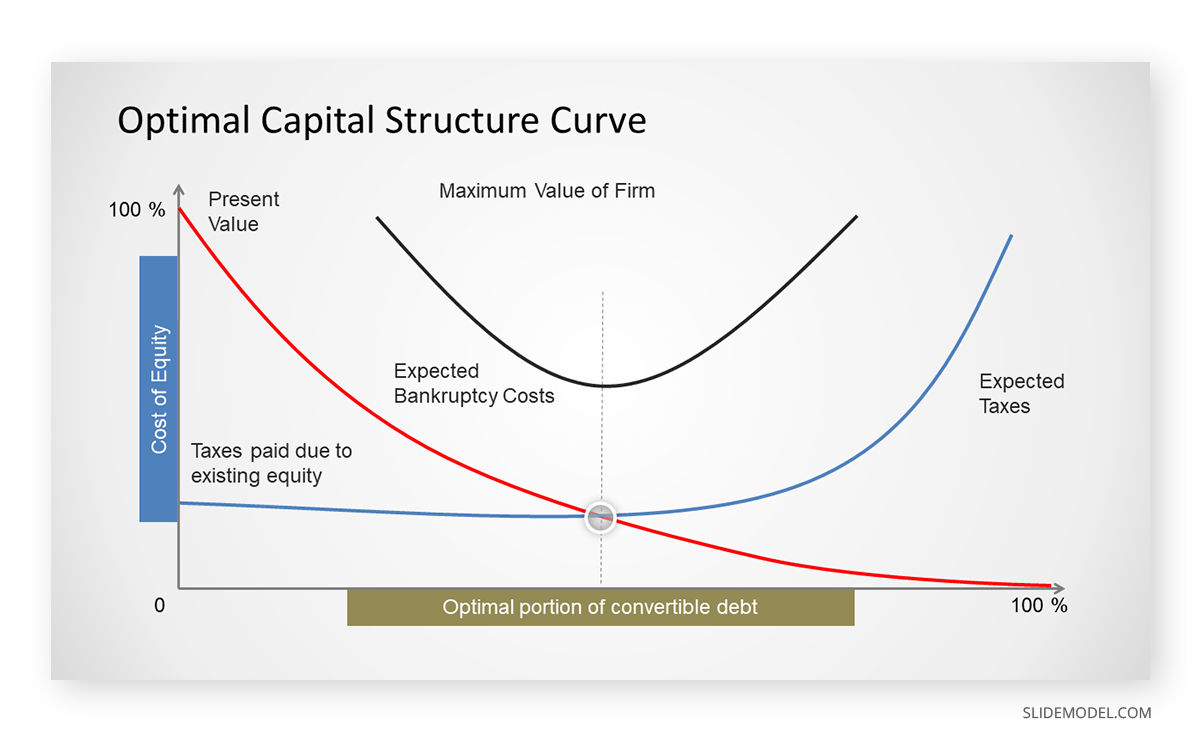
The Trade Off Theory of Capital Structure Curve suggests that there’s an optimal capital structure where the tax benefits of debt financing are balanced against the costs of financial distress. Including this curve in an overview can illustrate companies’ balancing act in deciding how much debt to take on, considering the benefits of tax shields against the potential costs of bankruptcy or financial distress.

Finally, the CAPM Capital Asset Pricing Model Curve determines the expected return on an asset or portfolio based on its beta (volatility or risk relative to the market). This model can be part of a financial model overview to demonstrate the relationship between the expected return of a security or portfolio and its risk, helping investors understand how to price risk when making investment decisions.
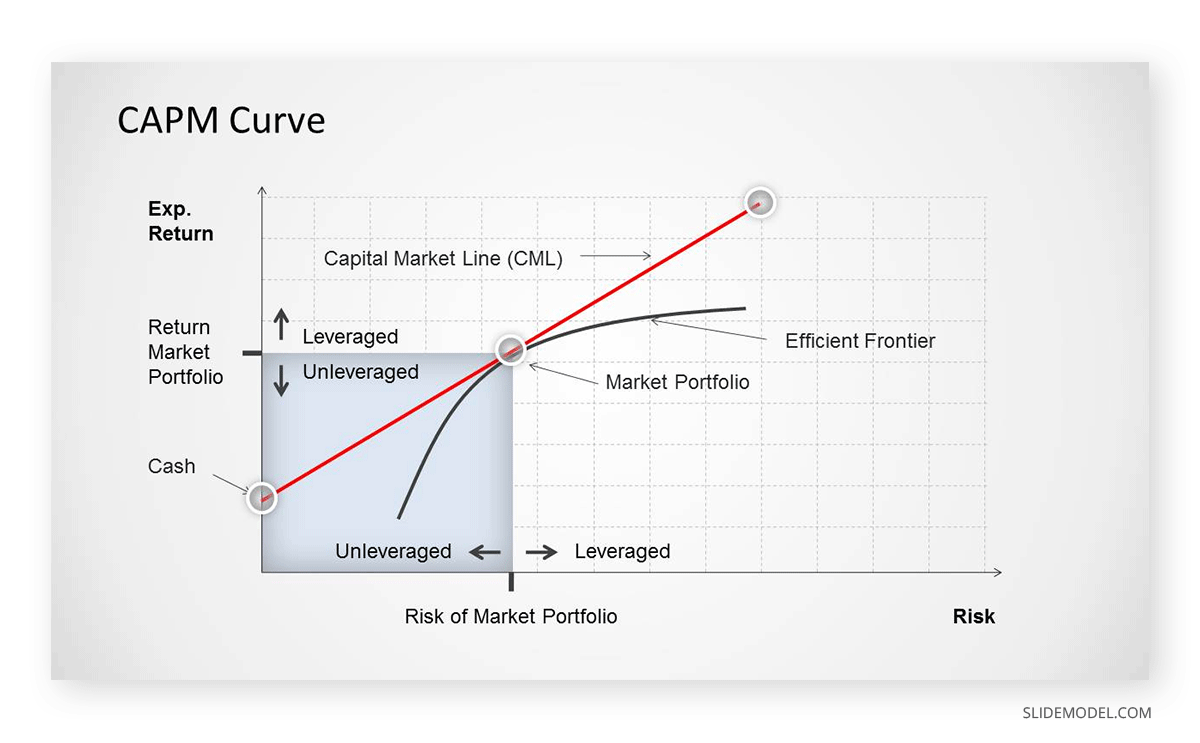
Human Resources Consulting Templates
Human Resource (HR) consulting templates are PPT templates designed to assist in evaluating and improving HR functions such as recruitment processes, talent management, and employee performance evaluation, to name a few. HR consulting templates enable consultants to offer actionable insights and recommendations that support the development of a motivated, efficient, and cohesive workforce aligned with the organization’s goals.
Organizational Design and Development
Whenever we think about organizational development, Org Charts come to mind. We can work with the classical, tier-oriented chart that is easy to understand from a quick view or opt for more complex models like matrices, multi-layered level org charts, etc.
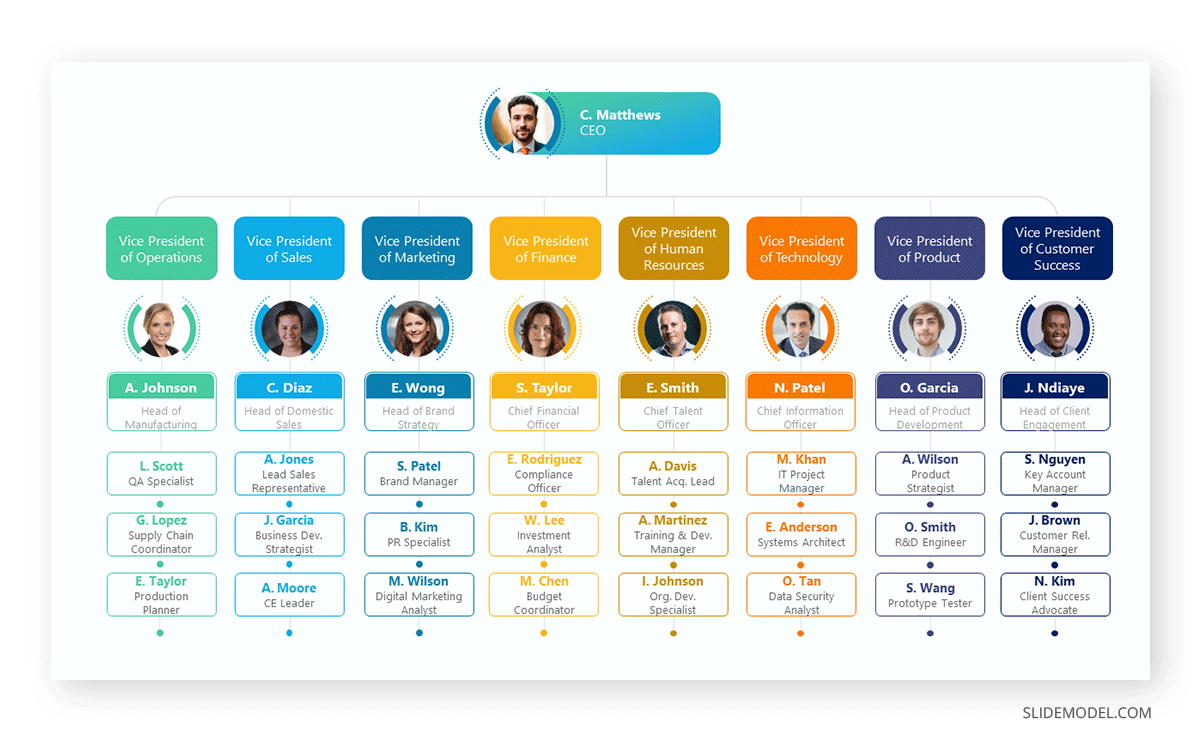
Talent Management Strategy
Talent Management PPT templates are oriented to increase the efficiency levels of talent supply inside organizations. HR teams can implement these templates to identify vacant areas, establish suitable candidate criteria, or develop training programs for the current workforce.
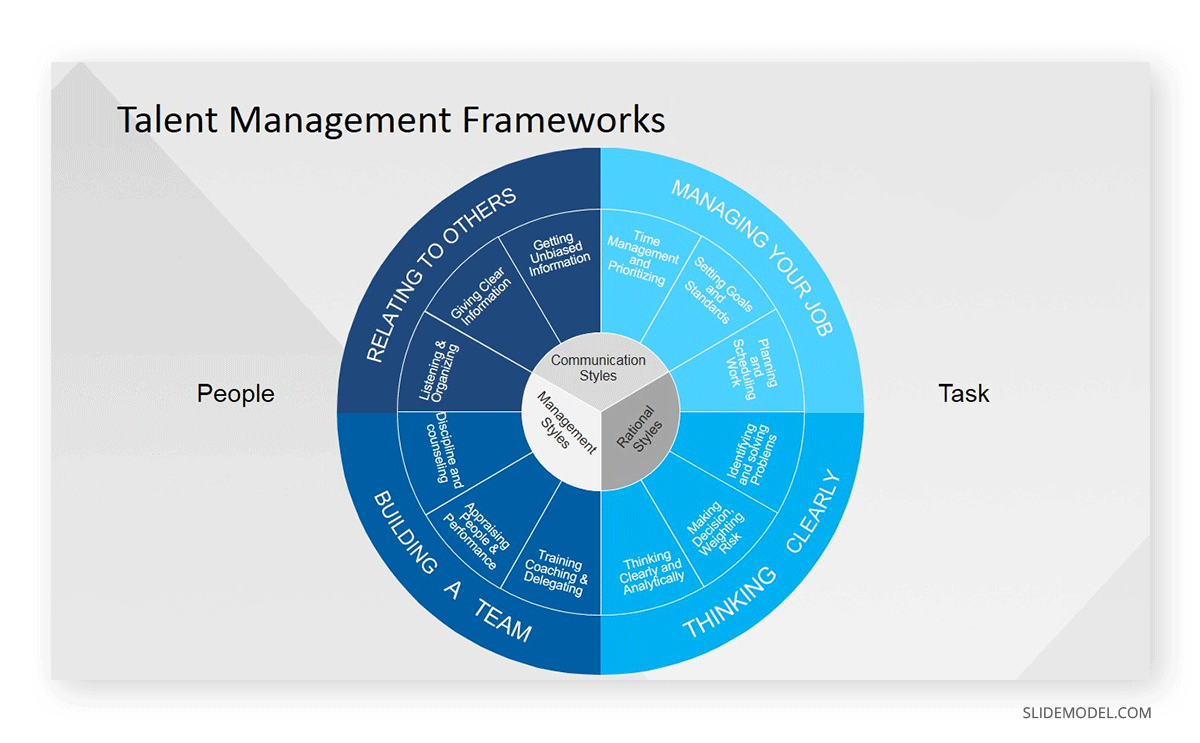
Employee Engagement and Satisfaction
HR consultants often collaborate with multidisciplinary teams to boost employee engagement and foster a company culture across all levels. Employee satisfaction remains a core factor, which can be linked to financial or environmental factors and career development opportunities. To address those needs in presentation design, consultants can use models like Maslow’s Hierarchy of Employee Engagement or the X Model of Employee Engagement.
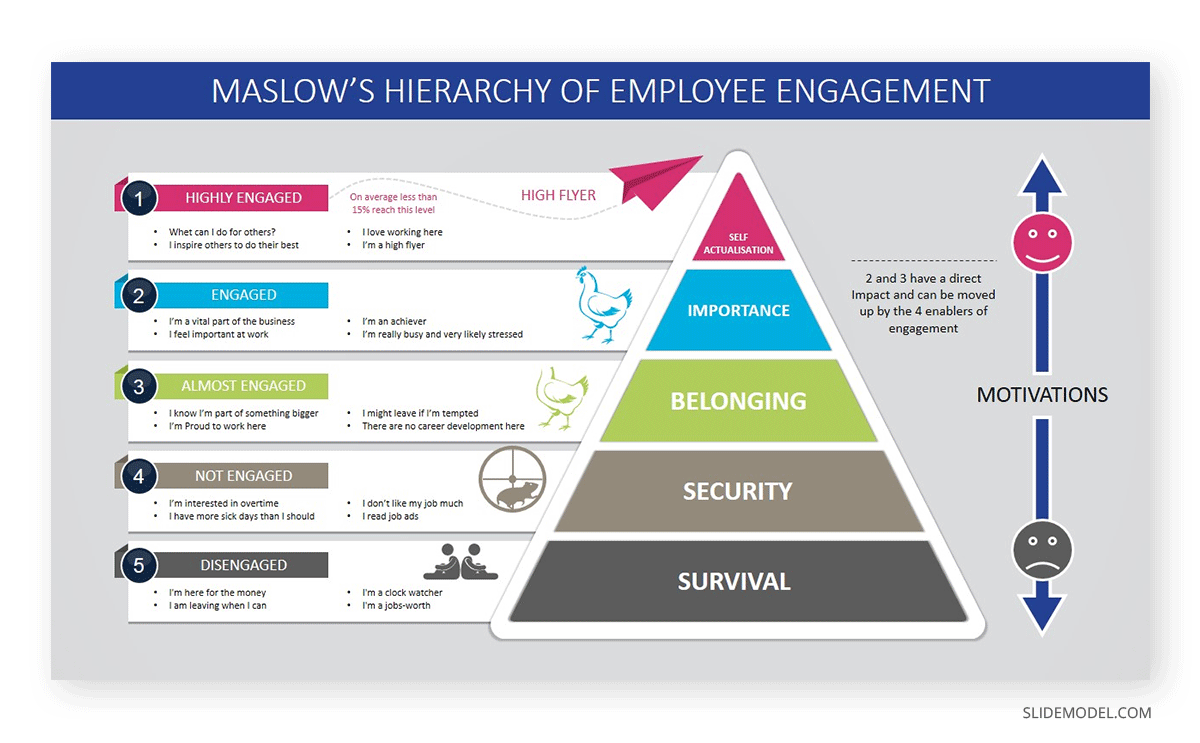
Compensation and Benefits Analysis
Another stage in HR consultancy services is tailoring attractive recruiting strategies for companies in highly competitive markets, such as the IT industry. Since employees often ask for the benefits of their job offer, consultants can use tools like Employee Benefits Diagrams to express the importance of their value proposition regarding the company culture.
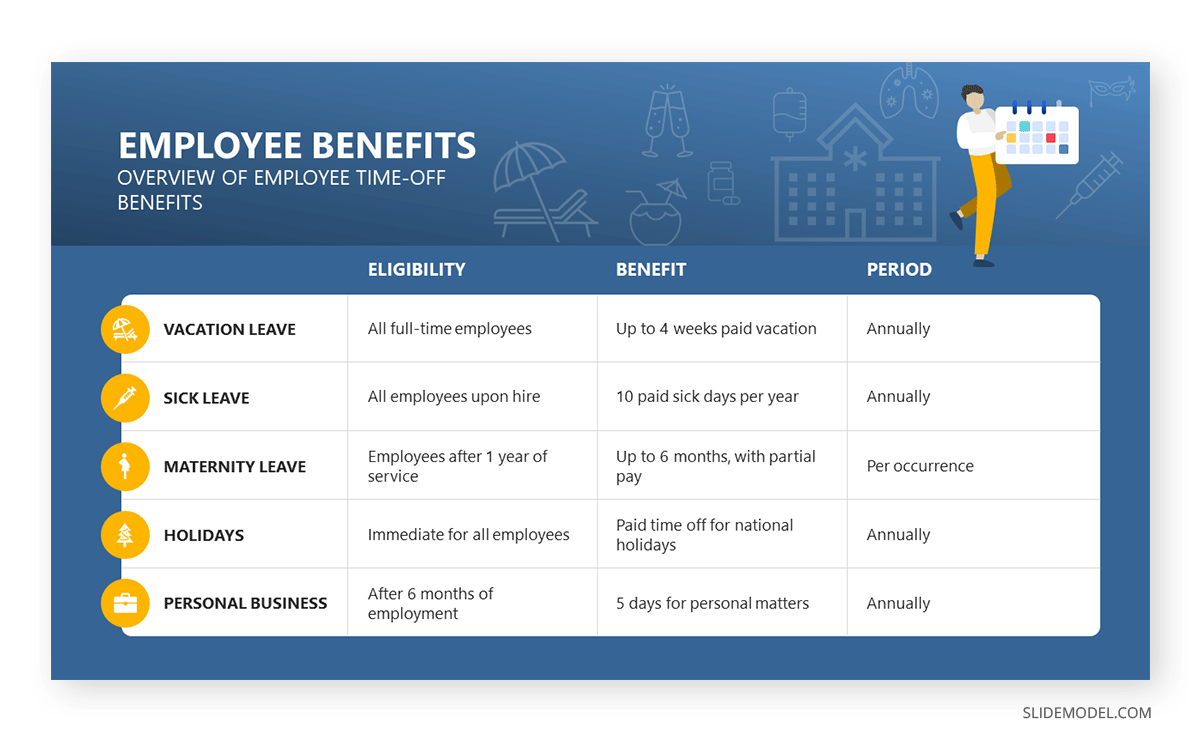
Training and Development Roadmap
Continuous education plans are among the tasks requested by HR consultancy services. Professionals can impact clients by delivering custom-made slide decks as if the stakeholders were part of the event, a practice commonly seen in McKinsey slides [2]. These slide decks will state the learning objectives to achieve, development roadmap, roles and responsibilities, knowledge assessments, etc.
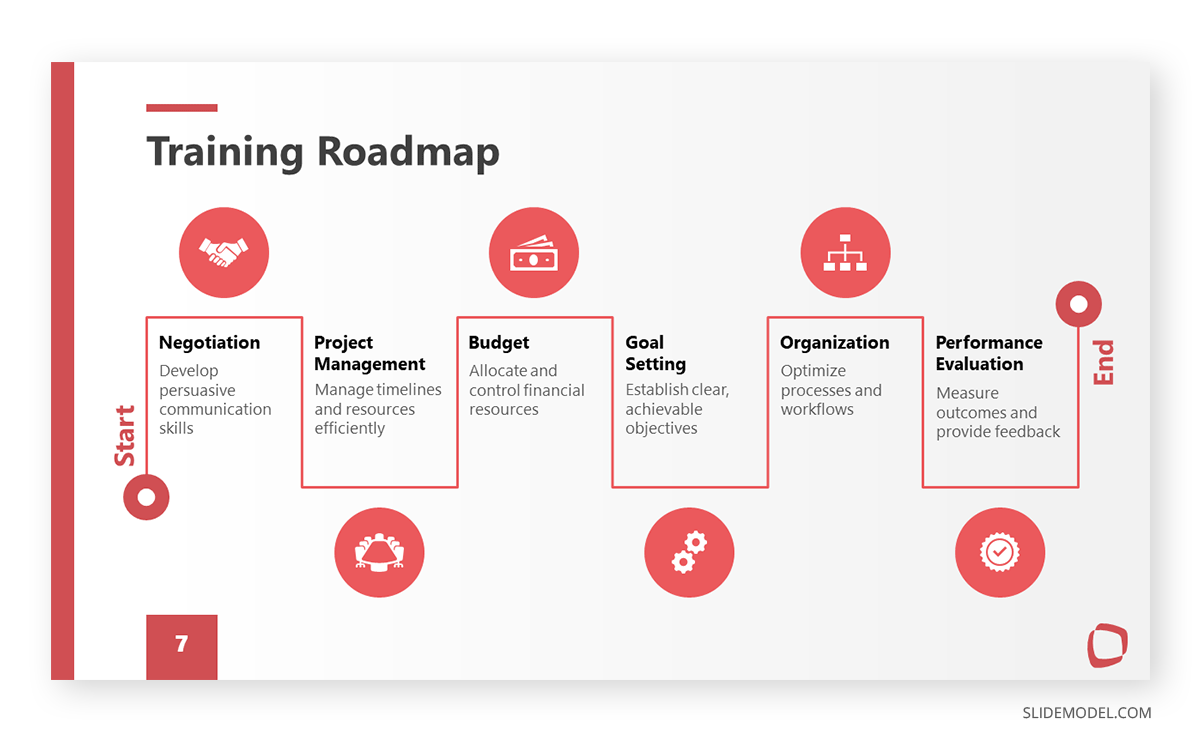
Digital Transformation Consulting Templates
Digital Transformation Consulting Templates are slides or slide decks designed to guide organizations through integrating digital technology into all business areas. These templates help map out strategies to change how businesses operate and fundamentally deliver value to customers. They cover digital strategy formulation, technology adoption, process digitization, and digital skill development.
IT Infrastructure Review
This category features a long list of templates, as we can talk about reviewing the current network infrastructure, a migration process from physical storage to the cloud, or ITIL processes.
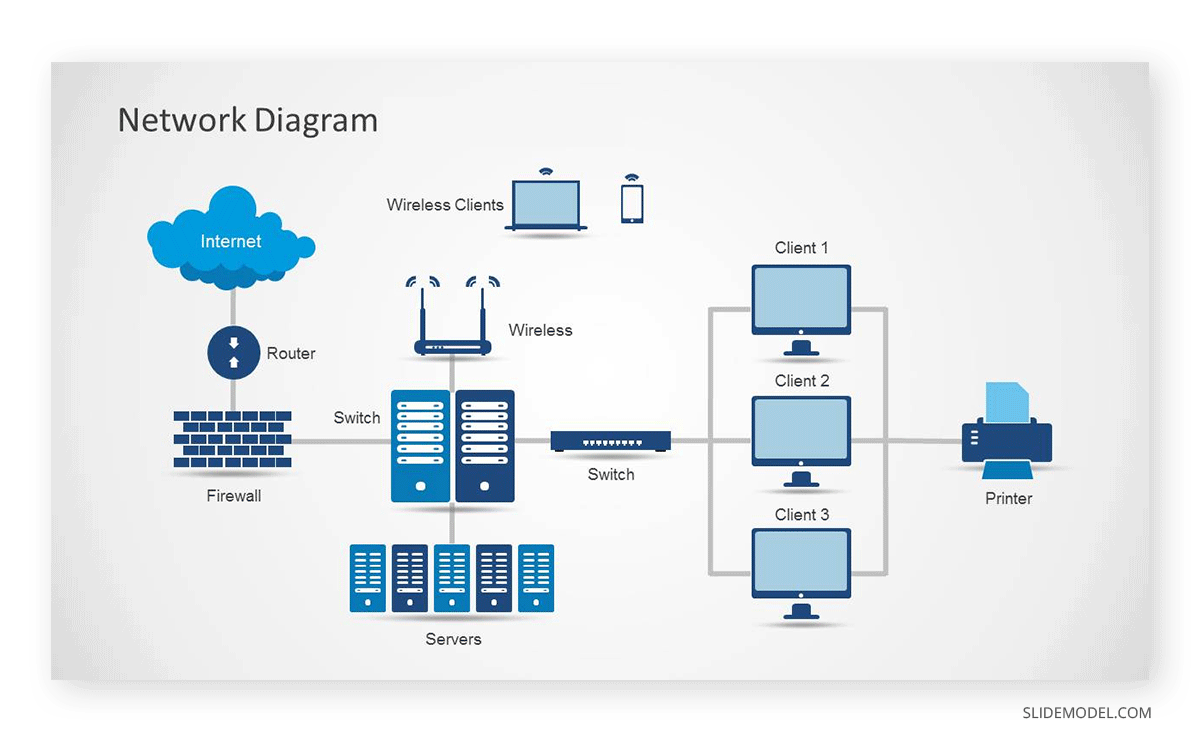
Digital Marketing Strategy
In our experience, consultants offering digital marketing services are required to use slide decks to wow prospective clients into hiring their agency. This can be either for SEO consultancy, e-commerce, social media marketing, and plenty of other options.
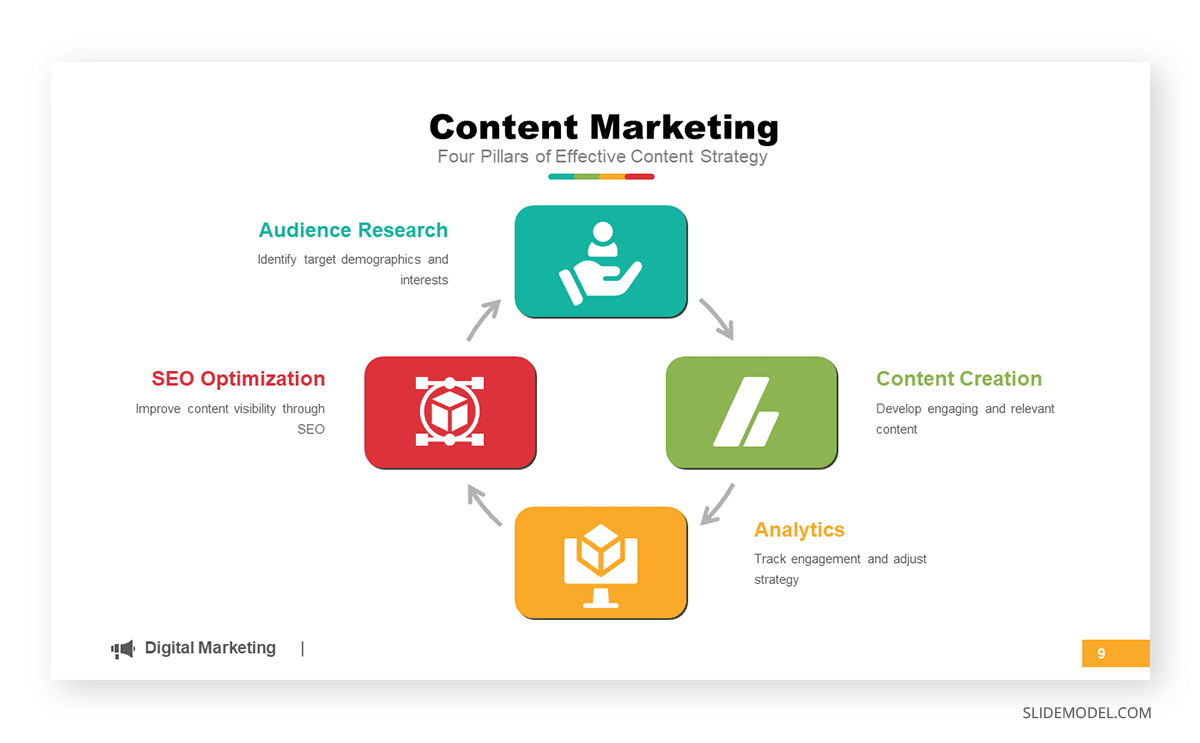
Another take in this category is when internal consultancy is done regarding the current digital marketing strategy, and the experts have to share their findings across all levels of the organization to adjust the efforts in the right direction.
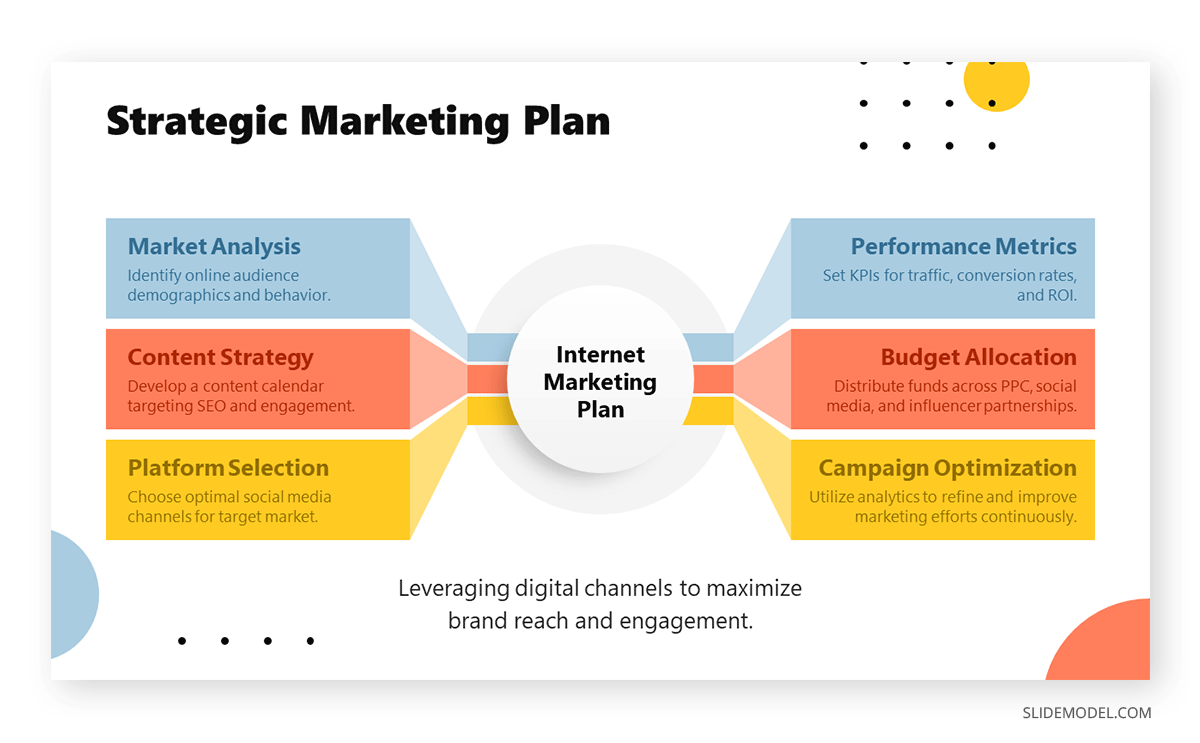
Risk Management Consulting Templates
Risk Management Consulting Templates help consultants identify, assess, and present mitigation strategies for potential risks within an organization. The core aspect these templates focus on is analyzing the impact those threats can pose on a business’s operation, financial health, or reputation.
Risk Assessment Framework & Compliance
Multiple methods and tools are used for risk assessment . For instance, we can use a typical Deloitte Governance Framework Model, work with a ROAM chart, use an RMF Framework, or the COSO Cube, to name a few.

Alternatively, we can use a risk assessment matrix. Keep in mind that some of the tools mentioned in this category work both for compliance and risk assessment.
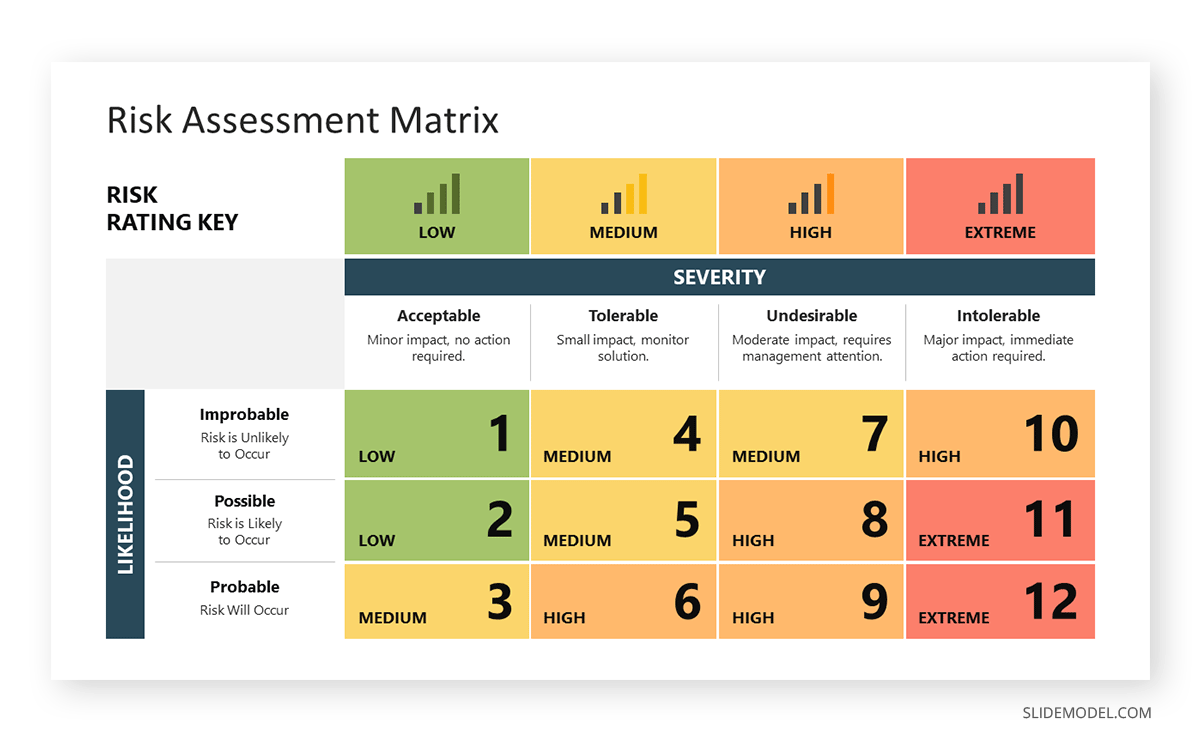
Cybersecurity
Consultancy presentations regarding cybersecurity can have two potential main uses: the first one, is where the findings of research about cybersecurity are presented to the management or key team members. This is with the objective of fixing potential threats to the organization. The second take is from a consultancy agency on cybersecurity that aims to promote its services, thus requiring high-quality visuals to communicate its value proposition to potential clients [3].
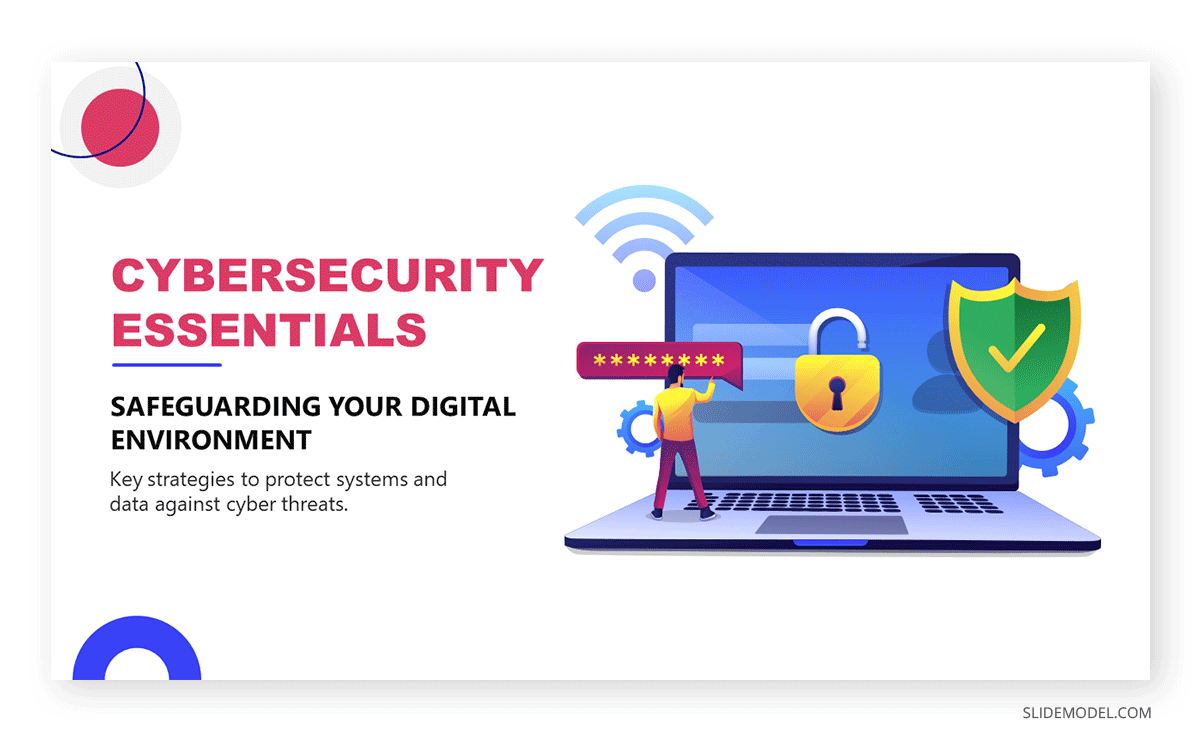
Change Management Consulting Templates
Change Management Consulting Templates are designed to support organizations through transition processes. Whether implementing new technologies, organizational restructuring, new manufacturing processes, or other changes, these templates ensure that employees are guided, supported, and motivated throughout the transformation process.
Change Management
Management consulting slide decks are used to guide clients through the process of planning, implementing, and sustaining changes within their organizations. Several models can be a good fit for this purpose, like the ADKAR framework , change management diagrams, change management models, and even change management slide decks.

Stakeholder Analysis
Stakeholder Analysis templates are ideal whenever we need to systematically identify, categorize, and assess the interests and influence of individuals or groups critical to the success of a project or initiative. This can involve working with a stakeholder matrix to evaluate their influence level and prioritize strategies, or simply identifying the stakeholders in a diagram at the initial stages of a project.
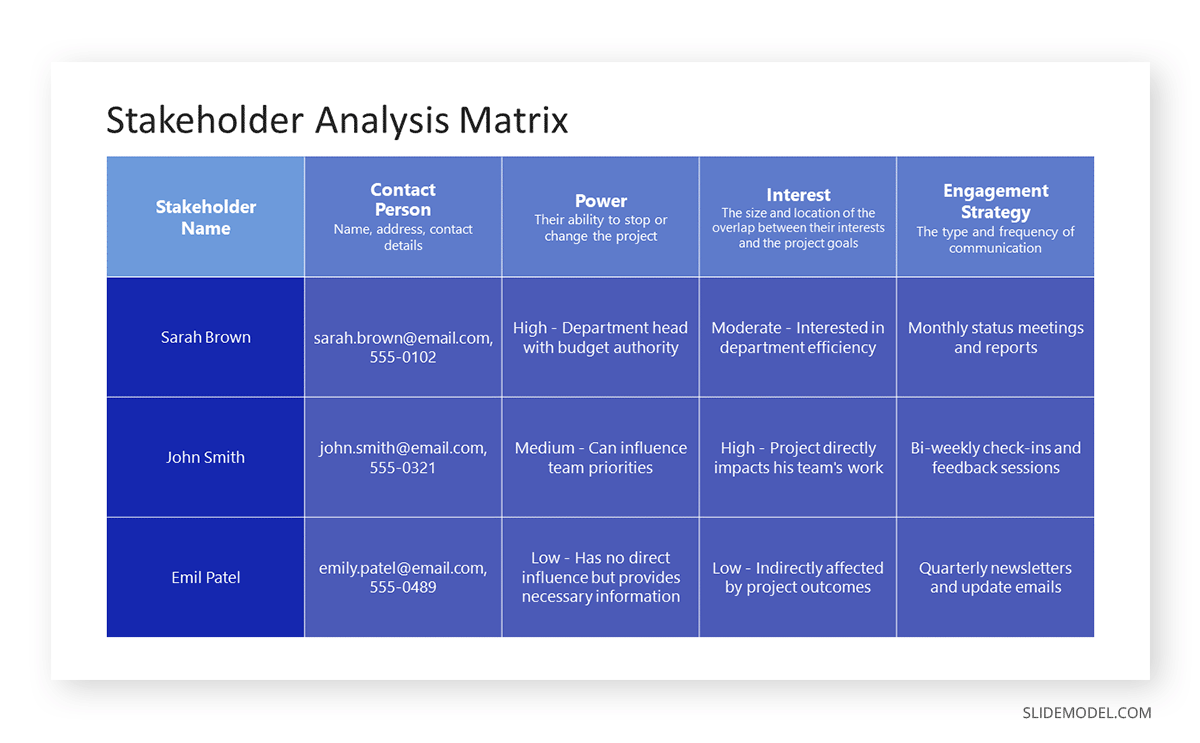
Communication Plan
A communication plan is a high-level document that includes all the information pertinent to the organization’s business objectives, goals, competitors, and communication channels. These kinds of presentations are created when the communication plan is presented to key stakeholders and management, so all details can be reviewed before sharing the document across all levels of the organization. We can work with generalist communication plans or niche-specific ones, like marketing communication plans.
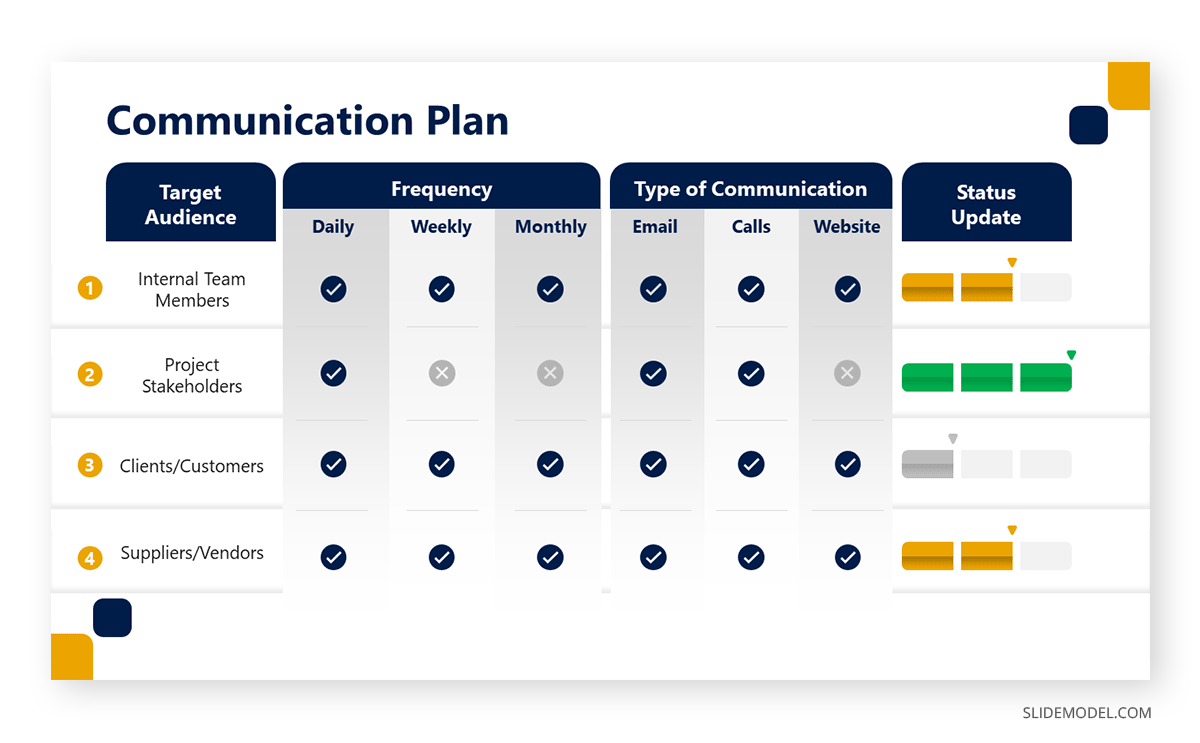
Customer and Marketing Consulting Templates
Customer and Marketing Consulting Templates were created to enhance engagement with target markets and customers. By implementing these templates, consultants can represent insights for market segmentation, product positioning, or mapping the customer journey. This, in turn, helps businesses align marketing efforts with real consumer needs and preferences in their niche.
Customer Journey Mapping
Customer Journey Mapping templates are used in consulting presentations to provide a visual overview of a customer’s experience with a brand, product, or service from initial contact through various stages of engagement and long-term relationships. They serve to identify key interactions, touchpoints, and the emotional journey customers undergo.
The usage of these consulting slides helps pinpoint areas for improvement, uncover customer pain points, and highlight moments of delight. By mapping out the customer journey, consultants can offer targeted recommendations for enhancing the customer experience, improving customer satisfaction, and ultimately driving business growth.
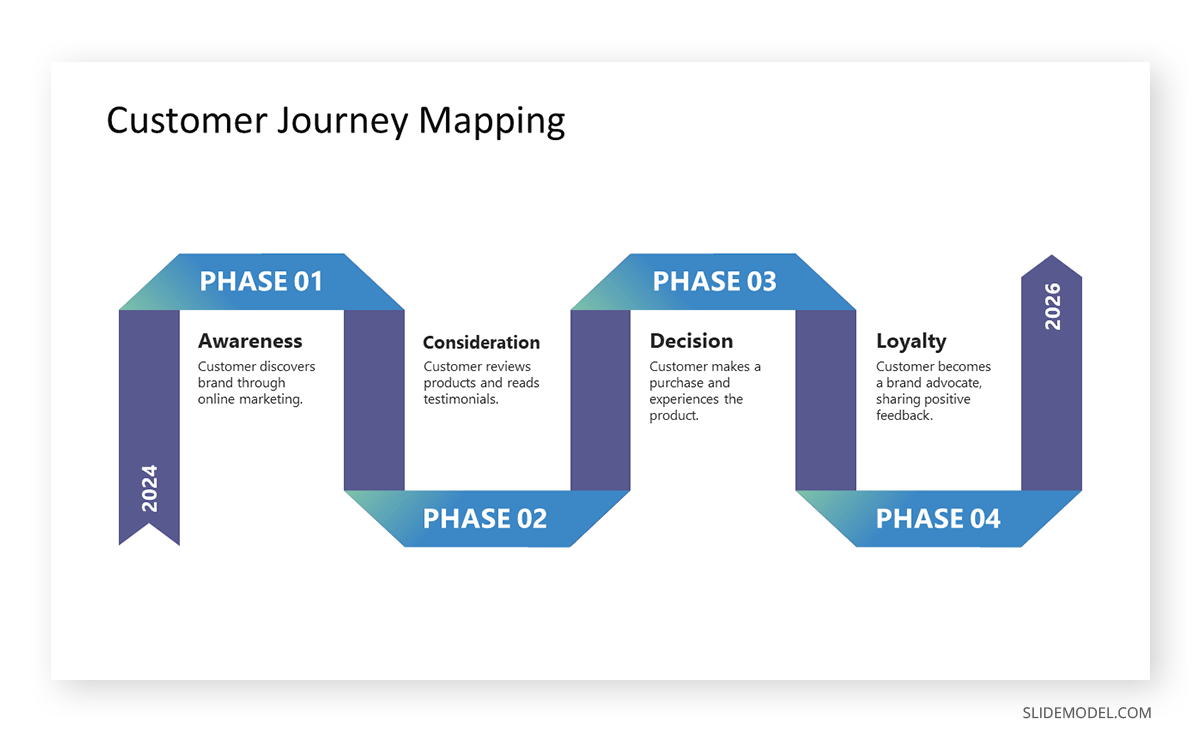
Market Segmentation
Market Segmentation Templates are utilized in consulting presentations to visually categorize a market into distinct groups based on various criteria like demographics, psychographics, behavior, and needs. These templates help illustrate the composition of a market, showcasing how each segment differs in terms of preferences, purchasing behavior, and responsiveness to marketing strategies.
By employing market segmentation templates, a consulting company presentation can effectively communicate targeted strategies for reaching and engaging specific customer segments. This approach aids businesses in focusing their marketing efforts more efficiently, tailoring products, services, and messaging to meet the unique needs of each segment. Examples of templates we can use are the PAM TAM SAM SOM model, a target market diagram, the VALS framework, or generic market segmentation slides.
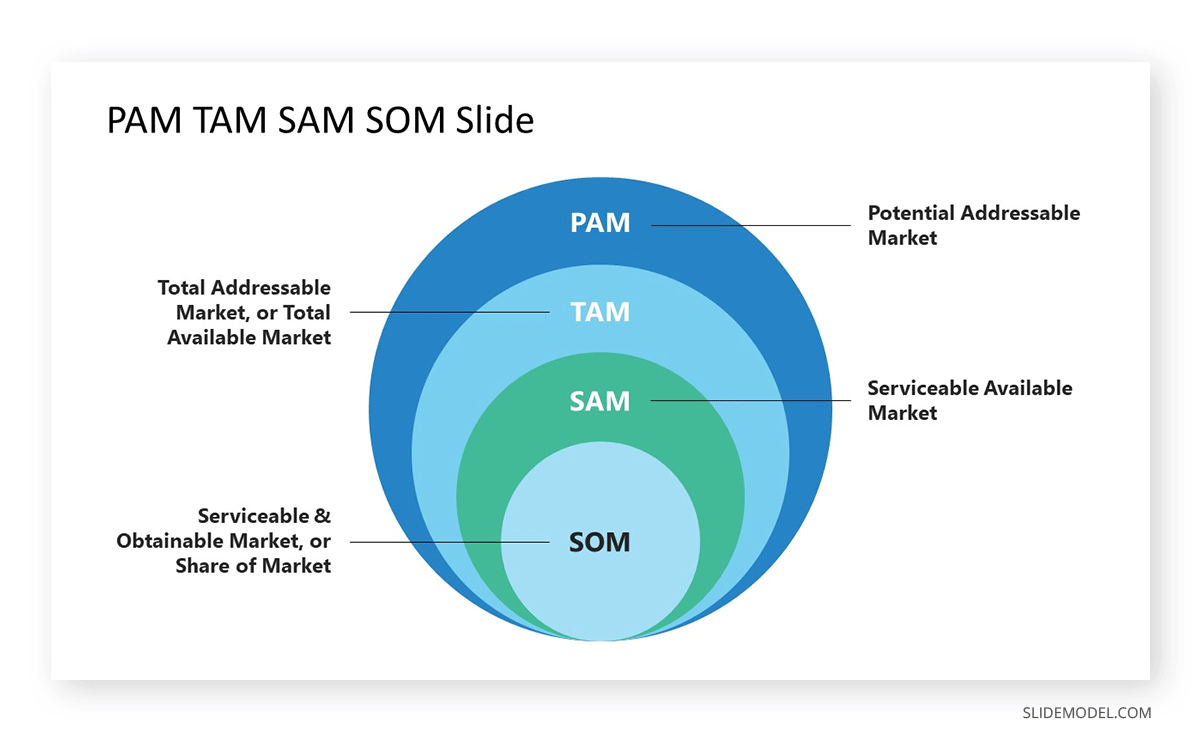
Marketing Mix Strategy (4Ps)
The Marketing Mix Strategy (4Ps) templates help consultants delineate how each component (Product, Price, Place, and Promotion) can be optimized to meet the target market’s needs and achieve a competitive advantage. This, in turn, allows us to provide recommendations on product development, pricing strategies, distribution channels, and promotional tactics.
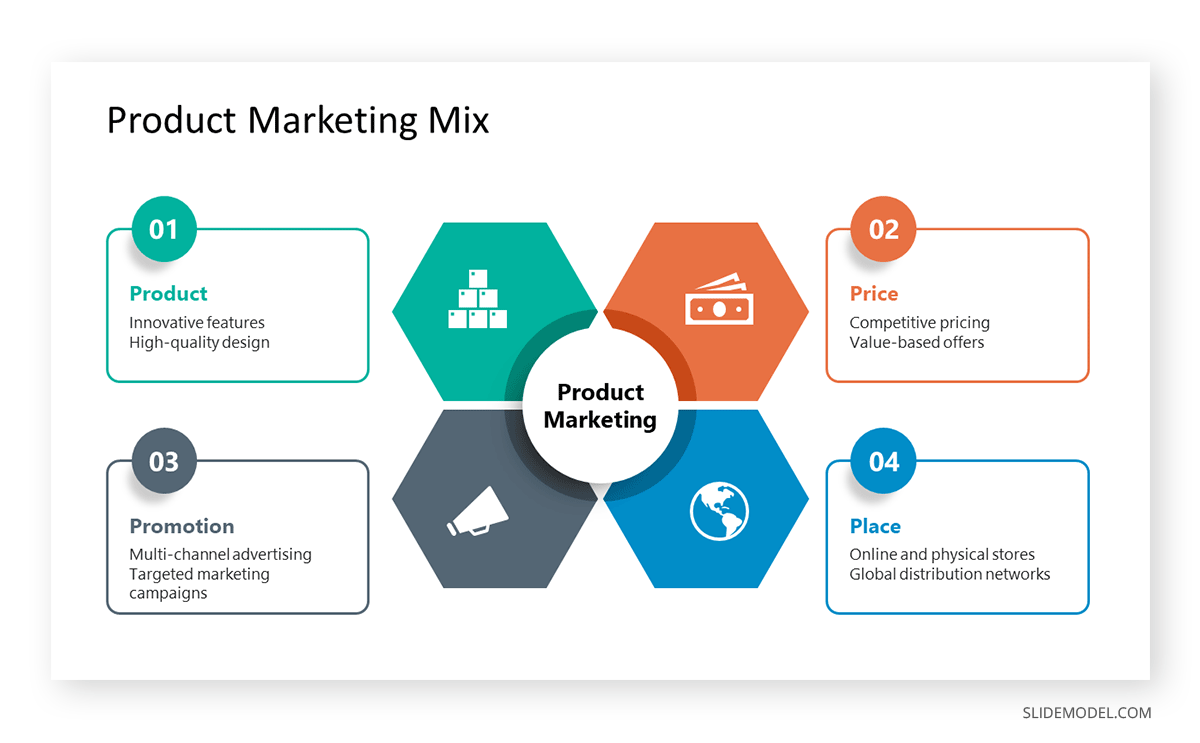
Alternatively, we can work with more complete frameworks, like the 7Ps Marketing Mix or the 8Ps Marketing Mix.

Customer Satisfaction and Loyalty Analysis
One commonly asked consultancy service is to explore customer satisfaction and brand loyalty, and for that reason, presenters can work with customer lifecycle templates, which explore the process from a buying need to a recurring consumer of a brand.
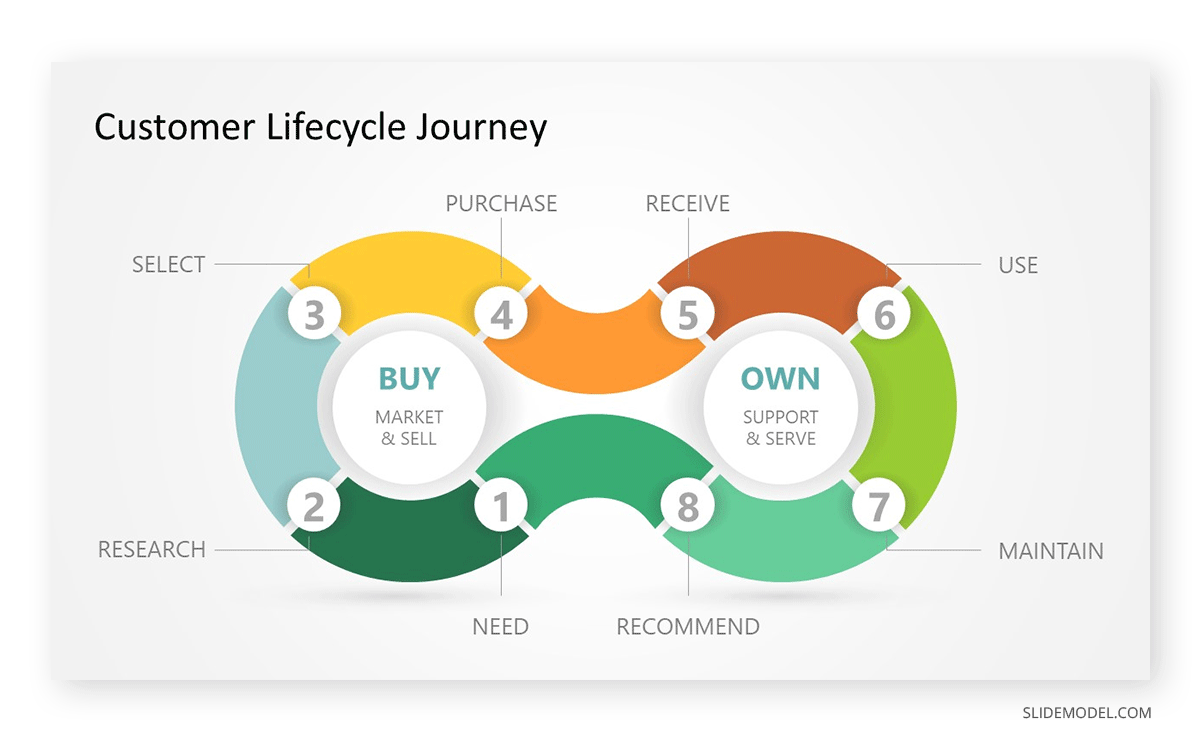
If the issue regarding customer satisfaction is linked to customer service, then consultants can evaluate factors like the customer service maturity level – going from cost-based strategies to customer service that adds value to a consumer’s life.
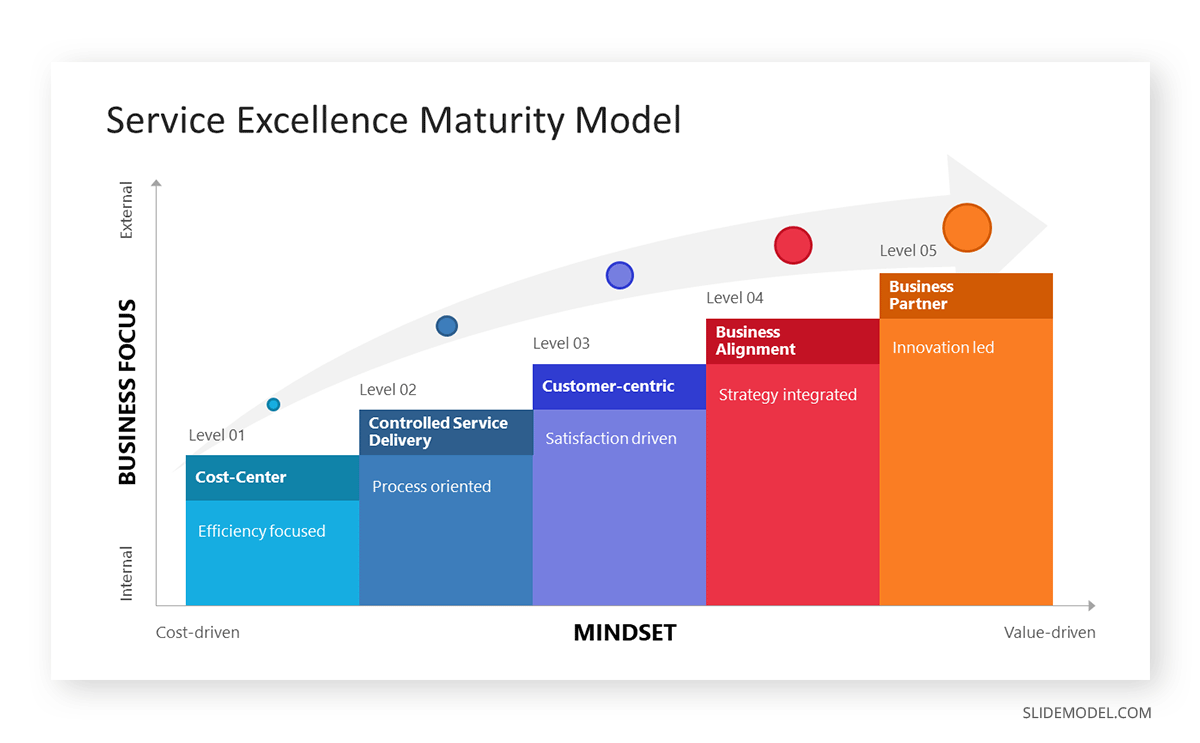
Customer satisfaction surveys are typically conducted in this kind of analysis, and results can be presented using templates like the NPS Gauge Infographic.

Sustainability and ESG Consulting Templates
Sustainability and ESG (Environmental, Social, Governance) Consulting Templates are slides that help presenters communicate sustainable practices and ESG principles into their organization’s operations. They assess the importance of environmental impact, social responsibility, and governance practices, becoming actionable tools to define sustainable goals, measure progress, and communicate achievements.
Sustainability Strategy and Roadmap
Sustainability Strategy and Roadmap consultancy PowerPoint templates allow us to outline an organization’s approach to integrating sustainable practices into its business operations. Consultants work with these templates to present a structured plan, from setting sustainability goals to implementing initiatives and monitoring progress.
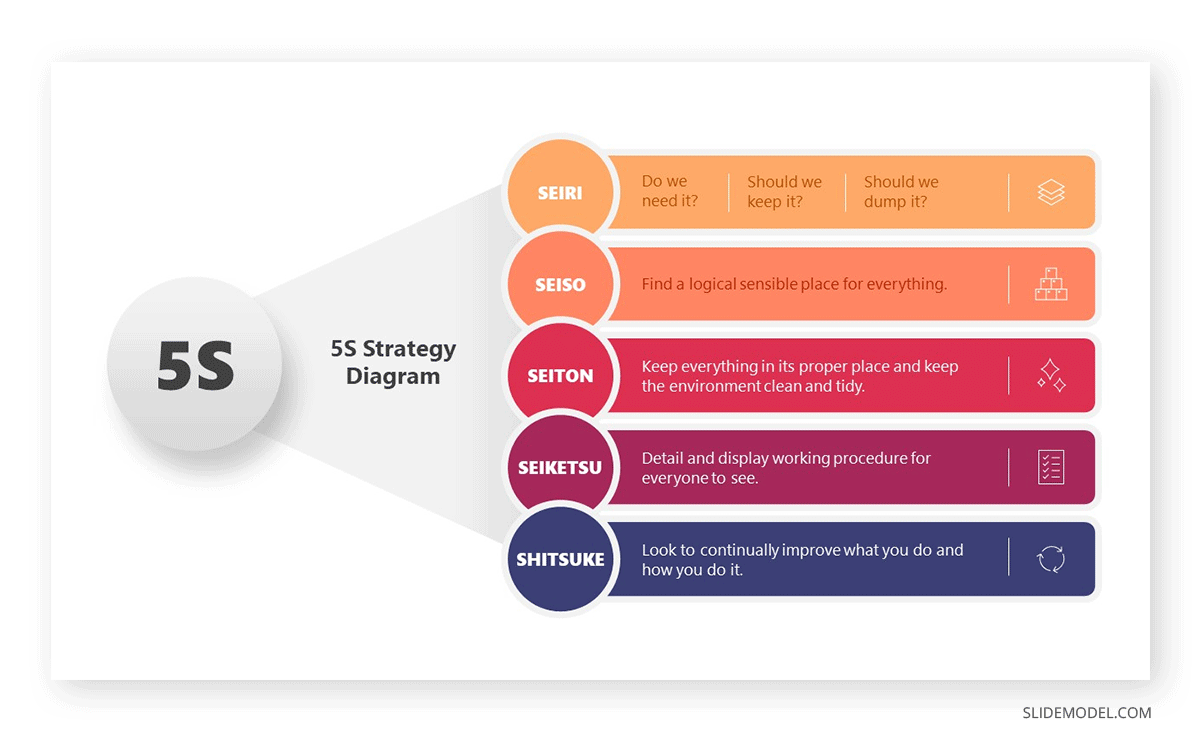
ESG (Environmental, Social, Governance) Reporting Framework
ESG slide templates enable consultants to communicate a company’s commitment to sustainability, ethical practices, and social responsibility to stakeholders. By showcasing achievements, challenges, and future goals, these templates facilitate transparent dialogue with investors, customers, and regulatory bodies. They are crucial for companies looking to demonstrate accountability, enhance their reputation, and attract sustainability-conscious investors and consumers.
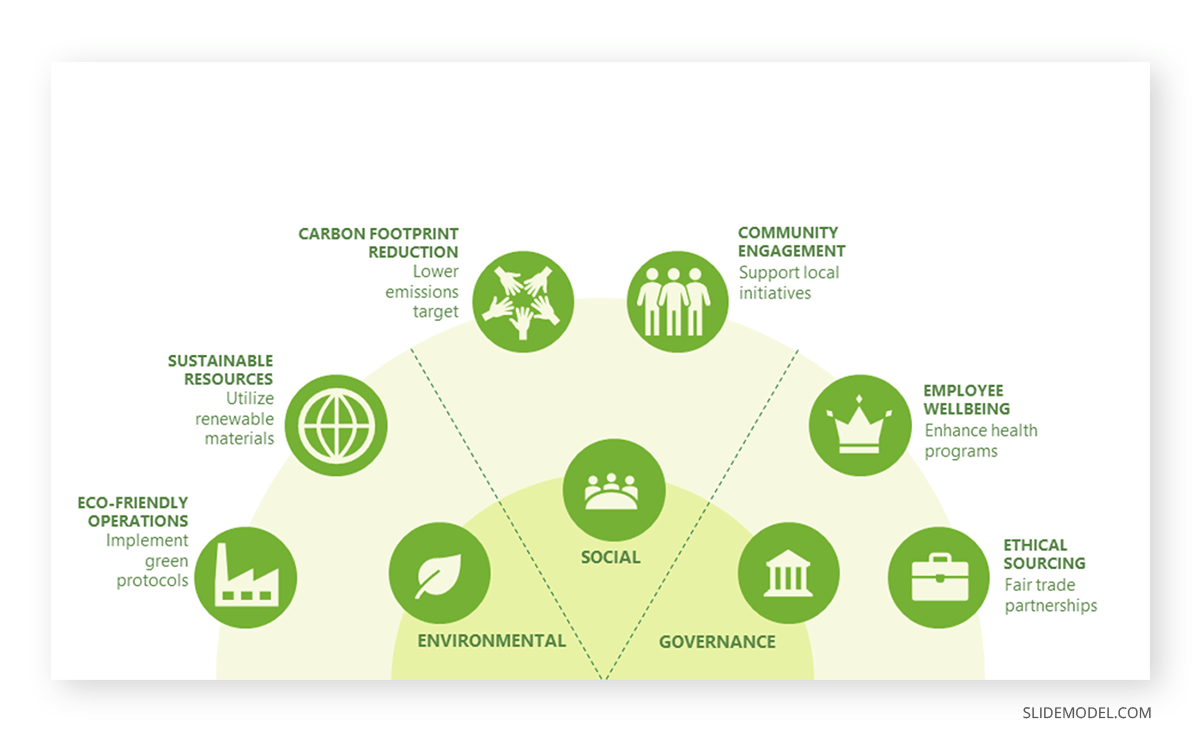
Circular Economy Strategy
In our final category, we can find the circular economy strategy templates, which aim to redefine growth and focus on positive society-wide benefits. These templates enable consultants to illustrate how businesses can transition from a linear “take-make-waste” model to a circular economy model that designs out waste, keeps products and materials in use, and regenerates natural systems. By detailing strategies for sustainable product design, recycling, reuse, and remanufacturing, the templates help visualize companies’ steps to become more sustainable and efficient.
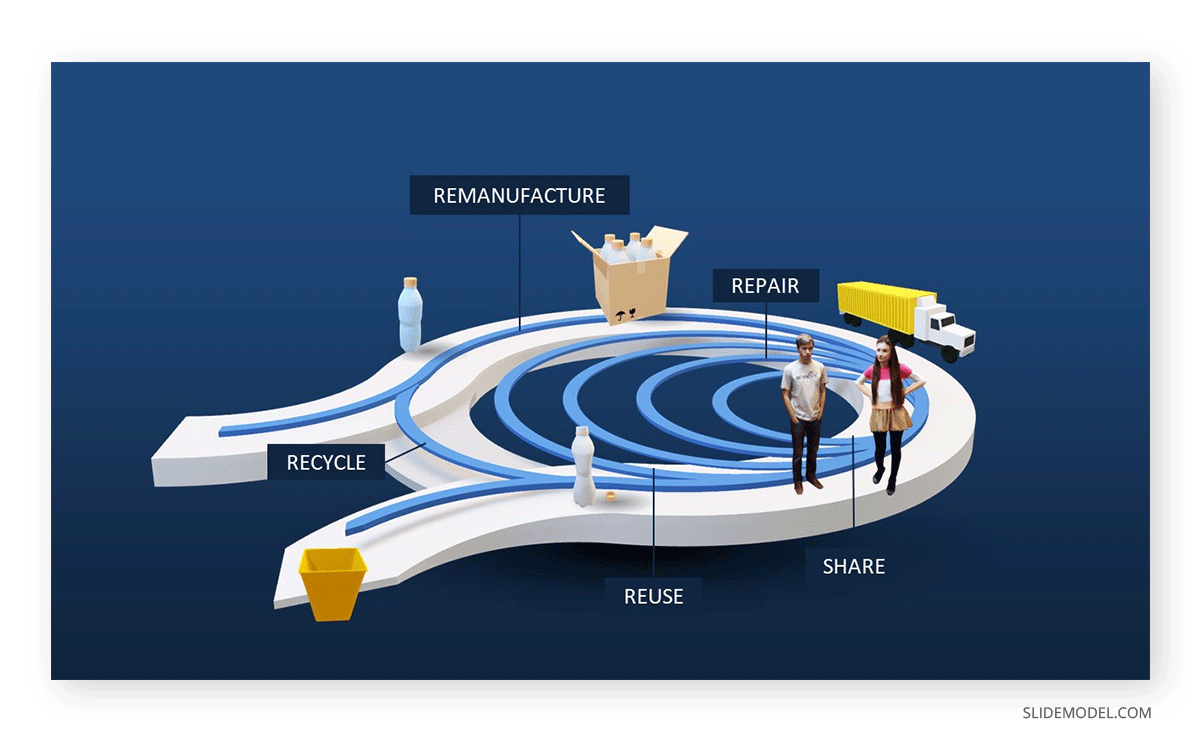
Creating a tailored consulting slide deck from scratch involves hours of planning, including which information you intend to deliver, which graphic outlook will engage the audience, how you will highlight key factors, and the list goes on. Therefore, we invite you to explore the possibilities that consulting presentation templates offer regarding reduced effort and better time management for your presentations. All the designs shown in this article can be fully customized to the presenter’s requirements or preferences.
[1] Alexander, E. R. (1982). Design in the Decision-Making Process . Journal Name, 14(3), 279-292.
[2] Rasiel, E. (1999). The McKinsey Way . McGraw-Hill.
[3] Sibbet, D. (2010). Visual Meetings: How Graphics, Sticky Notes and Idea Mapping Can Transform Group Productivity . Wiley.
[4] Baret, S., Sandford, N., Hida, E., Vazirani, J., & Hatfield, S. (2013). Developing an effective governance operating model: A guide for financial services boards and management teams . Deloitte Development LLC.
Like this article? Please share
Business Analysis Tools, Consulting Filed under Business
Related Articles
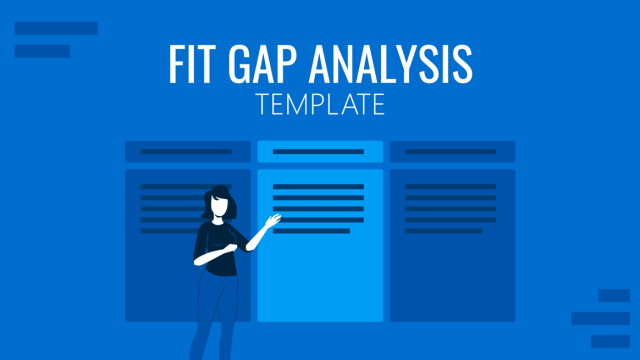
Filed under Business • March 13th, 2024
Exploring the Significance of the Fit Gap Analysis (Examples + Templates)
Master the Fit Gap Analysis with this guide featuring professionally designed PPT templates and step-by-step examples.
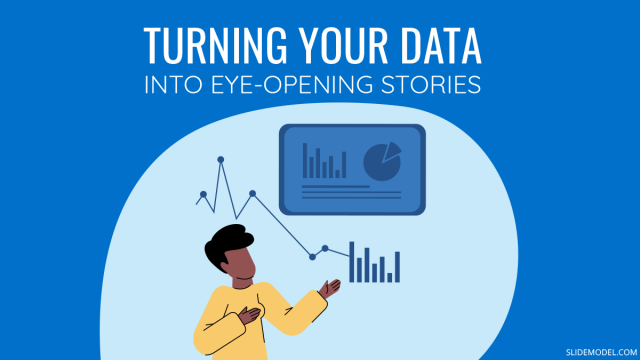
Filed under Presentation Ideas • February 12th, 2024
Turning Your Data into Eye-opening Stories
What is Data Storytelling is a question that people are constantly asking now. If you seek to understand how to create a data storytelling ppt that will complete the information for your audience, you should read this blog post.

Filed under Business • February 7th, 2024
How to Create & Present a Competitive Landscape Slide for Your Pitch Deck
Get to know how to properly create a winning competitive landscape slide for your pitch deck. Boost your pitch performance now.
Leave a Reply
Transform teamwork with Confluence. See why Confluence is the content collaboration hub for all teams. Get it free
- Project management
- Project planning
- Proposal outline
What is a project proposal outline? Steps and best practices
Browse topics.
Every significant project begins with a proposal. But before you learn how to write a project proposal , you must master how to build an effective outline.
To create a project proposal outline, start by understanding the project goal and scope , its key stakeholders, their concerns, and the project's anticipated benefits. This will help provide a framework for the outline.
This article explores the importance and key components of a project proposal outline, highlights best practices for creating a solid outline, and explains how to write one. Write your project proposal outline in Confluence for free.
Understanding a project proposal outline
A project proposal outline aims to clearly explain a project in a way that convinces readers to support it. An effective project proposal outline is essential to strategic planning and influences your company’s decision-making process .
To create an effective project proposal outline, you must understand the stakeholders' primary goals and concerns. Draft your proposal outline to align with and address what those stakeholders care about and can expect from your project.
That effort begins with the outline’s title, which should persuade your audience to continue reading the outline. This approach will result in a project proposal outline that engages and persuades participants, stakeholders, and influencers to support your project.
Types of proposals
There are multiple types of project proposals, including academic proposals, business proposals, project proposals, and research proposals.
- Academic proposals intend to gain support for creating a specific dissertation, research paper, or thesis.
- Business proposals aim to secure funding from investors, persuade clients to sign a contract or gain support for a project.
- Research proposals aim to gain resources and support for a specific research project.
- Project proposals intend to garner support for a particular project from colleagues, decision-makers, and stakeholders.
The structure and components of each project proposal outline may vary depending on the type of proposal involved. Most of your proposals will likely be project management proposals, which aim to address a specific operational business need or pursue a specific business opportunity.
Components of a proposal outline
Every project proposal outline should include several key components. Use this project proposal format to write an effective outline:
- Title : Give your outline a title that captures the critical focus of your project. Don’t try to summarize the entire project; instead, provide a few words of incentive for people to continue reading the outline.
- Executive summary : This succinct project proposal overview focuses on its goals, objectives, and anticipated outcomes. This should be no more than one to two short paragraphs.
- Introduction : This section should cover the same grounds as the executive summary and provide more details centered on the content of the proposal outline. It should be brief and encourage further reading.
- Problem statement : Include a brief, clear statement of the business problem or opportunity the proposed project intends to address.
- Objectives : Provide details of the specific goals of the proposed project. Focus on stakeholder and company-wide benefits.
- Methodology : Briefly describe how the proposed project will achieve its objectives. Give information on which roles and teams will be active participants, and list all stakeholders.
- Budget : Detail the money, people, and other resources needed to complete the proposed project successfully. Where appropriate, include information about the source or sources of budgeted resources.
- Timeline : Detail the planned schedule for all stages of the proposed project. Highlight any anticipated decision or inflection points.
- Evaluation : Describe how you’ll evaluate the results and outcomes of the proposed project and what the next steps will be.
- Conclusion : Summarize the key points and include a call to action requesting feedback and questions from readers.
- Appendices : Add any appropriate supporting documents and links to online resources. Label each appendix and include a brief description of why you included it.
Steps to create a project proposal outline
Now that you have a usable structure, you can start creating your outline. Here’s a summary of the critical steps.
Conduct preliminary research
Start by researching your audience, their primary goals and concerns, and how your proposed project can align most closely with these. Gather information through surveys, interviews, and informal conversations to shape the structure and content of your proposal outline.
Take good notes and record conversations where possible, which will help ensure you capture all the valuable information your research unearths.
Structure the outline
Structure your outline by using your primary research and the list of components above. Organize information logically and create headings and subheadings for each section to help enhance readability. Focus on presenting your project proposal outline clearly and concisely.
Write the proposal outline
Once you have a structure in place, start writing. Draft each section in clear and professional language while incorporating terms familiar to or essential to your primary audience wherever appropriate.
Review and revise each outline section to achieve maximum accuracy and completeness. If time and circumstances permit, try to get at least one or two members of your primary audience to review and comment on your outline before developing and sharing your final version.
Best practices for creating proposal outlines
When creating a project proposal outline, it’s crucial to keep your work concise, focused, and aligned with your goals and objectives (and those of your primary audience). Use familiar, comfortable language and include credible supporting data within the body of your outline or as appendices. Use consistent formatting and fonts to prevent visual disruption and focus your readers’ experience on the content of your outline.
Create effective project proposal outlines with Confluence
The right software can ease and speed up your entire project proposal creation process, including collaborative review and editing. This is where Confluence shines.
Confluence brings everyone together in a connected workspace to move projects forward. Teams can create, edit, and share project plans so everyone is on the same page. Every project, proposal, and outline can include multiple types of information, including action items, assignees, dates, tables, and more. Confluence offers a range of available templates, including a project proposal template , to help you start quickly and efficiently. Explore the project poster template in Confluence, and use Confluence to write your project proposal outline for free .
Proposal outline: Frequently asked questions
Why is a proposal outline important.
A project proposal outline helps you organize your thoughts and ensure that you cover all critical points. It also makes the writing process more efficient and enables you to clearly communicate the proposal's objectives and methodology to reviewers and stakeholders. A solid project proposal outline can benefit all of your project management phases , including project planning .
Can you use the same proposal outline for different types of proposals?
You can use the same basic proposal outline structure for different types of proposals. Tailor each outline to fit the specific context and goals of each proposal and the needs and expectations of your primary audience and stakeholders. Primary research can help you select the best proposal type and structure for your specific outline.
What common mistakes should you avoid when creating a proposal outline?
Some common mistakes to avoid when creating a proposal outline include overloading the outline with information, unclear directions, or a lack of precision. Others include ignoring your primary audience's needs and expectations, lack of cohesion, and poor information flow.
Sticking closely to a well-crafted structure such as the one outlined in this article can help you avoid these and other pitfalls. Soliciting reviews and comments from select audience members and stakeholders while crafting your outline can help ensure that your final version resonates with and positively persuades your audience.
You may also like
Project poster template.
A collaborative one-pager that keeps your project team and stakeholders aligned
Project Management templates collection

Use this collection of Confluence templates to create and execute a project
Enable faster content collaboration for every team with Confluence
Copyright © 2024 Atlassian
- Enter Our Giveaway
- Meta Quest 4
- Google Pixel 9
- Google Pixel 8a
- Apple Vision Pro 2
- Nintendo Switch 2
- Samsung Galaxy Ring
- Yellowstone Season 6
- Recall an Email in Outlook
- Stranger Things Season 5
How to create a Powerpoint Presentation
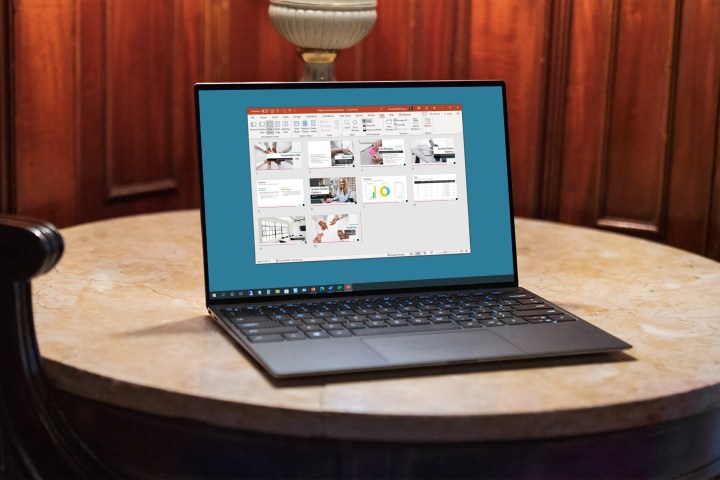
Powerpoint presentations are a great way to share information with a team, but making them is a skillset in its own right. We've got guides on general Powerpoint use , but if you're keen to just get started making a slideshow right now, this is the way.
How to create a Powerpoint presentation
How to build your first slide, how to add more slides to a powerpoint presentation, how to make an awesome slideshow presentation.
Here's how to make a Powerpoint presentation.
What You Need
Powerpoint or Microsoft 365 subscription
The first step in building your fancy slideshow is to create the presentation itself. Here's how to do it.
Step 1: Install Powerpoint (as part of Microsoft 365 ) if you haven't already, then open the app up.
Step 2: The home screen will give you a range of options for selecting templates and premade presentations to give you a great starting-off point. Select one of them if they're applicable. For even more options, select the New tab from the left-hand menu.
Alternatively, if you want to start from a blank canvas, select Blank presentation.
Step 3: From there, it's a good idea to name and save the presentation so you can come back to it later. Select File > Save or* Save As*, then name the file on the right, choose a location for it, and select Save .
Step 1: Your first slide will automatically have text fields for a title and subtitle. If you want to have that on your first slide, select them, then type in what you want them to read. You can also click and drag them around, or resize them using your mouse.
Hover your mouse over the white circles, then click and drag them to resize the box. Alternatively, select the rotational arrows near the corners of the box, to rotate it.
If you don't want those text fields, select their boundary individually and press the Delete key to remove them.
Step 2: If you want to add more text to this slide (or any others in the future), select the Insert tab, then select Text box. Click on the slide where you want the box to appear, then use your mouse to drag the box to the desired shape.
Then click the box and type in what you want that text box to say. The contextual home menu will automatically adjust to give you quick access to font choices and other text style options.
You can access more detailed text formatting options by selecting the Format tab. There you'll find options for changing text coloring, its outline, and any text effects you want to use.
Step 3: To add pictures to your slideshow, select the Insert tab, then select Pictures in the top-left. You'll then have the option to insert an image from your local PC, a selection of stock images, or a range of online images.
Step 4: You can also freehand draw or annotate your slides, using the Draw tab, or alter the entire theme of the slideshow by selecting Design.
To add a new slide to your presentation, select the Insert tab at the top of the screen, then select New slide on the left. Then choose the type of slide you want. You can have a blank slide to do it all yourself, or you can get a headstart on its design by copying a previous slide, using the same theme as another part of your presentation, or having a predefined layout.
Want even more tips on making a great slideshow? We've got you covered. Check out our guide on how to use Microsoft Powerpoint , for all the most important tips.
We've also got a guide for more tips and tricks for making engaging and attractive slides .
Editors’ Recommendations
- The best PowerPoint templates
- How to change the background in Powerpoint
- 5 ways to add music to PowerPoint
- How to print a PowerPoint presentation with notes
- How to convert PDF to PowerPoint
- How-To Guides

While PowerPoint is widely used to develop presentations, using Google Slides has become a popular alternative. Part of what makes it so popular is that it's free to use, as is other Google software such as Google Docs and Google Sheets – which is a stark contrast to the premium price you'll pay for Microsoft Office and PowerPoint.
Even if you know how to use Microsoft PowerPoint, you might want to jump ship to Slides, and Google makes it easy to do so. In fact, it takes little more than a few clicks to convert a PowerPoint to Google Slides. Whether you need to change the format for a coworker or want to permanently switch to the free platform, here's a look at how to convert your PowerPoint into a Google Slides presentation.
We all know that Microsoft’s PowerPoint software has been a presentations staple for a few decades now. And whether you only used it in school once or twice, or you use it for work on a daily basis, there’s always something new to learn about the classic Microsoft platform.
Even if you know how to use PowerPoint, did you know that you can embed videos in your presentations?
Creating a successful slideshow is no small task. So, if you’re new to Microsoft PowerPoint, you’ll need to familiarize yourself with the features and tools you need to build a presentation.
We’ll guide you through the process of creating a PowerPoint slideshow by adding slides and elements as well as how to present the show when you finish. These basics are just what you need as a beginner and should get you off to a terrific start with PowerPoint.
Got any suggestions?
We want to hear from you! Send us a message and help improve Slidesgo
Top searches
Trending searches

suicide prevention
9 templates

27 templates

hispanic heritage month
21 templates

american history
85 templates

17 templates

109 templates
5G Wireless Technology Presentation templates
Unleash the future of connectivity in your presentations with our dynamic 5g wireless technology templates for google slides and powerpoint merging modern design with innovative slides, these templates are tailored to captivate and educate, transforming your presentations into an exciting exploration of cutting-edge technology. dive into our collection today and let your ideas flow at lightning-fast speed.
- Calendar & Weather
- Infographics
- Marketing Plan
- Project Proposal
- Social Media
- Thesis Defense
- Black & White
- Craft & Notebook
- Floral & Plants
- Illustration
- Interactive & Animated
- Professional
- Instagram Post
- Instagram Stories
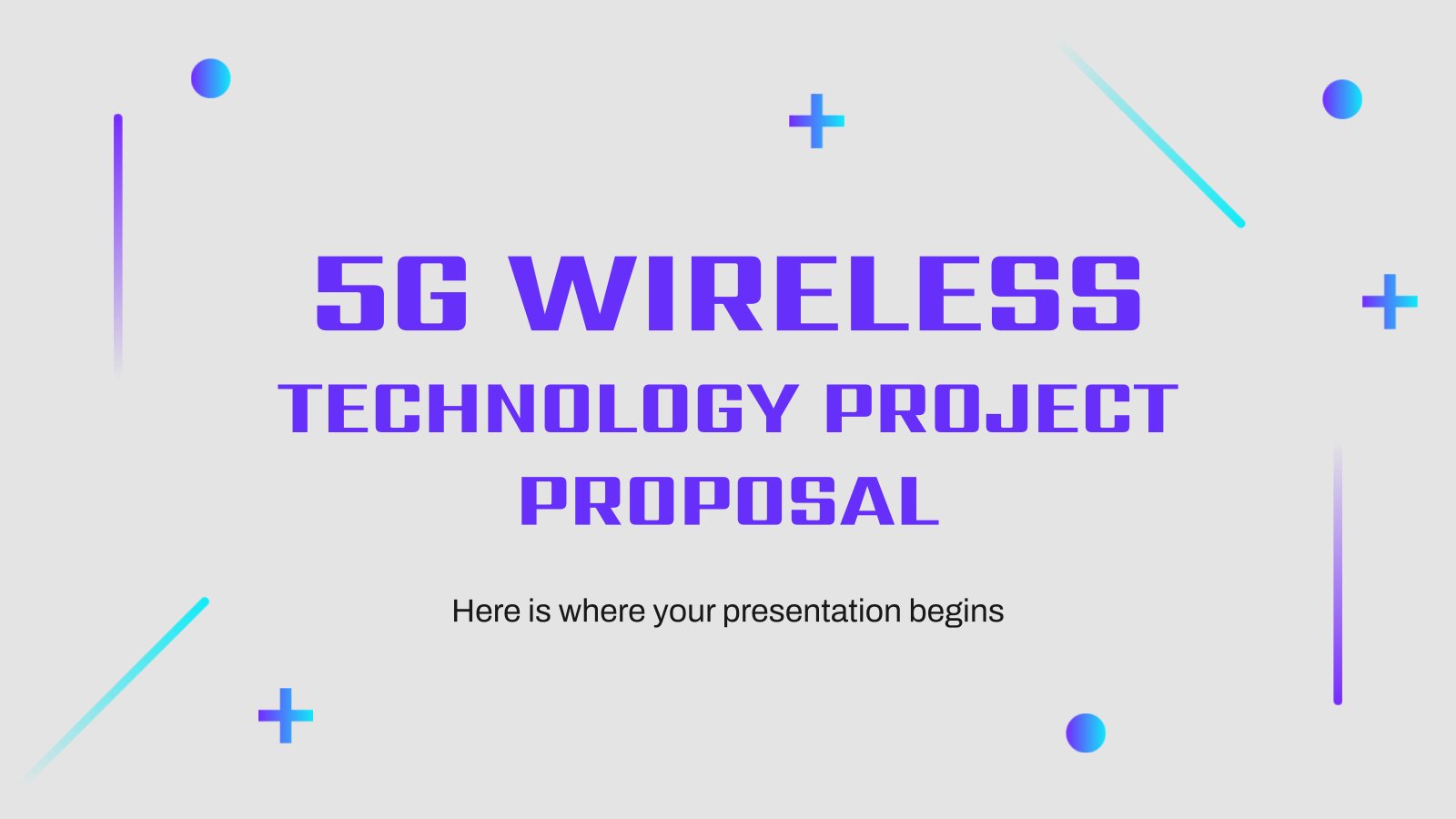
It seems that you like this template!
Create your presentation create personalized presentation content, writing tone, number of slides, premium template.
Unlock this template and gain unlimited access

Register for free and start downloading now
5g wireless technology project proposal.
Download the "5G Wireless Technology Project Proposal" presentation for PowerPoint or Google Slides. A well-crafted proposal can be the key factor in determining the success of your project. It's an opportunity to showcase your ideas, objectives, and plans in a clear and concise manner, and to convince others to invest...
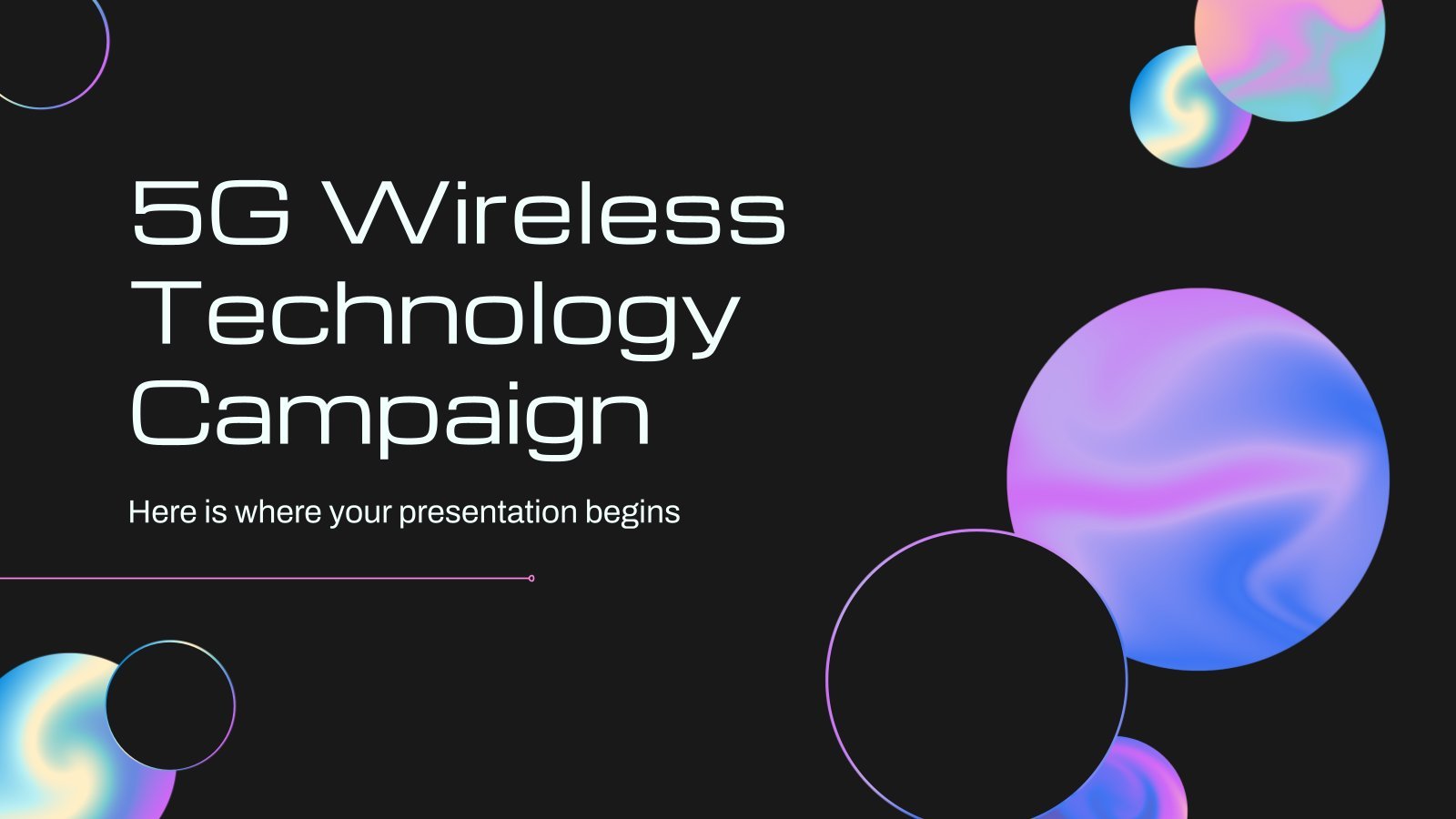
5G Wireless Technology Campaign
Download the "5G Wireless Technology Campaign" presentation for PowerPoint or Google Slides. Improve your campaign management with this template that will definitely make a difference. It will empower you to organize, execute, and track the effectiveness of your campaign. Enriched with innovative resources, it facilitates seamless communication, meticulous planning, and...

5G Wireless Technology Agency
Download the "5G Wireless Technology Agency" presentation for PowerPoint or Google Slides. Your agency is set to reach new heights and milestones. Allow us to accompany you on the journey to success with this all-rounded template. No need for typical sales fluff, this template speaks its cutting-edge design loudly. Display...

5G Wireless Technology Newsletter
Download the "5G Wireless Technology Newsletter" presentation for PowerPoint or Google Slides. Attention all marketers! Are you looking for a way to make your newsletters more creative and eye-catching for your target audience? This amazing template is perfect for creating the perfect newsletter that will capture your audience's attention from...

5G Wireless Technology Pitch Deck
Download the "5G Wireless Technology Pitch Deck" presentation for PowerPoint or Google Slides. Whether you're an entrepreneur looking for funding or a sales professional trying to close a deal, a great pitch deck can be the difference-maker that sets you apart from the competition. Let your talent shine out thanks...

Download the "name" presentation for PowerPoint or Google Slides. Your agency is set to reach new heights and milestones. Allow us to accompany you on the journey to success with this all-rounded template. No need for typical sales fluff, this template speaks its cutting-edge design loudly. Display your vision with...

5G Wireless Technology Company Profile
Download the "5G Wireless Technology Company Profile" presentation for PowerPoint or Google Slides. Presenting a comprehensive company profile can be a game-changer for your business. A well-crafted profile connects with potential clients and vendors on another level, giving them a deep understanding of your organization. This company profile template can...

5G Wireless Technology in Social Media
Download the "5G Wireless Technology in Social Media" presentation for PowerPoint or Google Slides. How do you use social media platforms to achieve your business goals? If you need a thorough and professional tool to plan and keep track of your social media strategy, this fully customizable template is your...

Download the 5G Wireless Technology Pitch Deck presentation for PowerPoint or Google Slides. The education sector constantly demands dynamic and effective ways to present information. This template is created with that very purpose in mind. Offering the best resources, it allows educators or students to efficiently manage their presentations and...

5G Wireless Technology Business Plan
Download the "5G Wireless Technology Business Plan" presentation for PowerPoint or Google Slides. Conveying your business plan accurately and effectively is the cornerstone of any successful venture. This template allows you to pinpoint essential elements of your operation while your audience will appreciate the clear and concise presentation, eliminating any...

- Page 1 of 3
Register for free and start editing online

IMAGES
VIDEO
COMMENTS
Learn how to create business proposal presentations that stand out and win deals with best practices and tips from sales pros. Follow the 11 steps to research, personalize, structure, and design your proposal with Storydoc, a DIY tool that automates branding and design.
Learn how to research, structure and present a winning proposal to your clients with tips and templates from Better Proposals. Find out how to automate your proposal creation, add case studies, end with a call to action and personalize your presentation.
Learn how to craft a compelling storyline, focus on the problem and solution, use visuals and multimedia, and deliver a winning business proposal presentation. This guide provides tips, examples and templates to help you create a persuasive and professional presentation.
Learn the basics of writing and presenting a project proposal, a document that details a new project idea and its objectives, goals, resources and schedule. Find out the common situations that require a project proposal, the types of project proposals, and the steps to follow.
3 Plot your presentation with an audience journey map.. An audience journey map helps you structure your business proposal presentation. It works very much like creating your buyer's journey in that it takes your prospects—in this case, your audience—down your marketing funnel. Each of the four types of audience journey maps commonly used by sales reps helps you deliver your business ...
Learn how to use PowerPoint to create persuasive and professional business proposal presentations. Find tips, templates, and examples to impress your clients and win deals.
Learn how to structure, design, and deliver a winning business proposal presentation to impress your clients. Follow these best practices and see examples of effective slides and agendas.
Learn how to create a compelling business proposal that persuades your client to take action. Follow the key components of a business proposal, such as executive summary, problem statement, solutions, timeline, team, pricing, and testimonials, and use Prezi's presentation platform to enhance your impact.
Learn how to create a persuasive proposal deck with visual examples, expert advice and customizable templates for different industries. A proposal deck is a presentation that outlines your project or business idea, focusing on solutions, strategies, benefits and outcomes.
Tip #3 - Be Adaptable. Not all proposal presentations work alike. Be prepared to adapt your presentation if the situation calls for it, such as if you need to move forward with a Q&A session much sooner than you expected. Flexibility shows professionalism and command of your topic.
Offer a solution and elaborate. Finish with a call-to-action. 7 Tips on How to Present a Business Proposal Presentation. Discuss benefits over features. Practice incessantly and get lots of feedback. Anticipate and incorporate answers to the questions you'll receive. Ask questions throughout to involve the audience.
Create a Gleaming Presentation. A proposal presentation is similar to a job interview. If you're supposed to dress for the job you want, your presentation should be dressed for the business you want to win. A poorly designed proposal presentation can detract from your talking points. A proposal presentation that is haphazardly thrown together ...
Plan, structure, and deliver the perfect proposal presentation to your prospective clients with Miro's template. Customize the slides, add content, get feedback, and present in full screen mode.
3. Structure Your Presentation: Create a well-organized structure for your presentation to maintain clarity and flow. Begin with an engaging introduction, followed by a detailed overview of the project, the problem it aims to solve, proposed solutions, and a compelling conclusion.
Learn how to make business plan presentations in PowerPoint using PPT templates. You'll find out how to create a business proposal fast. Download unlimited...
Learn how to prepare, deliver, and close a business proposal with confidence and effectiveness. Follow 15 steps with pictures, tips, and expert advice on research, visuals, language, and follow-up.
Create a stunning and persuasive business proposal with this template that adapts to your brand and audience. Customize the slides with your project details, objectives, metrics, and team to win over investors, partners, or clients.
Learn how to write a business proposal with 10 steps and 10 sections, including title, table of contents, executive summary, problem statement, solution, team, timeline, cost, terms and decision. See business proposal examples and templates for different scenarios and industries.
Instead of creating a presentation from scratch, you can save time by using a business proposal template — you won't have to fiddle with design and focus too much on structuring the information ...
A project proposal is a document that communicates the goals, objectives, timeline and budget of a project idea. Learn what a project proposal is, what it should include, and see examples and templates to create your own.
Learn how to write a proposal effectively by following a detailed breakdown of each step, from identifying the purpose and audience to submitting and finalizing your proposal. Use a general proposal format and template to structure your proposal and include all the necessary sections and information.
A project proposal is a document that defines the objectives and requirements of a project and aims to get buy-in from stakeholders. Learn the types, structure, tips and examples of project proposals with a free template.
Learn how to create effective consulting presentations with various templates for strategy, market analysis, competitive landscape, and more. Explore examples of McKinsey slides, BCG slides, and other popular consulting deck options.
A project proposal outline aims to clearly explain a project in a way that convinces readers to support it. An effective project proposal outline is essential to strategic planning and influences your company's decision-making process. To create an effective project proposal outline, you must understand the stakeholders' primary goals and ...
Microsoft. Powerpoint presentations are a great way to share information with a team, but making them is a skillset in its own right. We've got guides on general Powerpoint use, but if you're keen ...
Download the "5G Wireless Technology Project Proposal" presentation for PowerPoint or Google Slides. A well-crafted proposal can be the key factor in determining the success of your project. It's an opportunity to showcase your ideas, objectives, and plans in a clear and concise manner, and to convince others to invest...